Circuit for operating a multi-gate VIS/IR photodiode
Na , et al.
U.S. patent number 10,707,260 [Application Number 15/952,088] was granted by the patent office on 2020-07-07 for circuit for operating a multi-gate vis/ir photodiode. This patent grant is currently assigned to Artilux, Inc.. The grantee listed for this patent is Artilux, Inc.. Invention is credited to Chien-Lung Chen, Hui-Wen Chen, Shu-Lu Chen, Szu-Lin Cheng, Kuan-Chen Chu, Che-Fu Liang, Chung-Chih Lin, Han-Din Liu, Yuan-Fu Lyu, Yun-Chung Na.
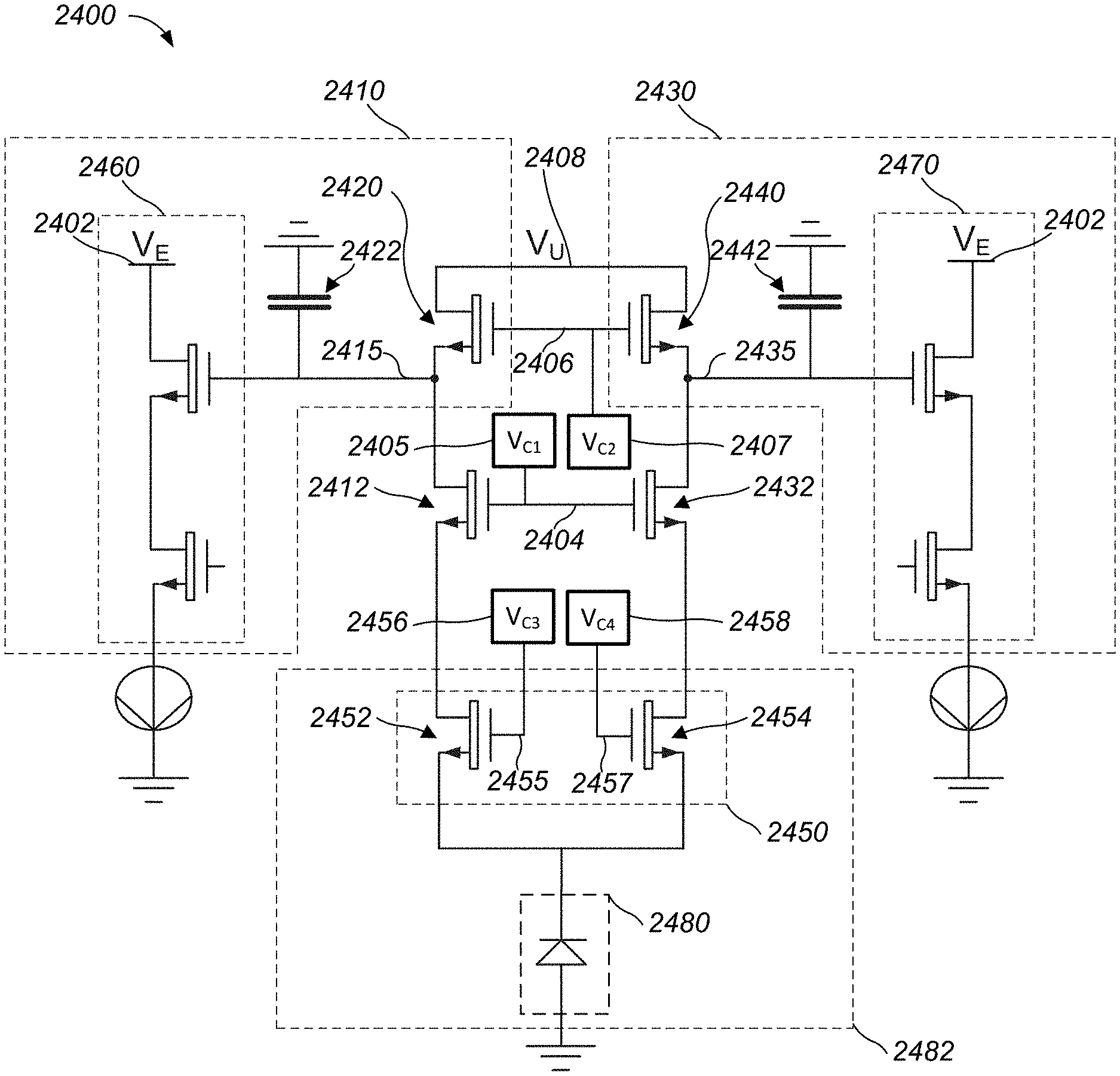
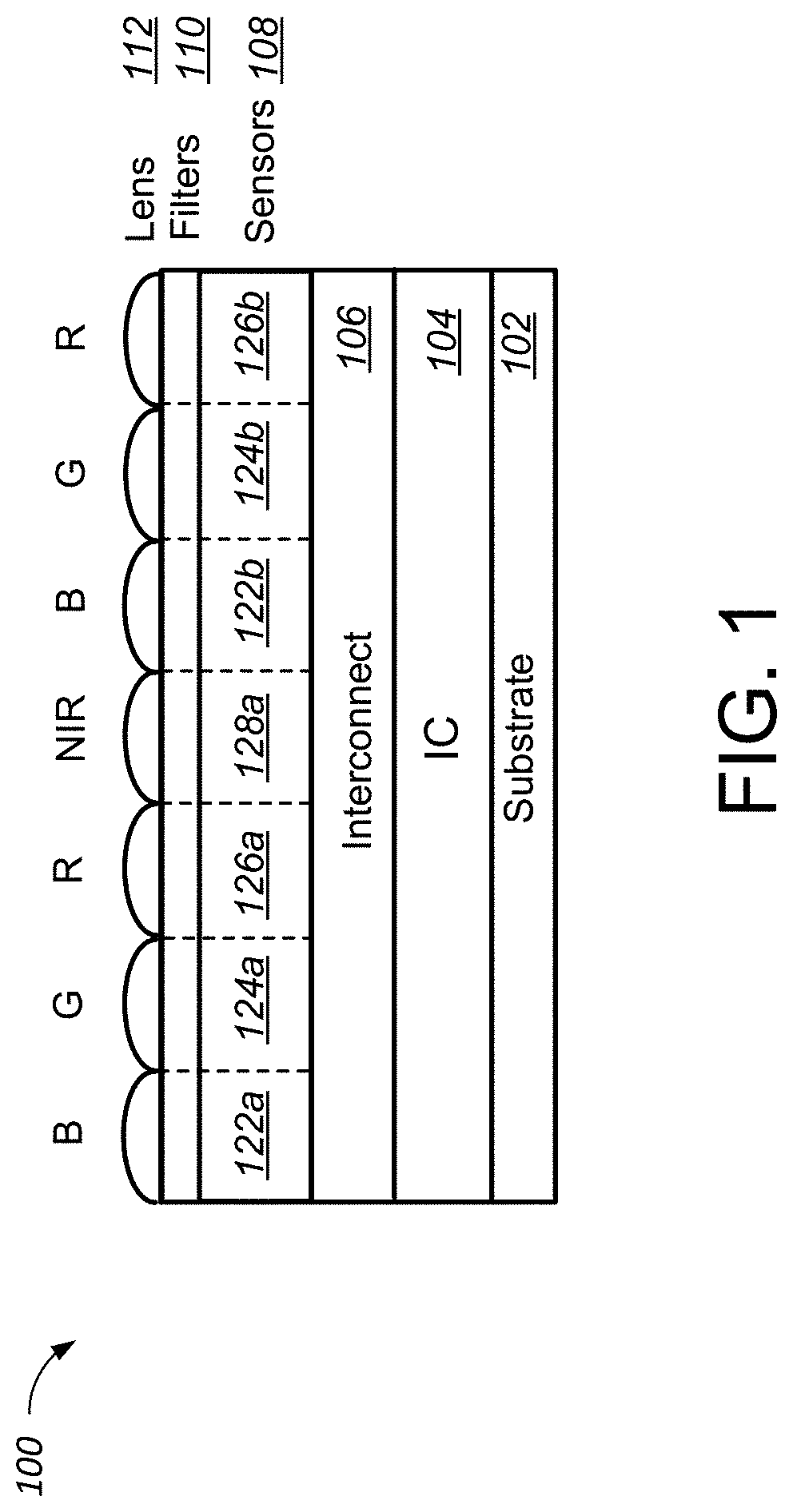
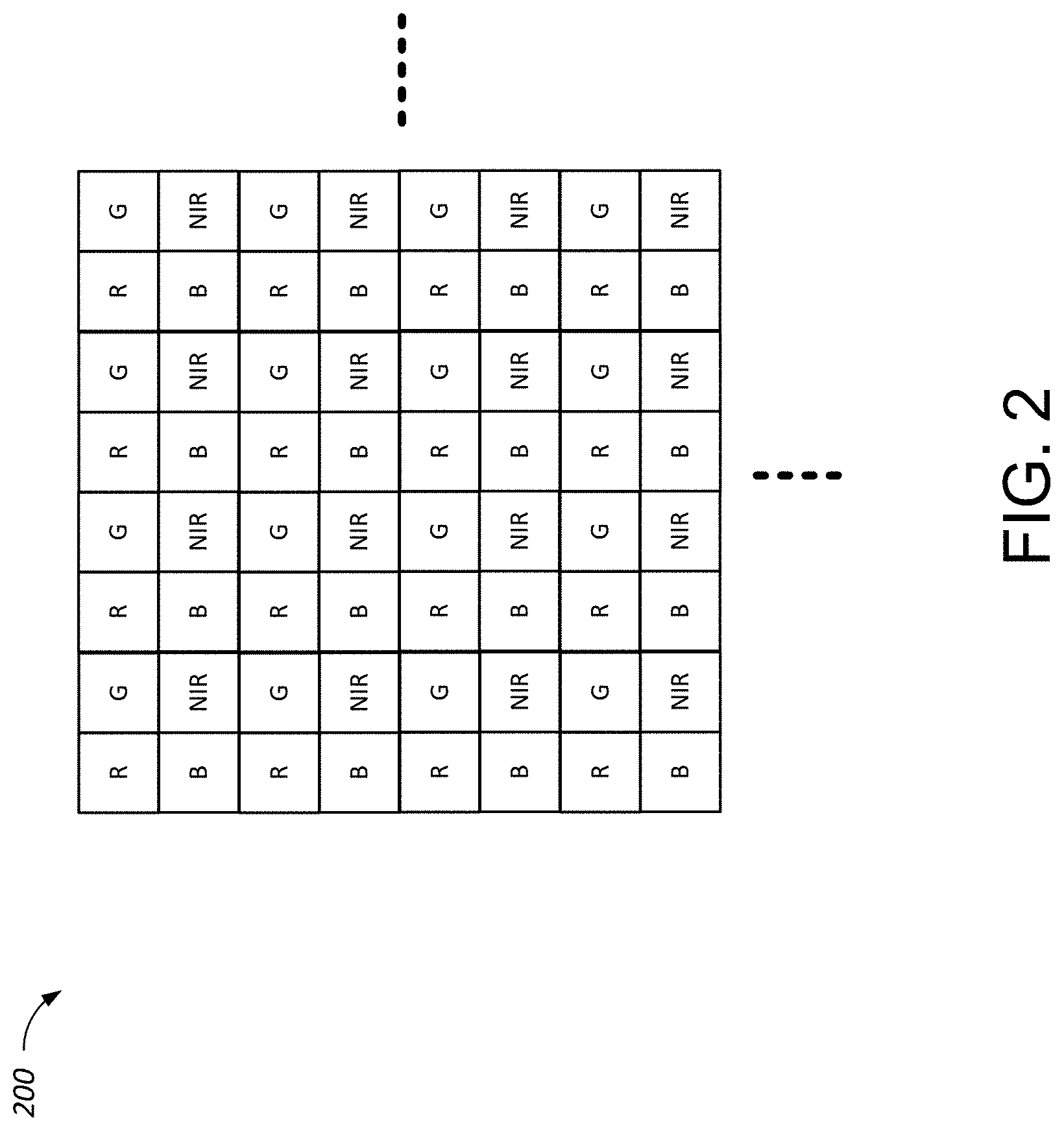
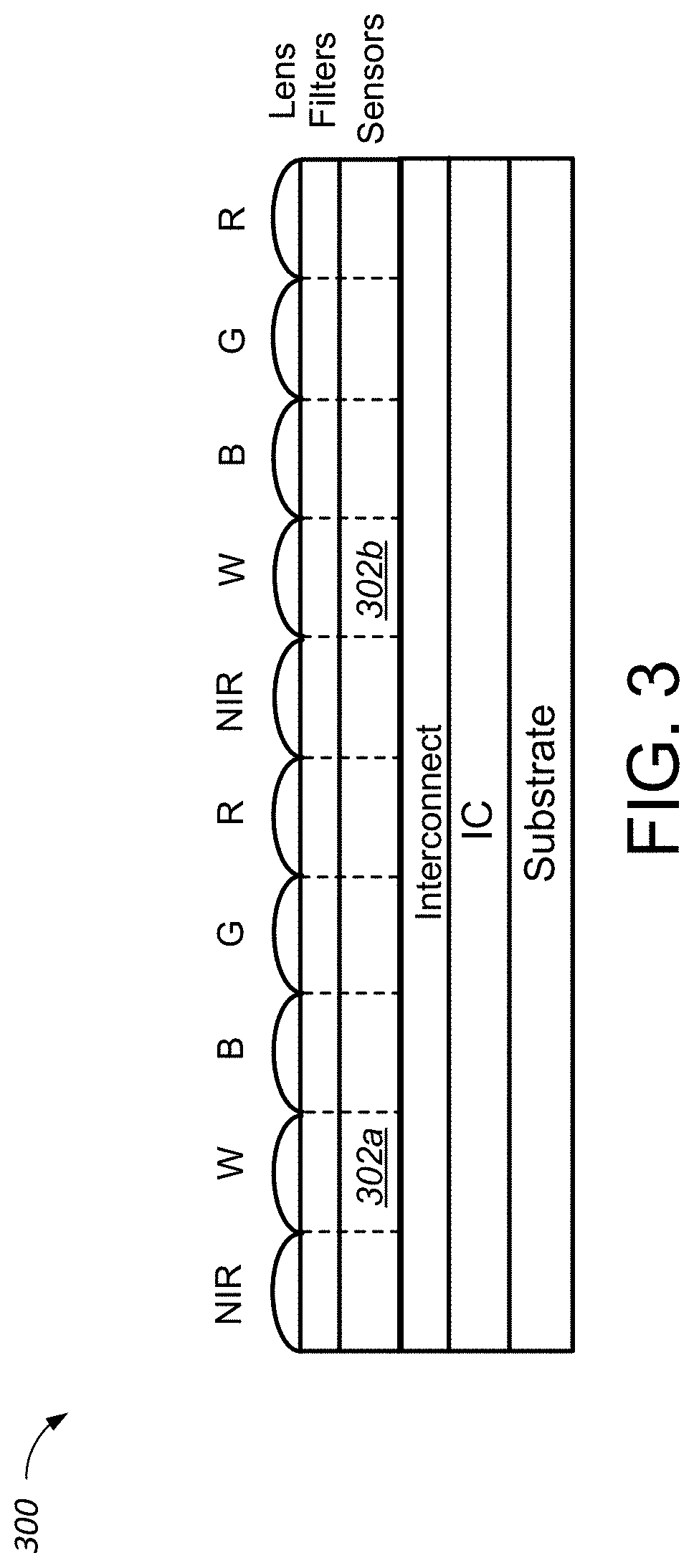
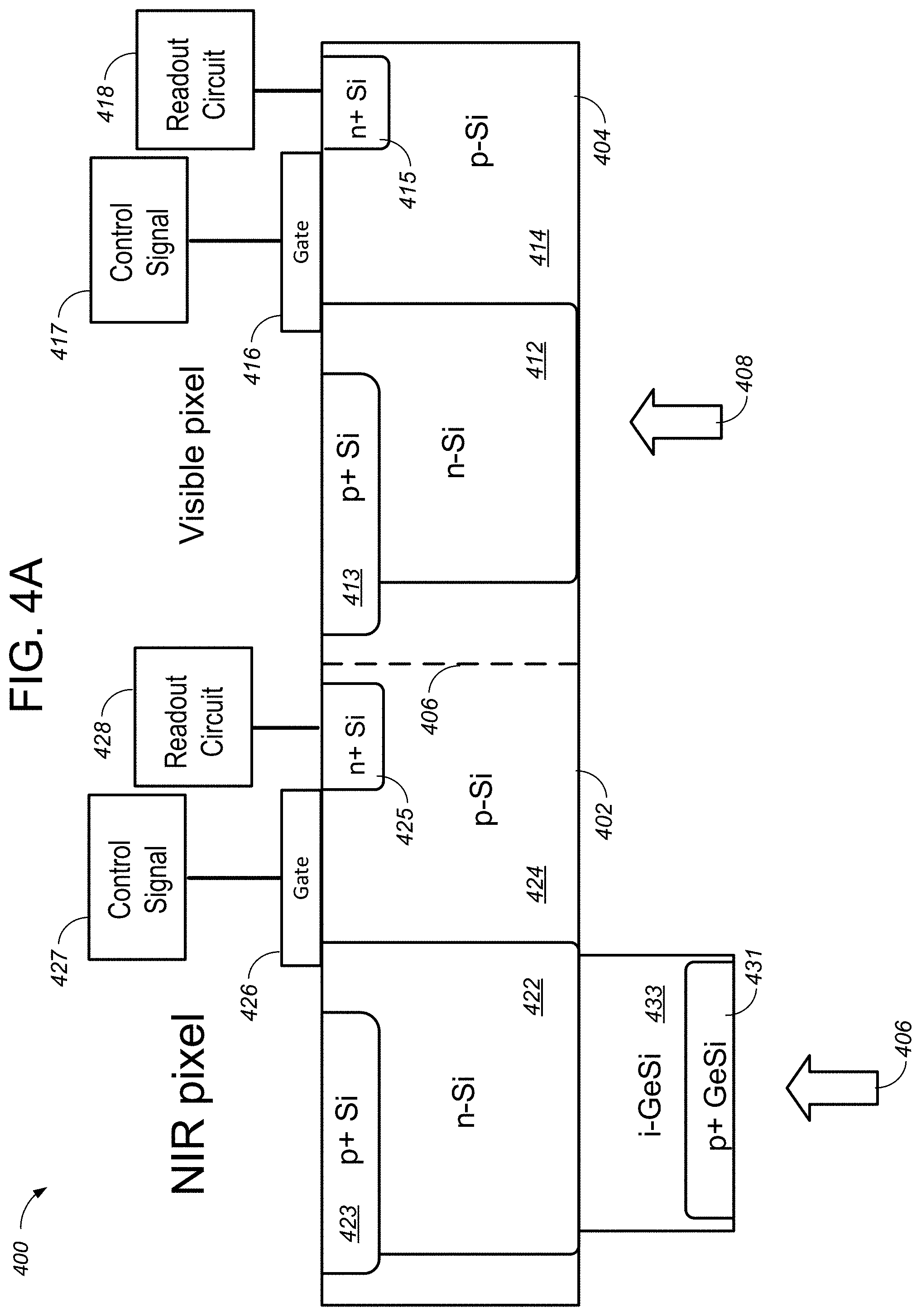
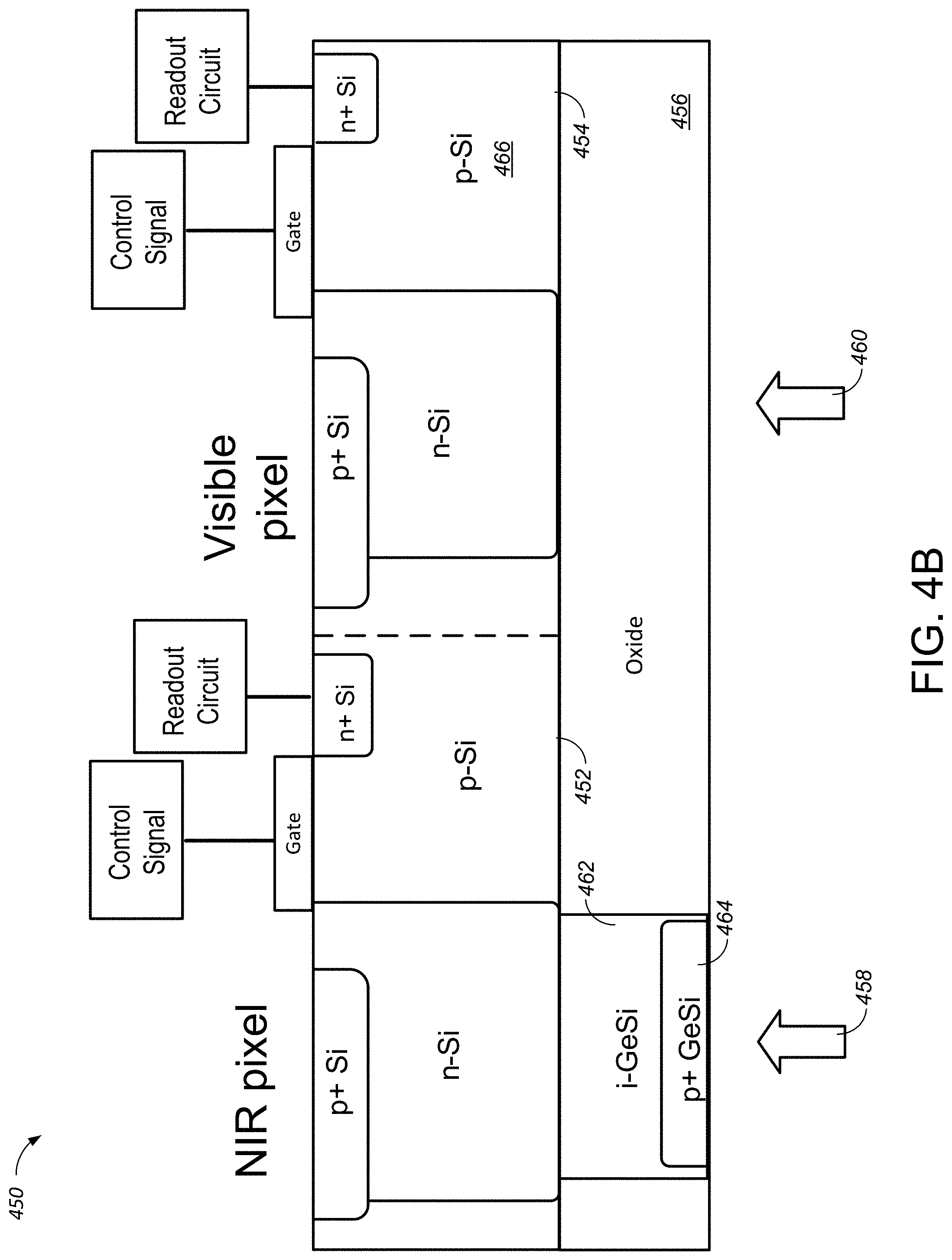
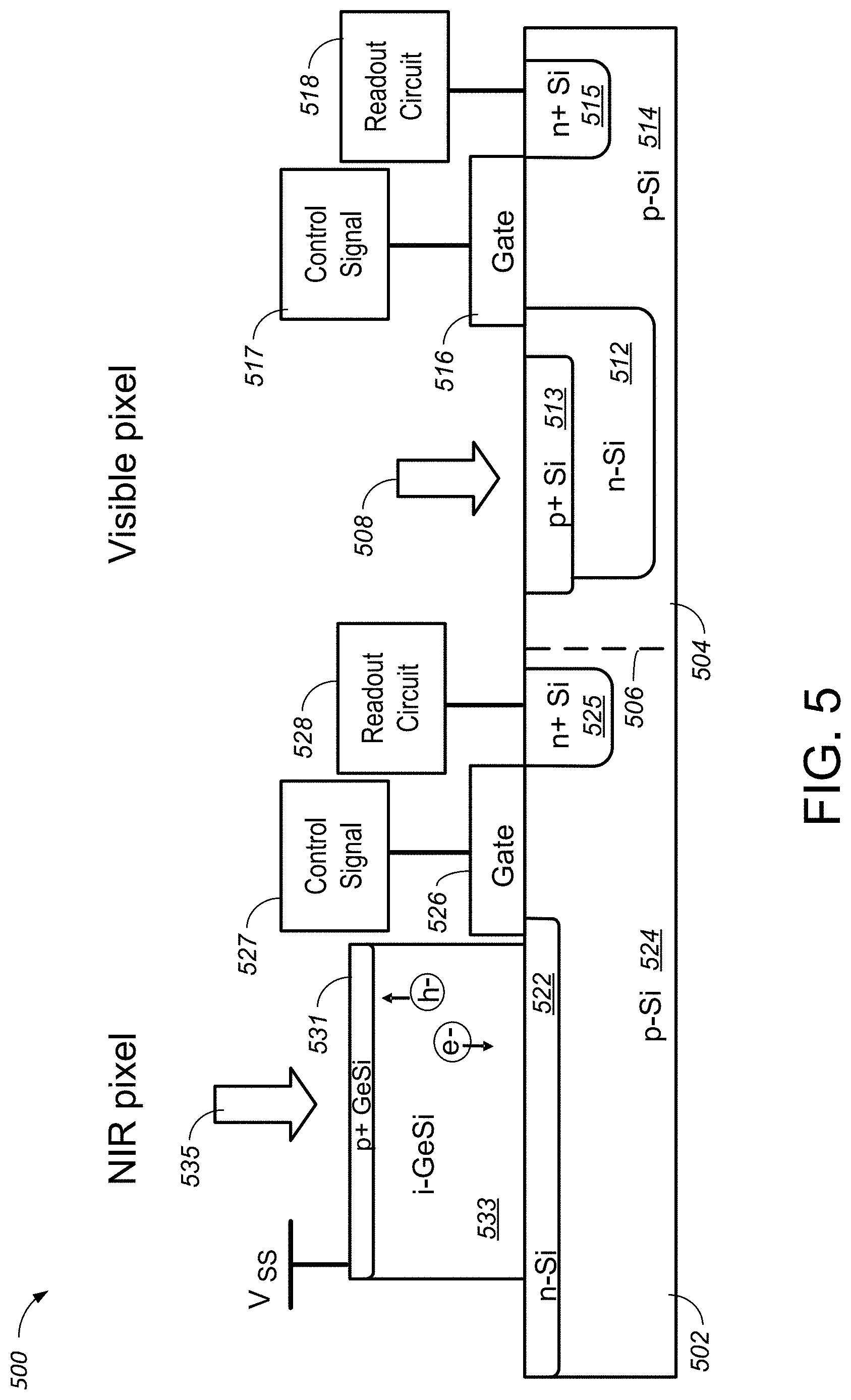
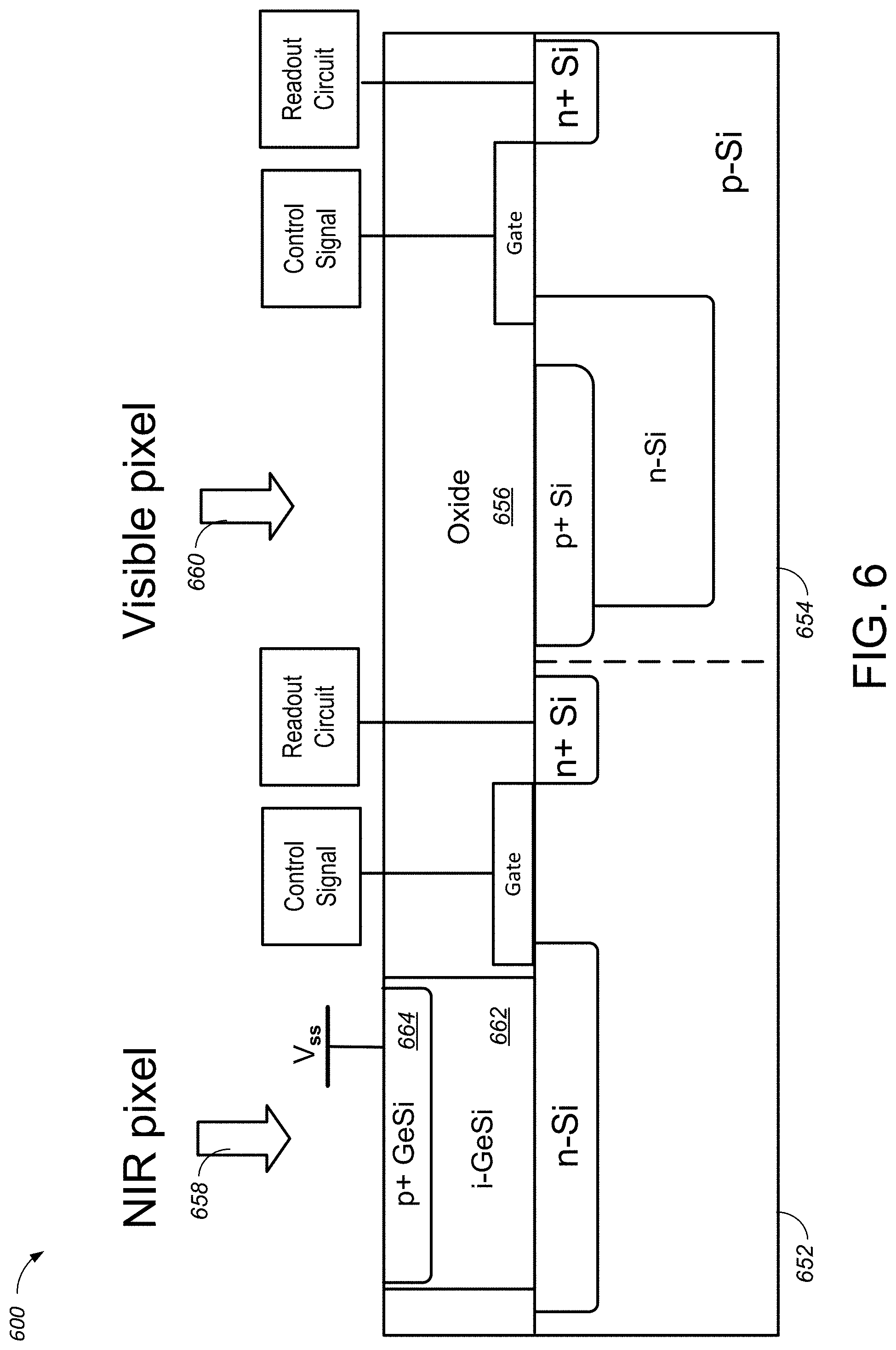
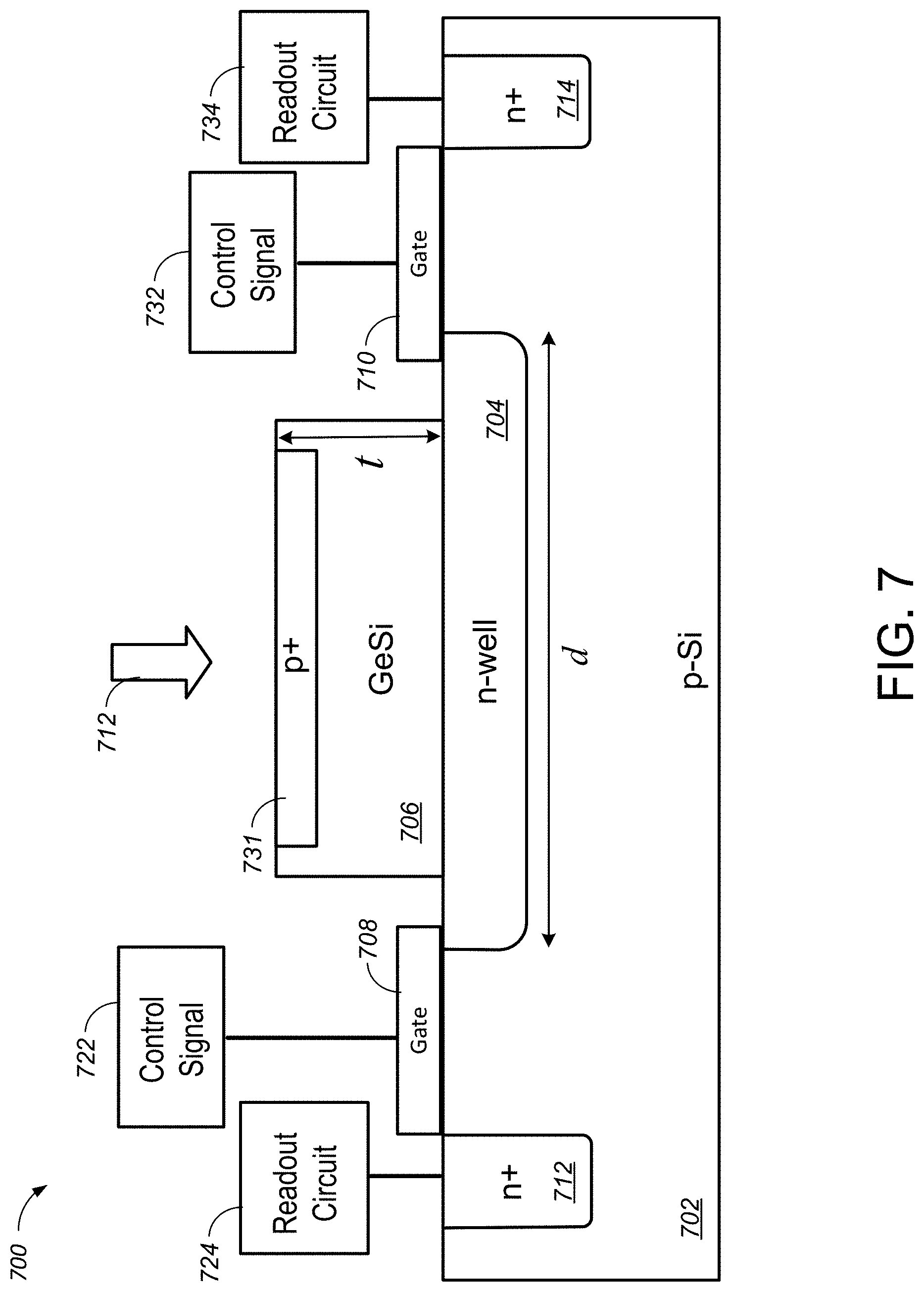
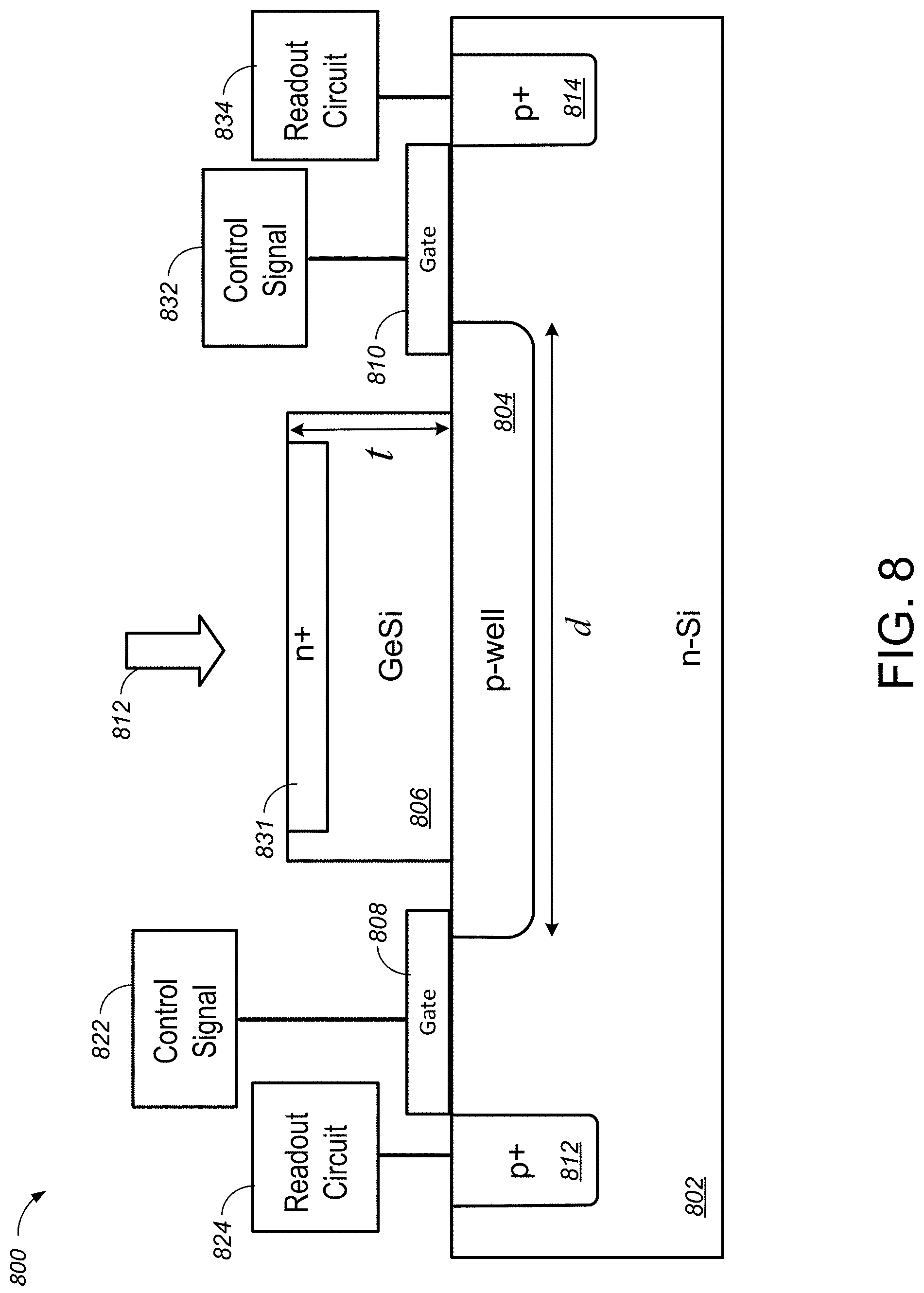
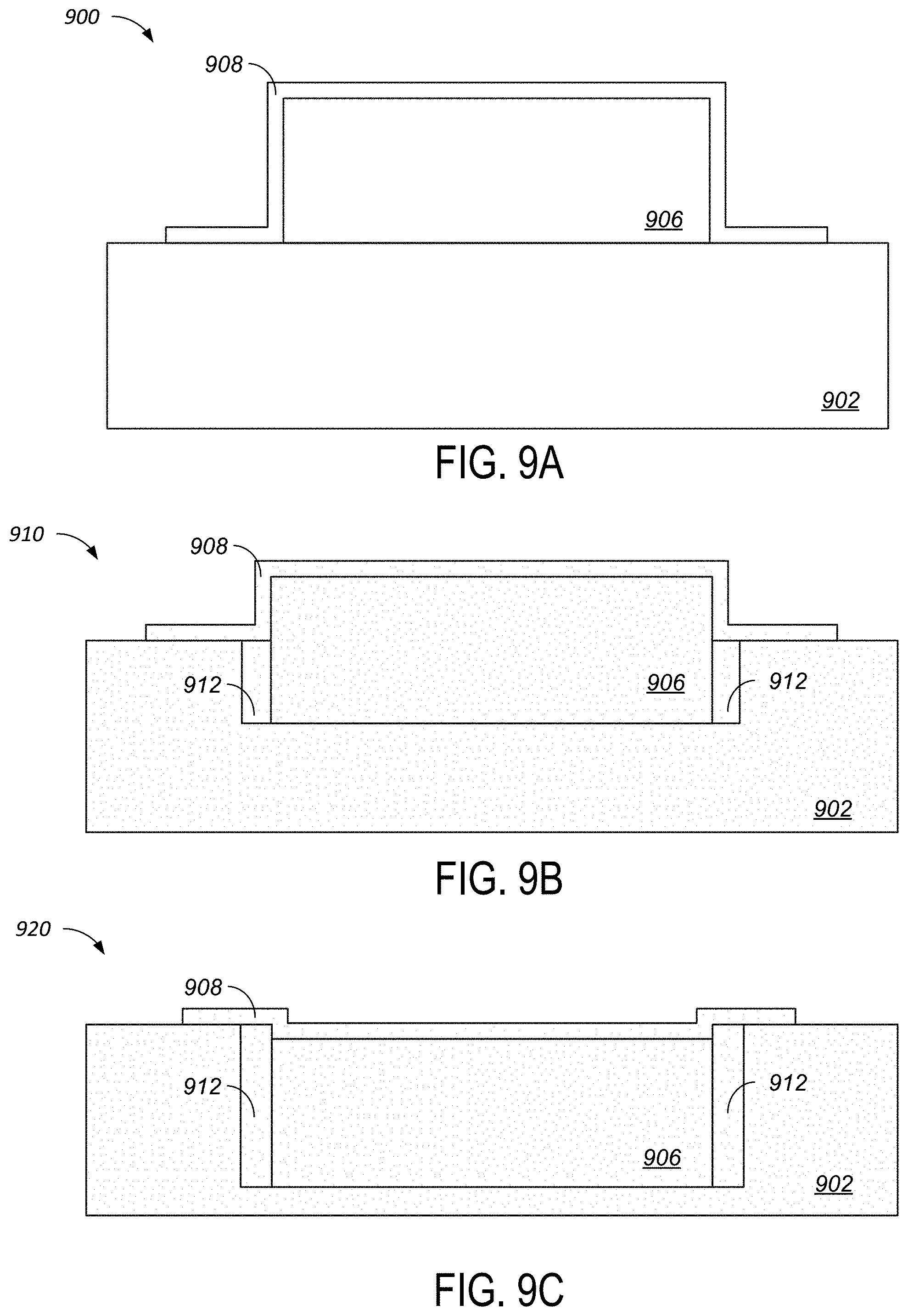
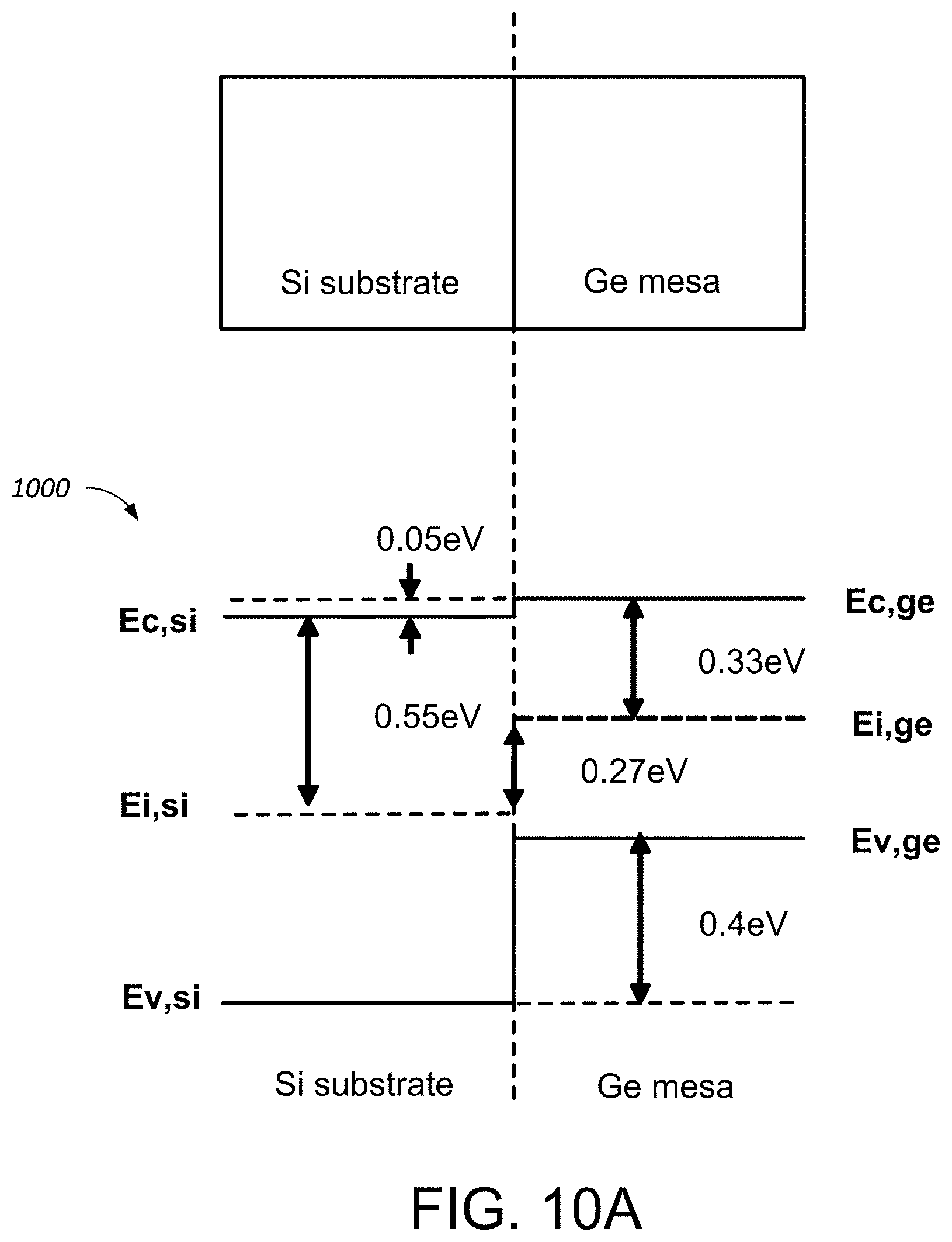
View All Diagrams
| United States Patent | 10,707,260 |
| Na , et al. | July 7, 2020 |
Circuit for operating a multi-gate VIS/IR photodiode
Abstract
A circuit that includes: a photodiode configured to absorb photons and to generate photo-carriers from the absorbed photons; a first MOSFET transistor that includes: a first channel terminal coupled to a first terminal of the photodiode and configured to collect a portion of the photo-carriers generated by the photodiode; a second channel terminal; and a gate terminal coupled to a first control voltage source; a first readout circuit configured to output a first readout voltage; a second readout circuit configured to output a second readout voltage; and a current-steering circuit configured to steer the photo-carriers generated by the photodiode to one or both of the first readout circuit and the second readout circuit.
| Inventors: | Na; Yun-Chung (Zhubei, TW), Cheng; Szu-Lin (Zhubei, TW), Chen; Shu-Lu (Zhubei, TW), Liu; Han-Din (Zhubei, TW), Chen; Hui-Wen (Zhubei, TW), Liang; Che-Fu (Zhubei, TW), Lyu; Yuan-Fu (Taoyuan, TW), Chen; Chien-Lung (Taoyuan, TW), Lin; Chung-Chih (Zhubei, TW), Chu; Kuan-Chen (Zhubei, TW) | ||||||||||
|---|---|---|---|---|---|---|---|---|---|---|---|
| Applicant: |
|
||||||||||
| Assignee: | Artilux, Inc. (Menlo Park,
CA) |
||||||||||
| Family ID: | 63105380 | ||||||||||
| Appl. No.: | 15/952,088 | ||||||||||
| Filed: | April 12, 2018 |
Prior Publication Data
| Document Identifier | Publication Date | |
|---|---|---|
| US 20180233528 A1 | Aug 16, 2018 | |
Related U.S. Patent Documents
| Application Number | Filing Date | Patent Number | Issue Date | ||
|---|---|---|---|---|---|
| 15228282 | Aug 4, 2016 | 9954016 | |||
| 62271386 | Dec 28, 2015 | ||||
| 62251691 | Nov 6, 2015 | ||||
| 62217031 | Sep 11, 2015 | ||||
| 62211004 | Aug 28, 2015 | ||||
| 62210991 | Aug 28, 2015 | ||||
| 62210946 | Aug 27, 2015 | ||||
| 62209349 | Aug 25, 2015 | ||||
| 62200652 | Aug 4, 2015 | ||||
| 62500457 | May 2, 2017 | ||||
| 62504531 | May 10, 2017 | ||||
| 62583854 | Nov 9, 2017 | ||||
| 62485003 | Apr 13, 2017 | ||||
| 62561266 | Sep 21, 2017 | ||||
| 62613054 | Jan 3, 2018 | ||||
| 62542329 | Aug 8, 2017 | ||||
| 62643295 | Mar 15, 2018 | ||||
| 62651085 | Mar 31, 2018 | ||||
| Current U.S. Class: | 1/1 |
| Current CPC Class: | H01L 31/102 (20130101); H01L 31/075 (20130101); H01L 31/035272 (20130101); H01L 31/103 (20130101); H01L 27/14643 (20130101); H01L 31/109 (20130101); H01L 31/0376 (20130101); H01L 31/0352 (20130101); H04N 1/1931 (20130101); Y02E 10/548 (20130101) |
| Current International Class: | H01L 27/146 (20060101); H01L 31/109 (20060101); H01L 31/075 (20120101); H01L 31/102 (20060101); H01L 31/0376 (20060101); H01L 31/0352 (20060101); H01L 31/103 (20060101); H04N 1/193 (20060101) |
References Cited [Referenced By]
U.S. Patent Documents
| 3621466 | November 1971 | Toshio |
| 4341918 | July 1982 | Evans, Jr. et al. |
| 4604527 | August 1986 | Chenevas-Paula et al. |
| 4607168 | August 1986 | Oritsuki et al. |
| 4767936 | August 1988 | Muakami et al. |
| 4782376 | November 1988 | Catalano |
| 4926231 | May 1990 | Hwang et al. |
| 5453611 | September 1995 | Oozu |
| 5673284 | September 1997 | Congdon et al. |
| 5965875 | October 1999 | Merrill |
| 6384462 | May 2002 | Pauchard et al. |
| 6483130 | November 2002 | Yang et al. |
| 6894267 | May 2005 | Kakinuma |
| 6958194 | October 2005 | Hopper |
| 7090133 | August 2006 | Zhu |
| 7411265 | August 2008 | Sekiguchi |
| 7456874 | November 2008 | Ono |
| 7557368 | July 2009 | Hegarty et al. |
| 7629661 | December 2009 | Rafferty et al. |
| 7750958 | July 2010 | Dierickx |
| 7826058 | November 2010 | Ulrich et al. |
| 7884310 | February 2011 | Buettgen |
| 7961301 | July 2011 | Emhart et al. |
| 7972885 | July 2011 | Dutta et al. |
| 8129813 | March 2012 | Herz |
| 8183510 | May 2012 | Venezia et al. |
| 8405823 | March 2013 | Pfaff |
| 8824779 | September 2014 | Smyth |
| 8860083 | October 2014 | Trezza |
| 8975668 | March 2015 | Costello et al. |
| 9236520 | January 2016 | Okhonin |
| 9239626 | January 2016 | Wu et al. |
| 9472588 | October 2016 | Liu et al. |
| 9635351 | April 2017 | Dielacher et al. |
| 9748429 | August 2017 | Davids et al. |
| 9786715 | October 2017 | Na et al. |
| 9893112 | February 2018 | Na et al. |
| 10418407 | September 2019 | Na et al. |
| 2003/0042500 | March 2003 | Rhodes et al. |
| 2003/0189159 | October 2003 | Lnoue |
| 2004/0121507 | June 2004 | Bude et al. |
| 2005/0077588 | April 2005 | Kasuga |
| 2005/0167709 | August 2005 | Augusto |
| 2005/0186759 | August 2005 | So |
| 2005/0233495 | October 2005 | Yang et al. |
| 2006/0110844 | May 2006 | Lee et al. |
| 2006/0289957 | December 2006 | Morse et al. |
| 2007/0164767 | July 2007 | Herz |
| 2007/0187796 | August 2007 | Rafferty et al. |
| 2007/0218578 | September 2007 | Lee et al. |
| 2007/0218580 | September 2007 | Hsu et al. |
| 2008/0121866 | May 2008 | Yuan et al. |
| 2008/0157254 | July 2008 | Kang |
| 2008/0181452 | July 2008 | Kwon et al. |
| 2008/0303058 | December 2008 | Mori et al. |
| 2009/0050891 | February 2009 | Katoh |
| 2009/0152604 | June 2009 | Zhu et al. |
| 2009/0166684 | July 2009 | Yahav et al. |
| 2009/0200589 | August 2009 | Qian et al. |
| 2009/0237770 | September 2009 | Kim et al. |
| 2009/0242935 | October 2009 | Fitzgerald |
| 2010/0078680 | April 2010 | Cheng et al. |
| 2010/0102409 | April 2010 | Hansson |
| 2010/0184246 | July 2010 | Sakai |
| 2011/0031578 | February 2011 | Miura et al. |
| 2011/0102553 | May 2011 | Corcoran et al. |
| 2011/0109880 | May 2011 | Nummela |
| 2011/0128430 | June 2011 | Fossum |
| 2011/0155893 | June 2011 | Endo et al. |
| 2011/0181591 | July 2011 | Benitez |
| 2011/0188780 | August 2011 | Wang et al. |
| 2011/0255071 | October 2011 | Van Der Tempel |
| 2011/0304696 | December 2011 | Centen et al. |
| 2012/0080726 | April 2012 | Sakano |
| 2012/0133922 | May 2012 | Pfaff |
| 2012/0241769 | September 2012 | Katoh |
| 2012/0248514 | October 2012 | Korekado et al. |
| 2012/0287085 | November 2012 | Yuki et al. |
| 2012/0307232 | December 2012 | Mase |
| 2013/0026548 | January 2013 | McCarten |
| 2013/0062506 | March 2013 | Hu |
| 2013/0062522 | March 2013 | Jiang et al. |
| 2013/0062663 | March 2013 | Yuan et al. |
| 2013/0075607 | March 2013 | Bikumandla et al. |
| 2013/0119234 | May 2013 | Lee et al. |
| 2013/0128070 | May 2013 | Ishikawa |
| 2013/0154918 | June 2013 | Vaught et al. |
| 2013/0248865 | September 2013 | Toriyama et al. |
| 2013/0278631 | October 2013 | Border et al. |
| 2013/0280879 | October 2013 | Stecher et al. |
| 2013/0283213 | October 2013 | Guendelman |
| 2013/0321271 | December 2013 | Bychkov |
| 2014/0002700 | January 2014 | Oishi |
| 2014/0043227 | February 2014 | Skogo et al. |
| 2014/0054444 | February 2014 | Sasaki |
| 2014/0054736 | February 2014 | Meade et al. |
| 2014/0111664 | April 2014 | Kumano |
| 2014/0117428 | May 2014 | Lee et al. |
| 2014/0159129 | June 2014 | Wang |
| 2014/0183549 | July 2014 | Park et al. |
| 2014/0184496 | July 2014 | Gribetz et al. |
| 2014/0206443 | July 2014 | Sharp et al. |
| 2014/0252437 | September 2014 | Ho et al. |
| 2014/0285404 | September 2014 | Takano et al. |
| 2014/0285420 | September 2014 | Kamimura et al. |
| 2014/0285641 | September 2014 | Kato et al. |
| 2014/0312206 | October 2014 | Okhonin et al. |
| 2014/0367740 | December 2014 | Morse |
| 2014/0368613 | December 2014 | Krupka |
| 2015/0001664 | January 2015 | Van Der Tempel |
| 2015/0014661 | January 2015 | Joo et al. |
| 2015/0022435 | January 2015 | Luebke |
| 2015/0041761 | February 2015 | Cheng et al. |
| 2015/0043826 | February 2015 | Ishimitsu |
| 2015/0092983 | April 2015 | Nguyen et al. |
| 2015/0171146 | June 2015 | Ooki et al. |
| 2015/0193938 | July 2015 | Freedman et al. |
| 2015/0281618 | October 2015 | Saito |
| 2015/0286340 | October 2015 | Send et al. |
| 2015/0331508 | November 2015 | Nho et al. |
| 2016/0027837 | January 2016 | Webster et al. |
| 2016/0049476 | February 2016 | Rachmady et al. |
| 2016/0141329 | May 2016 | Cheng et al. |
| 2016/0150174 | May 2016 | Hynecek |
| 2016/0155883 | June 2016 | Shi et al. |
| 2016/0161599 | June 2016 | Seliuchenko et al. |
| 2016/0172393 | June 2016 | Kim et al. |
| 2016/0187976 | June 2016 | Levesque et al. |
| 2016/0190304 | June 2016 | Morin et al. |
| 2016/0225922 | August 2016 | Akkaya et al. |
| 2016/0239974 | August 2016 | Wang |
| 2016/0284750 | September 2016 | Ionescu et al. |
| 2016/0316159 | October 2016 | Yoneda |
| 2016/0335475 | November 2016 | Krenzer et al. |
| 2016/0372502 | December 2016 | Li et al. |
| 2016/0381789 | December 2016 | Rogers et al. |
| 2017/0040361 | February 2017 | Canon |
| 2017/0040362 | February 2017 | Na et al. |
| 2017/0062508 | March 2017 | Na et al. |
| 2017/0068319 | March 2017 | Viswanathan |
| 2017/0075421 | March 2017 | Na et al. |
| 2017/0084648 | March 2017 | Liu et al. |
| 2017/0123233 | May 2017 | Sabovic |
| 2017/0131389 | May 2017 | Na et al. |
| 2017/0142362 | May 2017 | Liu |
| 2017/0177075 | June 2017 | Zhang |
| 2017/0196451 | July 2017 | Tian |
| 2017/0221212 | August 2017 | Adam et al. |
| 2017/0223339 | August 2017 | Kondo et al. |
| 2017/0237911 | August 2017 | Won |
| 2017/0244949 | August 2017 | Peterson |
| 2018/0006081 | January 2018 | Na et al. |
| 2018/0007255 | January 2018 | Tang |
| 2018/0012916 | January 2018 | Na et al. |
| 2018/0012917 | January 2018 | Na et al. |
| 2018/0012918 | January 2018 | Na et al. |
| 2018/0061883 | March 2018 | Na et al. |
| 2018/0137610 | May 2018 | Aflaki |
| 2018/0151732 | May 2018 | Mehandru |
| 2018/0175084 | June 2018 | Na et al. |
| 2018/0175095 | June 2018 | Sallin |
| 2018/0188356 | July 2018 | Na et al. |
| 2018/0190698 | July 2018 | Na et al. |
| 2018/0190702 | July 2018 | Na et al. |
| 2018/0233521 | August 2018 | Na et al. |
| 2018/0247968 | August 2018 | Na et al. |
| 2018/0261645 | September 2018 | Na et al. |
| 2018/0269239 | September 2018 | Na et al. |
| 2019/0011984 | January 2019 | Na et al. |
| 2019/0033432 | January 2019 | Na et al. |
| 2019/0049564 | February 2019 | Na et al. |
| 2019/0081095 | March 2019 | Hanzawa |
| 2019/0103435 | April 2019 | Na et al. |
| 2224319 | Sep 2010 | EP | |||
| 2330637 | Jun 2011 | EP | |||
| H0548139 | Feb 1993 | JP | |||
| 2000-133791 | May 2000 | JP | |||
| 2003-225207 | Aug 2003 | JP | |||
| 2004-103964 | Apr 2004 | JP | |||
| 2004-309701 | Nov 2004 | JP | |||
| 2005-123674 | May 2005 | JP | |||
| 2009-025225 | Feb 2009 | JP | |||
| 2009-047658 | Mar 2009 | JP | |||
| 2011-66097 | Mar 2011 | JP | |||
| 2011-128024 | Jun 2011 | JP | |||
| 2012-146920 | Aug 2012 | JP | |||
| 2015-194838 | Nov 2015 | JP | |||
| WO 2005/036647 | Apr 2005 | WO | |||
| WO 2013-104718 | Jul 2013 | WO | |||
| WO 2014-085789 | Jun 2014 | WO | |||
| WO 2014-197226 | Dec 2014 | WO | |||
| WO 2015-104307 | Jul 2015 | WO | |||
| WO 2016/038416 | Mar 2016 | WO | |||
| WO 2016/077791 | May 2016 | WO | |||
| WO2016/187566 | Nov 2016 | WO | |||
| WO 2016/208215 | Dec 2016 | WO | |||
| WO 2017/015580 | Jan 2017 | WO | |||
| WO 2017/018477 | Feb 2017 | WO | |||
| WO 2017/024121 | Feb 2017 | WO | |||
| WO 2017/035447 | Mar 2017 | WO | |||
Other References
|
Alsam et al: "What the Eye Did Not See--A Fusion Approach to Image Coding", Advances in Visual Computing, dated Jan. 1, 2012, pp. 199-208 (with partial english translation). cited by applicant . EP Search Report in European Application No. EP18189000, dated Jan. 9, 2019, 17 pages. cited by applicant . Zanuttigh et al: "ToF Depth Camera Components", Time-of-Flight and Structured Light Depth Cameras: Technology and Applications, dated May 24, 2016, pp. 31-33. cited by applicant . International Search Report and Written Opinion in International Application No. PCT/US2016/043609, dated Nov. 1, 2016, 21 pages. cited by applicant . International Search Report and Written Opinion in International Application No. PCT/US2016/045526, dated Nov. 22, 2016, 15 pages. cited by applicant . International Search Report and Written Opinion in International Application No. PCT/US2016/048915, dated Nov. 22, 2016, 17 pages. cited by applicant . International Search Report and Written Opinion in International Application No. PCT/US2016/060493, dated Jan. 10, 2017, 20 pages. cited by applicant . International Search Report and Written Opinion in International Application No. PCT/US2016/066073, dated Mar. 7, 2017, 16 pages. cited by applicant . International Preliminary Report on Patentability in International Application No. PCT/US2016/043609, dated Jan. 23, 2018, 12 pages. cited by applicant . International Preliminary Report on Patentability in International Application No. PCT/US2016/045526, dated Feb. 6, 2018, 10 pages. cited by applicant . International Preliminary Report on Patentability in International Application No. PCT/US2016/048915, dated Feb. 27, 2018, 8 pages. cited by applicant . Bamji et al., "A 0.13 .mu.m CMOS System-on-Chip for a 512 .times. 424 Time-of-Flight Image Sensor With Multi-Frequency Photo-Demodulation up to 130 MHz and 2 GS/s ADC," IEEE J. Solid-State Circuits, Jan. 2015, 50(1):303-319. cited by applicant . Bianco et al., "A Comparative Analysis between Active and Passive Techniques for Underwater 3D Reconstruction of Close-Range Objects," Sensors, Aug. 20, 2013, 13(8):11007-11031. cited by applicant . Chen et al., "Self-Aligned Microbonded Germanium Metal-Semiconductor-Metal Photodetectors Butt-Coupled to Si Waveguides," IEEE J. Sel. Top. Quant. Electron. Nov. 2014, 20(6):3800605, 5 pages. cited by applicant . Dalla Betta et al., "Design and Characterization of Current-Assisted Photonic Demodulators in 0.18-.mu.m CMOS Technology," IEEE Trans. Electron. Dev., Jun. 2011, 58(6):1702-1709. cited by applicant . Feng et al., "Vertical p-i-n germanium photodetector with high external responsivity integrated with large core Si waveguides," Optics Express, Jan. 4, 2010, 18(1):96-101. cited by applicant . Foix et al., "Lock-in Time-of-Flight (ToF) Cameras: A Survey," IEEE Sensors J., Sep. 2011, 11(9):1917-1926. cited by applicant . Geng, "Structured-light 3D surface imaging: A tutorial," Advances in Optics and Photonics, Jun. 30, 2011, 3(2):128-160. cited by applicant . Joo et al., "High-sensitivity 10 Gbps Ge-on-Si photoreceiver operating at .lamda..about.1.55 pm," Optics Express, Aug. 2, 2010, 18(16):16474-16479. cited by applicant . Kato et al., "320 .times. 240 Back-Illuminated 10-.mu.m CAPD Pixels for High-Speed Modulation Time-of-Flight CMOS Image Sensor," IEEE J. Solid-State Circuits Apr. 2018, 53(4):1071-1078. cited by applicant . Kawahito et al., "A CMOS Time-of-Flight Range Image Sensor With Gates-on-Field-Oxide Structure," IEEE Sensors J. Dec. 2007, 7(12):1578-1586. cited by applicant . Kim et al., "A Three-Dimensional Time-of-Flight CMOS Image Sensor With Pinned-Photodiode Pixel Structure," IEEE Electron. Dev. Lett., Nov. 2010, 31(11):1272-1274. cited by applicant . Koester et al., "Ge-on-SOI-Detector/Si-CMOS-Amplifier Receivers for High-Performance Optical-Communication Applications," J. Lightw. Technol., Jan. 2001, 25(1):46-57. cited by applicant . Lange et al., "Solid-State Time-of-Flight Range Camera," IEEE J. Quant. Electron. Mar. 2001, 37(3):390-397. cited by applicant . Li et al., "High-Bandwidth and High-Responsivity Top-Illuminated Germanium Photodiodes for Optical Interconnection," IEEE Trans. Electron Dev., Mar. 2013, 60(3):1183-1187. cited by applicant . Lischke et al., "High bandwidth, high responsivity waveguide-coupled germanium p-i-n photodiode," Optics Express, Oct. 19, 2015, 23(21):27213-27220. cited by applicant . Liu et al., "Backside-incidence critically coupled Ge on SOI photodetector," Proc. SPIE 10100, Optical Components and Materials, Feb. 16, 2017, XIV, 101001X, 6 pages. cited by applicant . Michel et al., "High-performance Ge-on-Si photodetectors," Nature Photon. Jul. 30, 2010, 4:527-534. cited by applicant . Morse et al., "Performance of Ge-on-Si p-i-n Photodetectors for Standard Receiver Modules," IEEE Photon. Technol. Lett., Dec. 1, 2006, 18(23):2442-2444. cited by applicant . Perenzoni et al., "Compact SPAD-Based Pixel Architectures for Time-Resolved Image Sensors," Sensors, May 23, 2016, 16(5):745, 12 pages. cited by applicant . Rafferty et a., "Monolithic germanium SWIR imaging array," 2008 IEEE Conference on Technologies for Homeland Security, Waltham, MA, May 12, 2008, p. 577-582. cited by applicant . Ringbeck et al., "Multidimensional measurement by using 3-D PMD sensors," Adv. Radio Sci., Jan. 1, 2007, 5:135-146. cited by applicant . Tseng et al., "A self-assembled microbonded germanium/silicon heterojunction photodiode for 25 Gb/s high-speed optical interconnects," Sci. Rep. Nov. 15, 2013, 3:3225, 6 pages. cited by applicant . Van Der Tempel et al., "Lock-in Pixel Using a Current-Assisted Photonic Demodulator Implemented in 0.6 .mu.m Standard Complementary Metal-Oxide-Semiconductor," Jpn. J. Appl. Phys., Apr. 24, 2017 46(4B):2377-2380. cited by applicant . Van Nieuwenhove et al., "Photonic Demodulator With Sensitivity Control," IEEE Sensors J. Mar. 2007, 7(3):317-318. cited by applicant . Wu et al., "A critically coupled Germanium photodetector under vertical illumination," Opt Express, Dec. 31, 2012, 20(28):29338-29346. cited by applicant . Yin et al., "31GHz Ge n-i-p waveguide photodetectors on Silicon-on-Insulator substrate," Optics Express Oct. 17, 2007, 15(21):13965-13971. cited by applicant . Yokogawa et al., "IR sensitivity enhancement of CMOS Image Sensor with diffractive light trapping pixels," Sci. Rep. Jun. 19, 2017, 7(1):3832, 9 pages. cited by applicant . Hutchinson et al., "High-Resolution Aliasing-Free Optical Beam Steering," Optica, vol. 3, No. 8, dated Aug. 5, 2016, 4 pages. cited by applicant . Extended European Search Report in European Application No. 16840192.5, dated Mar. 19, 2019, 7 pages. cited by applicant . Extended European Search Report in European Application No. 16833863, dated Jul. 18, 2018, 6 pages. cited by applicant . Extended European Search Report in European Application No. 181602004, dated Jul. 18, 2018, 6 pages. cited by applicant . Extended European Search Report in European Application No. 181602053, dated Jul. 18, 2018, 6 pages. cited by applicant . Extended European Search Report in European Application No. 168630325, dated Aug. 23, 2018, 5 pages. cited by applicant . International Preliminary Report on Patentability in International Application No. PCT/US2016/060493, dated May 8, 2018, 11 pages. cited by applicant . International Preliminary Report on Patentability in International Application No. PCT/US2016/066073, dated Jul. 12, 2018, 7 pages. cited by applicant . International Search Report and Written Opinion in International Application No. PCT/US2018/020262, dated Jun. 6, 2018, 14 pages. cited by applicant . International Search Report and Written Opinion in International Application No. PCT/US2018/025949, dated Jul. 10, 2018, 14 pages. cited by applicant . International Search Report and Written Opinion in International Application No. PCT/US2018/027369, dated Jul. 31, 2018, 14 pages. cited by applicant . Fang et al., "An Integration PIN/MISS OEIC for High Current Photoreceiver Applications," IEEE Transactions on Electron Devices, Jan. 1997, 44(1):34-38. cited by applicant . Extended European Search Report in European Application No. 18189000.5. dated Apr. 2, 2019, 14 pages. cited by applicant . PCT International Search Report and Written Opinion in International Appln. PCT/US19/19167, dated May 14, 2019, 15 pages. cited by applicant . Extended European Search Report in European Application No. 181760315, dated Aug. 27, 2018, 6 pages. cited by applicant . Extended European Search Report in European Application No. 16828622, dated Sep. 7, 2018, 6 pages. cited by applicant . Fussum et al., "A Review of the Pinned Photodiode for CCD and CMOS Image Sensors," IEEE J. Electron Devices Soc. May 1, 2014, 2(3):33-43. cited by applicant . Gulden et al., "Novel optical distance sensor based on MSM technology." IEEE Sensors Journal. Oct. 2004, 4(5):612-8. cited by applicant . Place et al., "Rad tolerant CMOS image sensor based on hole collection 4T pixel pinned photodiode." IEEE Transactions on Nuclear Science. Dec. 6, 2012, 59(6):2888-93. cited by applicant . Tseng et al., "High-performance silicon-on-insulator grating coupler with completely vertical emission," Sep. 21, 2015, 23(19):24433-9. cited by applicant . PCT International Preliminary Report on Patentability in International Appln. No. PCT/US2018/020262, dated Sep. 3, 2019, 11 pages. cited by applicant . PCT International Preliminary Report on Patentability in International Appln. No. PCT/US2018/027369, dated Oct. 24, 2019, 15 pages. cited by applicant . Extended European Search Report in European Application No. 18783894.1-1211, dated Mar. 9, 2020, 6 pages. cited by applicant . Ramireza et al, "Recent progress on the quantum-dot avalanche photodiode," 22nd Annual Meeting of the IEEE Lasers and Electro-optics Society, Oct. 4, 2009, 2 pages. cited by applicant. |
Primary Examiner: Paterson; Brigitte A
Attorney, Agent or Firm: Fish & Richardson P.C.
Parent Case Text
CROSS-REFERENCE TO RELATED APPLICATIONS
This application is a continuation in part of U.S. application Ser. No. 15/228,282, filed on Aug. 4, 2016, which claims the right of priority to U.S. Provisional Application No. 62/271,386, filed on Dec. 28, 2015, U.S. Provisional Application No. 62/251,691, filed on Nov. 6, 2015, U.S. Provisional Application No. 62/217,031, filed on Sep. 11, 2015, U.S. Provisional Application No. 62/211,004, filed on Aug. 28, 2015, U.S. Provisional Application No. 62/210,991, filed on Aug. 28, 2015, U.S. Provisional Application No. 62/210,946, filed on Aug. 27, 2015, U.S. Provisional Application No. 62/209,349, filed on Aug. 25, 2015, and U.S. Provisional Application No. 62/200,652, filed on Aug. 4, 2015. This application claims the right of priority to U.S. Provisional Application No. 62/500,457, filed on May 2, 2017, U.S. Provisional Application No. 62/504,531, filed on May 10, 2017, U.S. Provisional Application No. 62/583,854, filed on Nov. 9, 2017, U.S. Provisional Application No. 62/485,003, filed on Apr. 13, 2017, U.S. Provisional Application No. 62/561,266, filed on Sep. 21, 2017, U.S. Provisional Application No. 62/613,054, filed on Jan. 3, 2018, U.S. Provisional Application No. 62/542,329, filed on Aug. 8, 2017, U.S. Provisional Application No. 62/643,295, filed on Mar. 15, 2018, and U.S. Provisional Application No. 62/651,085, filed on Mar. 31, 2018.
Claims
What is claimed is:
1. A circuit comprising: a photodiode configured to absorb photons and to generate photo-carriers from the absorbed photons; a first readout circuit configured to output a first readout voltage, the first readout circuit comprising: a first capacitor configured to integrate the photo-carriers generated by the photodiode; and a first reset MOSFET transistor configured to charge the first capacitor to a first voltage; a second readout circuit configured to output a second readout voltage, the second readout circuit comprising: a second capacitor configured to integrate the photo-carriers generated by the photodiode; and a second reset MOSFET transistor configured to charge the second capacitor to a second voltage; a first MOSFET transistor comprising: a first channel terminal; a second channel terminal coupled to the first readout circuit; and a first gate terminal coupled to a first control voltage source; a second MOSFET transistor comprising: a third channel terminal; a fourth channel terminal coupled to the second readout circuit; and a second gate terminal coupled to the first control voltage source; and a current-steering circuit configured to steer the photo-carriers generated by the photodiode to one or both of the first readout circuit and the second readout circuit, the current-steering circuit comprising: a first current-steering MOSFET transistor comprising a third gate terminal coupled to a second control voltage source, a fifth channel terminal coupled to a first terminal of the photodiode and configured to collect a portion of the photo-carriers generated by the photodiode, and a sixth channel terminal coupled to the first channel terminal; and a second current-steering MOSFET transistor comprising a fourth gate terminal coupled to a third control voltage source, a seventh channel terminal coupled to the first terminal of the photodiode and configured to collect a portion of the photo-carriers generated by the photodiode, and an eighth channel terminal coupled to the third channel terminal, wherein, during operation of the circuit, the first control voltage source generates a first control voltage configured to create a first voltage difference between the first voltage and a third voltage of the first terminal of the photodiode, and to create a second voltage difference between the second voltage and the third voltage of the first terminal of the photodiode.
2. The circuit of claim 1, further comprising a first semiconductor layer and a second semiconductor layer, wherein the photodiode is supported by the first semiconductor layer, and wherein the first MOSFET transistor, the second MOSFET transistor, the first readout circuit, the second readout circuit, and the current-steering circuit are supported by the second semiconductor layer.
3. The circuit of claim 1, further comprising a first semiconductor layer and a second semiconductor layer, wherein the photodiode and the current-steering circuit are supported by the first semiconductor layer, and wherein the first readout circuit, the second readout circuit, the first MOSFET transistor, and the second MOSFET transistor are supported by the second semiconductor layer.
4. The circuit of claim 1, further comprising a first semiconductor layer and a second semiconductor layer, wherein the photodiode, the current-steering circuit, the first MOSFET transistor, and the second MOSFET transistor are supported by the first semiconductor layer, and wherein the first readout circuit and the second readout circuit are supported by the second semiconductor layer.
5. The circuit of claim 1, wherein during operation of the circuit, the first control voltage is configured to operate the first MOSFET transistor and the second MOSFET transistor in a subthreshold region or a saturation region.
6. The circuit of claim 1, wherein the first voltage difference is greater than or equal to 10% of the first voltage, and wherein the second voltage difference is greater than or equal to 10% of the second voltage.
7. The circuit of claim 1, wherein during operation of the circuit, the first control voltage source reduces a first dark current integrated by the first capacitor and a second dark current integrated by the second capacitor relative to a comparable circuit without the first MOSFET transistor and the second MOSFET transistor.
8. The circuit of claim 1, wherein during operation of the circuit, the second control voltage source and the third control voltage source are controlled to operate the circuit in a time-of-flight imaging mode by steering the photo-carriers to the first readout circuit for a first period, and steering the photo-carriers to the second readout circuit for a second period.
9. The circuit of claim 1, wherein during operation of the circuit, the second control voltage source and the third control voltage source are controlled to operate the circuit in an intensity imaging mode by steering the photo-carriers to the first readout circuit and the second readout circuit in a synchronous manner.
10. The circuit of claim 1, wherein during operation of the circuit, the second control voltage source and the third control voltage source are controlled to operate the circuit in an intensity imaging mode by steering the photo-carriers to one of the first readout circuit and the second readout circuit while operating in the intensity imaging mode.
Description
BACKGROUND
This specification relates to detecting light using a photodiode.
Light propagates in free space or an optical medium is coupled to a photodiode that converts an optical signal to an electrical signal for processing.
SUMMARY
A photodiode may be used to detect optical signals and convert the optical signals to electrical signals that may be further processed by another circuitry. Photodiodes may be used in consumer electronics products, image sensors, data communications, time-of-flight (TOF) applications, medical devices, and many other suitable applications. Conventionally, silicon is used as an image sensor material, but silicon has a low optical absorption efficiency for wavelengths in the near-infrared (NIR) spectrum or longer. Other materials and/or material alloys such as germanium and germanium-silicon may be used as image sensor materials with innovative optical device structure design described in this specification. According to one innovative aspect of the subject matter described in this specification, a photodiode is formed using materials such as germanium or germanium-silicon to increase the speed and/or the sensitivity and/or the dynamic range and/or the operating wavelength range of the device. In one embodiment, photodiodes formed using germanium or germanium-silicon and photodiodes formed using silicon may be integrated on a common substrate to yield a photodiode array having a greater operating wavelength range.
According to another innovative aspect of the subject matter described in this specification, light reflected from a three-dimensional object may be detected by photodiodes of an imaging system. The photodiodes convert the detected light into electrical charges. Each photodiode may include multiple gates that are controlled to collect the electrical charges. The collection of the electrical charges controlled by the multiple gates may be altered over time, such that the imaging system may determine the phase and other information of the sensed light. The imaging system may use the phase information to analyze characteristics associated with the three-dimensional object including depth information or a material composition. The imaging system may also use the phase information to analyze characteristics associated with eye-gesture recognition, body-gesture recognition, three-dimensional model scanning/video recording, and/or augmented/virtual reality applications.
In general, one innovative aspect of the subject matter described in this specification can be embodied in an optical apparatus that includes: a semiconductor substrate formed from a first material, the semiconductor substrate including a first n-doped region; and a photodiode supported by the semiconductor substrate, the photodiode including an absorption region configured to absorb photons and to generate photo-carriers from the absorbed photons, the absorption region being formed from a second material different than the first material and including: a first p-doped region; and a second n-doped region coupled to the first n-doped region, wherein a second doping concentration of the second n-doped region is less than or substantially equal to a first doping concentration of the first n-doped region.
Embodiments of the optical apparatus can include one or more of the following features. For example, the semiconductor substrate can be formed by bonding a first semiconductor layer and a second semiconductor layer. The first material can be silicon and the second material can include germanium.
In some embodiments, the first doping concentration of the first n-doped region can be substantially equal to 16 times the second doping concentration of the second n-doped region.
In some embodiments, the first and second doping concentrations can be set such that a first Fermi level of the first n-doped region and a second Fermi level of the second n-doped region are substantially equal.
In some embodiments, the first p-doped region can be arranged on a first surface of the absorption region, and the second n-doped region can be arranged on a second surface opposing the first surface.
In some embodiments, the first p-doped region and the second n-doped region can be arranged on a first surface of the absorption region.
In some embodiments, the semiconductor substrate can further include a recess, and at least a portion of the absorption region can be embedded in the recess. In some embodiments, the recess can include a sidewall spacer. In some embodiments, the first n-doped region can surround at least a portion of the recess. In some embodiments, the first n-doped region and the second n-doped region can be adjacent.
In some embodiments, the optical apparatus can further include a first metallic interconnect coupled to the first n-doped region and the second n-doped region.
In some embodiments, the optical apparatus can further include: one or more readout regions coupled to one or more readout circuits, the one or more readout regions configured to provide the photo-carriers generated by the photodiode to the one or more readout circuits; and one or more gates coupled to one or more control signals that control carrier transports between the photodiode and the one or more readout regions. The one or more readout regions and the one or more gates can be supported by the semiconductor substrate. The one or more readout regions can further include one or more floating-diffusion capacitors.
In some embodiments, the optical apparatus can further include: a lens supported by the semiconductor substrate. The lens can be integrally formed on the semiconductor substrate.
In some embodiments, the optical apparatus can further include: a spacer layer supported by the semiconductor substrate, wherein, in a direction normal to a substrate surface, the spacer layer is arranged between the absorption region and the lens. The spacer layer can have a thickness corresponding to a focal length of the lens.
In some embodiments, the optical apparatus can further include: an anti-reflection layer supported by the semiconductor substrate and arranged between the semiconductor substrate and the lens.
Another innovative aspect of the subject matter described in this specification can be embodied in an optical apparatus that includes: a semiconductor substrate formed from a first material and including a recess; and a photodiode supported by the semiconductor substrate, the photodiode including an absorption region configured to absorb photons and to generate photo-carriers from the absorbed photons, wherein the absorption region is formed from a second material different than the first material and at least a portion of the absorption region is embedded in the recess, and wherein the absorption region includes: a first p-doped region; a first n-doped region; a second n-doped region; and a first gate coupled to a first control signal and configured to control a carrier transport between the first n-doped region and the second n-doped region, wherein a first doping concentration of the first n-doped region is less than or substantially equal to a second doping concentration of the second n-doped region.
Another innovative aspect of the subject matter described in this specification can be embodied in an optical apparatus that includes: a first semiconductor substrate formed from a first material and including a recess; a photodiode supported by the first semiconductor substrate, the photodiode including an absorption region configured to absorb photons and to generate photo-carriers from the absorbed photons, wherein the absorption region is formed from a second material different than the first material and at least a portion of the absorption region is embedded in the recess, and wherein the absorption region includes: a first p-doped region; and a first n-doped region; a second semiconductor substrate formed from a third material different than the second material, the second semiconductor substrate including: a second n-doped region; one or more readout regions coupled to one or more readout circuits, the one or more readout regions configured to provide the photo-carriers generated by the photodiode to the one or more readout circuits; and one or more gates coupled to one or more control signals that control carrier transports between the photodiode and the one or more readout regions; and a metallic interconnect coupled to the first n-doped region and the second n-doped region, wherein a first doping concentration of the first n-doped region is less than or substantially equal to a second doping concentration of the second n-doped region.
Another innovative aspect of the subject matter described in this specification can be embodied in a circuit that includes: a photodiode configured to absorb photons and to generate photo-carriers from the absorbed photons; a first MOSFET transistor including: a first channel terminal coupled to a first terminal of the photodiode and configured to collect a portion of the photo-carriers generated by the photodiode; a second channel terminal; and a gate terminal coupled to a first control voltage source; a first readout circuit configured to output a first readout voltage, the first readout circuit including: a first capacitor configured to integrate the photo-carriers generated by the photodiode; and a first reset MOSFET transistor configured to charge the first capacitor to a first voltage; a second readout circuit configured to output a second readout voltage, the second readout circuit including: a second capacitor configured to integrate the photo-carriers generated by the photodiode; and a second reset MOSFET transistor configured to charge the second capacitor to a second voltage; and a current-steering circuit configured to steer the photo-carriers generated by the photodiode to one or both of the first readout circuit and the second readout circuit, the current-steering circuit including: a first current-steering MOSFET transistor including a second gate terminal coupled to a second control voltage source, a third channel terminal coupled to the second channel terminal, and a fourth channel terminal coupled to the first readout circuit; and a second current-steering MOSFET transistor including a third gate terminal coupled to a third control voltage source, a fifth channel terminal coupled to the second channel terminal, and a sixth channel terminal coupled to the second readout circuit, wherein, during operation of the circuit, the first control voltage source generates a first control voltage configured to create a first voltage difference between the first voltage and a third voltage of the first terminal of the photodiode, and to create a second voltage difference between the second voltage and the third voltage of the first terminal of the photodiode.
Embodiments of the circuit can include one or more of the following features. For example, the circuit can further include a first semiconductor layer and a second semiconductor layer, wherein the photodiode is supported by the first semiconductor layer, and the first MOSFET transistor, the first readout circuit, the second readout circuit, and the current-steering circuit are supported by the second semiconductor layer.
In some embodiments, the circuit can further include a first semiconductor layer and a second semiconductor layer, wherein the photodiode and the first MOSFET transistor are supported by the first semiconductor layer, and the first readout circuit, the second readout circuit, and the current-steering circuit are supported by the second semiconductor layer.
In some embodiments, the circuit can further include a first semiconductor layer and a second semiconductor layer, wherein the photodiode, the first MOSFET transistor, and the current-steering circuit are supported by the first semiconductor layer, and the first readout circuit and the second readout circuit are supported by the second semiconductor layer.
In some embodiments, during operation of the circuit, the first control voltage can be configured to operate the first MOSFET transistor in a subthreshold region or a saturation region.
In some embodiments, the first voltage difference can be greater than or equal to 10% of the first voltage, and the second voltage difference can be greater than or equal to 10% of the second voltage.
In some embodiments, during operation of the circuit, the first control voltage source can reduce a first dark current integrated by the first capacitor and a second dark current integrated by the second capacitor relative to a comparable circuit without the first MOSFET transistor.
In some embodiments, the photodiode can further include a light absorption region including germanium.
In some embodiments, the photodiode can further include a recess, and at least a portion of the light absorption region can be embedded in the recess.
In some embodiments, during operation of the circuit, the second control voltage source and the third control voltage source can be controlled to operate the circuit in a time-of-flight imaging mode by steering the photo-carriers to the first readout circuit for a first period, and steering the photo-carriers to the second readout circuit for a second period.
In some embodiments, during operation of the circuit, the second control voltage source and the third control voltage source can be controlled to operate the circuit in an intensity imaging mode by steering the photo-carriers to the first readout circuit and the second readout circuit in a synchronous manner.
In some embodiments, during operation of the circuit, the second control voltage source and the third control voltage source can be controlled to operate the circuit in an intensity imaging mode by steering the photo-carriers to one of the first readout circuit and the second readout circuit while operating in the intensity imaging mode.
Another innovative aspect of the subject matter described in this specification can be embodied in a circuit that includes: a photodiode configured to absorb photons and to generate photo-carriers from the absorbed photons; a first readout circuit configured to output a first readout voltage, the first readout circuit including: a first capacitor configured to integrate the photo-carriers generated by the photodiode; and a first reset MOSFET transistor configured to charge the first capacitor to a first voltage; a second readout circuit configured to output a second readout voltage, the second readout circuit including: a second capacitor configured to integrate the photo-carriers generated by the photodiode; and a second reset MOSFET transistor configured to charge the second capacitor to a second voltage; a first MOSFET transistor including: a first channel terminal; a second channel terminal coupled to the first readout circuit; and a first gate terminal coupled to a first control voltage source; a second MOSFET transistor including: a third channel terminal; a fourth channel terminal coupled to the second readout circuit; and a second gate terminal coupled to the first control voltage source; and a current-steering circuit configured to steer the photo-carriers generated by the photodiode to one or both of the first readout circuit and the second readout circuit, the current-steering circuit including: a first current-steering MOSFET transistor including a third gate terminal coupled to a second control voltage source, a fifth channel terminal coupled to a first terminal of the photodiode and configured to collect a portion of the photo-carriers generated by the photodiode, and a sixth channel terminal coupled to the first channel terminal; and a second current-steering MOSFET transistor including a fourth gate terminal coupled to a third control voltage source, a seventh channel terminal coupled to the first terminal of the photodiode and configured to collect a portion of the photo-carriers generated by the photodiode, and an eighth channel terminal coupled to the third channel terminal, wherein, during operation of the circuit, the first control voltage source generates a first control voltage configured to create a first voltage difference between the first voltage and a third voltage of the first terminal of the photodiode, and to create a second voltage difference between the second voltage and the third voltage of the first terminal of the photodiode.
Embodiments of the circuit can include one or more of the following features. For example, the circuit can further include a first semiconductor layer and a second semiconductor layer, wherein the photodiode is supported by the first semiconductor layer, and the first MOSFET transistor, the second MOSFET transistor, the first readout circuit, the second readout circuit, and the current-steering circuit are supported by the second semiconductor layer.
In some embodiments, the circuit can further include a first semiconductor layer and a second semiconductor layer, wherein the photodiode and the current-steering circuit are supported by the first semiconductor layer, and the first readout circuit, the second readout circuit, the first MOSFET transistor, and the second MOSFET transistor are supported by the second semiconductor layer.
In some embodiments the circuit can further include a first semiconductor layer and a second semiconductor layer, wherein the photodiode, the current-steering circuit, the first MOSFET transistor, and the second MOSFET transistor are supported by the first semiconductor layer, and the first readout circuit and the second readout circuit are supported by the second semiconductor layer.
In some embodiments, during operation of the circuit, the first control voltage can be configured to operate the first MOSFET transistor and the second MOSFET transistor in a subthreshold region or a saturation region.
In some embodiments, the first voltage difference can be greater than or equal to 10% of the first voltage, and the second voltage difference can be greater than or equal to 10% of the second voltage.
In some embodiments, during operation of the circuit, the first control voltage source can reduce a first dark current integrated by the first capacitor and a second dark current integrated by the second capacitor relative to a comparable circuit without the first MOSFET transistor and the second MOSFET transistor.
In some embodiments, during operation of the circuit, the second control voltage source and the third control voltage source can be controlled to operate the circuit in a time-of-flight imaging mode by steering the photo-carriers to the first readout circuit for a first period, and steering the photo-carriers to the second readout circuit for a second period.
In some embodiments, during operation of the circuit, the second control voltage source and the third control voltage source can be controlled to operate the circuit in an intensity imaging mode by steering the photo-carriers to the first readout circuit and the second readout circuit in a synchronous manner.
In some embodiments, during operation of the circuit, the second control voltage source and the third control voltage source can be controlled to operate the circuit in an intensity imaging mode by steering the photo-carriers to one of the first readout circuit and the second readout circuit while operating in the intensity imaging mode.
Another innovative aspect of the subject matter described in this specification can be embodied in a circuit that includes: a photodiode configured to absorb photons and to generate photo-carriers from the absorbed photons; a first readout circuit configured to output a first readout voltage, the first readout circuit including: a first capacitor configured to integrate the photo-carriers generated by the photodiode; and a first reset MOSFET transistor configured to charge the first capacitor to a first voltage; a second readout circuit configured to output a second readout voltage, the second readout circuit including: a second capacitor configured to integrate the photo-carriers generated by the photodiode; and a second reset MOSFET transistor configured to charge the second capacitor to a second voltage; and a current-steering circuit configured to steer the photo-carriers generated by the photodiode to one or both of the first readout circuit and the second readout circuit, the current-steering circuit including: a first current-steering MOSFET transistor including a first gate terminal coupled to a first control voltage source, a first channel terminal coupled to a first terminal of the photodiode and configured to collect a portion of the photo-carriers generated by the photodiode, and a second channel terminal coupled to the first readout circuit; and a second current-steering MOSFET transistor including a second gate terminal coupled to a second control voltage source, a third channel terminal coupled to the first terminal of the photodiode and configured to collect a portion of the photo-carriers generated by the photodiode, and a fourth channel terminal coupled to the second readout circuit, wherein, during operation of the circuit, the first control voltage source generates a first control voltage configured to create a first voltage difference between the first voltage and a third voltage of the first terminal of the photodiode, and the second control voltage source generates a second control voltage configured to create a second voltage difference between the second voltage and the third voltage of the first terminal of the photodiode.
Embodiments of the circuit can include one or more of the following features. For example, the circuit can further include a first semiconductor layer and a second semiconductor layer, wherein the photodiode is supported by the first semiconductor layer, and the first readout circuit, the second readout circuit, and the current-steering circuit are supported by the second semiconductor layer.
In some embodiments, the circuit can further include a first semiconductor layer and a second semiconductor layer, wherein the photodiode and the current-steering circuit are supported by the first semiconductor layer, and the first readout circuit and the second readout circuit are supported by the second semiconductor layer.
In some embodiments, during operation of the circuit, the first control voltage can be configured to operate the first current-steering MOSFET transistor in a subthreshold region or a saturation region, and the second control voltage can be configured to operate the second current-steering MOSFET transistor in the subthreshold region or the saturation region.
In some embodiments, the first voltage difference can be greater than or equal to 10% of the first voltage, and the second voltage difference can be greater than or equal to 10% of the second voltage.
In some embodiments, during operation of the circuit, the first control voltage source and the second control voltage source can be controlled to operate the circuit in a time-of-flight imaging mode by steering the photo-carriers to the first readout circuit for a first period, and steering the photo-carriers to the second readout circuit for a second period.
In some embodiments, during operation of the circuit, the first control voltage source and the second control voltage source can be controlled to operate the circuit in an intensity imaging mode by steering the photo-carriers to the first readout circuit and the second readout circuit in a synchronous manner.
In some embodiments, during operation of the circuit, the first control voltage source and the second control voltage source can be controlled to operate the circuit in an intensity imaging mode by steering the photo-carriers to one of the first readout circuit and the second readout circuit while operating in the intensity imaging mode.
Advantageous implementations may include one or more of the following features. Germanium is an efficient absorption material for near-infrared wavelengths, which reduces the problem of slow photo-carriers generated at a greater substrate depth when an inefficient absorption material, e.g., silicon, is used. An increased device bandwidth allows the use of a higher modulation frequency in an optical sensing system, giving advantages such as a greater depth resolution. A germanium-silicon alloy material as the optical absorption layer with innovative design provides higher optical absorption efficiency over conventional Si material, which may provide a more sensitive sensor in the visible and near-infrared spectrums, may reduce crosstalk between neighboring pixels, and may allow for a reduction of pixel sizes. A hybrid sensor design may support time-of-flight (TOF), near-infrared, and visible image sensing within the same sensing array. An increased device bandwidth allows the use of a higher modulation frequency in a time-of-flight system, giving a greater depth resolution. In a time-of-flight system where the peak intensity of optical pulses is increased while the duty cycle of the optical pulses is decreased, the signal-to-noise ratio can be improved while maintaining substantially the same power consumption for the time-of-flight system. This is made possible when the device bandwidth is increased so that the duty cycle of the optical pulses can be decreased without distorting the pulse shape.
The details of one or more implementations are set forth in the accompanying drawings and the description below. Other potential features and advantages will become apparent from the description, the drawings, and the claims.
BRIEF DESCRIPTION OF THE DRAWINGS
FIG. 1 is an example of a photodiode array.
FIG. 2 is an example of a photodiode array.
FIG. 3 is an example of a photodiode array.
FIGS. 4A and 4B are examples of a photodiode for detecting visible and infrared light.
FIG. 5 is an example of a photodiode for detecting visible and infrared light.
FIG. 6 is an example of a photodiode for detecting visible and infrared light.
FIG. 7 is an example of a multi-gate photodiode.
FIG. 8 is an example of a multi-gate photodiode.
FIGS. 9A-9C are examples of a photodetector.
FIG. 10A shows an example band diagram across a silicon substrate and a germanium mesa.
FIGS. 10B-10D show examples of photodiodes with reduced built-in potential.
FIGS. 11A-11F show examples of photodiodes with improved carrier transfer.
FIGS. 11G and 11H show examples of wafer-bonded photodiodes.
FIG. 12 is an example of a photodiode for detecting visible or infrared light.
FIG. 13 is an example of an integrated photodiode array for detecting visible and/or infrared light.
FIG. 14 is an example of an integrated photodiode array for detecting visible and/or infrared light.
FIG. 15 is an example of an integrated photodiode array for detecting visible and/or infrared light.
FIG. 16 is an example of an integrated photodiode array for detecting visible and/or infrared light.
FIGS. 17A-17D illustrate an example design for fabricating a photodiode array.
FIGS. 18A-18D illustrate an example of a design for forming germanium-silicon.
FIGS. 19A-19D illustrate an example design for fabricating a photodiode array.
FIGS. 20A-20F illustrate an example design for fabricating a photodiode array.
FIGS. 21A-21B are cross-sectional views of example configurations of microlenses integrated with photodetectors.
FIG. 22A is a block diagram of an example of an imaging system.
FIGS. 22B and 22C show examples of techniques for determining characteristics of an object using an imaging system.
FIG. 23 shows an example of a flow diagram for determining characteristics of an object using an imaging system.
FIGS. 24A-24C show schematic diagrams of circuits for operating a multi-gate photodiode.
Like reference numbers and designations in the various drawings indicate like elements. It is also to be understood that the various exemplary embodiments shown in the figures are merely illustrative representations and are not necessarily drawn to scale.
DETAILED DESCRIPTION
Photodiodes may be used to detect optical signals and convert the optical signals to electrical signals that may be further processed by another circuitry. In general, a material absorbs light at various wavelengths to generate free carriers depending on an energy bandgap associated with the material. For example, at room temperature, silicon may have an energy bandgap of 1.12 eV, germanium may have an energy bandgap of 0.66 eV, and a germanium-silicon alloy may have an energy bandgap between 0.66 eV and 1.12 eV depending on the composition. In general, a material having a lower energy bandgap has a higher absorption coefficient at a particular wavelength. If the absorption coefficient of a material is too low, the optical signal cannot be converted to an electrical signal efficiently. However, if the absorption coefficient of a material is too high, free carriers will be generated near the surface of the material, which may be recombined to reduce efficiency. Silicon is not an efficient sensor material for NIR wavelengths due to its large bandgap. On the other hand, germanium has an absorption coefficient that may be too high for shorter wavelengths (e.g., blue), where free carriers may recombine at the surface. A photodiode array that integrates silicon and germanium/germanium-silicon on a common substrate, where a photodiode array uses silicon to detect visible light and uses germanium or germanium-silicon to detect NIR light, would enable the photodiode array to have a wide detection spectrum. In this application, the term "photodiode" may be used interchangeably as the term "photodetector" or the term "optical sensor". In this application, the term "germanium-silicon (GeSi)", "silicon-germanium (SiGe)" may be used interchangeably, and both include all suitable SiGe composition combinations from more than 90% germanium (Ge) to more than 90% silicon (Si). In this application, the GeSi layer may be formed using blanket epitaxy, selective epitaxy, or other applicable technique. Furthermore, a strained super lattice structure including multiple layers such as alternating SiGe layer with different compositions may be used for the absorption or forming a quantum well structure.
FIG. 1 is an example a photodiode array 100 where germanium or germanium-silicon photodiodes are integrated with silicon photodiodes. An optical image sensor array is an example of a photodiode array. The photodiode array 100 includes a substrate 102, an integrated circuit layer 104, an interconnect layer 106, a sensor layer 108, a filter layer 110, and a lens layer 112. In general, light of a single wavelength or multiple wavelengths enters the lens layer 112, where the light may be focused, collimated, expanded, or processed according to the lens design. The light then enters the filter layer 110, where the filter layer 110 may be configured to pass light having a specific wavelength range. The photodiodes in the sensor layer 108 converts the incident light into free carriers. The integrated circuit layer 104 collects the free carriers through the interconnect layer 106 and processes the free carriers according to the specific application.
In general, the substrate 102 may be a silicon substrate, a silicon-on-insulator (SOI) substrate, or any other suitable carrier substrate materials. The integrated circuits of the integrated circuit layer 104 and the interconnects of the interconnect layer 106 may be fabricated using CMOS processing techniques. For example, the interconnects may be formed by dry-etching a contact hole through a dielectric layer and filling the contact hole by a copper using chemical vapor deposition (CVD). Furthermore, the shape of the lens could be concave, convex, planar with surface structure, or other shapes, and its shape should not be limited by the exemplary drawings here.
The sensor layer 108 includes multiple groups of photodiodes for detecting light of different wavelength ranges. For example, a group of photodiodes that includes photodiodes 122a, 122b, and others not shown in this figure may be configured to detect light of a blue wavelength range (e.g., 460 nm.+-.40 nm). As another example, a group of photodiodes that includes photodiodes 124a, 124b, and others not shown in this figure may be configured to detect light of a green wavelength range (e.g., 540 nm.+-.40 nm). As another example, a group of photodiodes that includes photodiodes 126a, 126b, and others not shown in this figure may be configured to detect light of a red wavelength range (e.g., 620 nm.+-.40 nm). As another example, a group of photodiodes that includes photodiode 128a and others not shown in this figure may be configured to detect light of a NIR wavelength range (e.g., 850 nm.+-.40 nm, 940 nm.+-.40 nm, or >1 .mu.m). Each photodiode may be isolated by insulating sidewall spacers, trenches, or other suitable isolation structures.
In some implementations, the wavelength range that a photodiode is configured to detect may be controlled by an optical filter in the filter layer 110. For example, the photodiode 126a is configured to receive a red wavelength range, where the center wavelength and the limits of the wavelength range are controlled by the characteristics of the filter above the photodiode 126a. A filter may be formed by depositing layers of dielectric materials, such that light having a wavelength within a specific wavelength range would pass through the filter and light having a wavelength outside the specific wavelength range would be reflected by the filter. A filter may also be formed by forming a layer of a material on the photodiode, such that light having a wavelength within a specific wavelength range would pass through the filter and light having a wavelength outside the specific wavelength range would be absorbed by the filter. For example, a silicon layer may be formed on a germanium-silicon photodiode, where the silicon layer absorbs visible light but is transparent to NIR light.
In some implementations, the wavelength range that a photodiode is configured to detect may be controlled by a material composition of the photodiode. For example, an increase in germanium composition in a germanium-silicon alloy may increase the sensitivity of the photodiode at longer wavelengths. In some implementations, the wavelength range that a photodiode is configured to detect may be controlled by a combination of the optical filter and the material composition of the photodiode.
In some implementations, the groups of photodiodes that are configured to detect visible light (e.g., red, green, and blue) may be silicon photodiodes, while the group of photodiodes that are configured to detect NIR light may be germanium photodiodes or germanium-silicon photodiodes.
In some other implementations, one or more groups of photodiodes that are configured to detect visible light (e.g., green and blue) may be silicon photodiodes, while one or more other groups of photodiodes that are configured to detect visible light (e.g., red) and the group of photodiodes that are configured to detect NIR light may be germanium photodiodes or germanium-silicon photodiodes. For example, the group of photodiodes that detect red light may be germanium-silicon photodiodes having a lower germanium concentration than the germanium-silicon photodiodes in the group of photodiodes that detect NIR light. In some implementations, the germanium concentration may range from 10% to 100%. As another example, the group of photodiodes that detect red light may be germanium-silicon photodiodes having a different thickness from the germanium-silicon photodiodes in the group of photodiodes that detect NIR light.
FIG. 2 is an example photodiode array 200 that shows a top view of a two-dimensional photodiode array, where germanium or germanium-silicon photodiodes are integrated with silicon photodiodes. The photodiodes in the photodiode array 200 are similar to the photodiodes described in the photodiode array 100. The photodiodes of the photodiode array 200 are arranged as pixels. In some implementations, silicon photodiodes are formed as pixels for detecting visible light, and germanium or germanium-silicon photodiodes are embedded in the silicon as pixels for detecting NIR light. In some other implementations, silicon photodiodes are formed as pixels for detecting blue and green light, and germanium or germanium-silicon photodiodes are embedded in the silicon as pixels for detecting red and NIR light.
FIG. 3 is an example photodiode array 300, where germanium or germanium-silicon photodiodes are integrated with silicon photodiodes. The photodiodes in the photodiode array 300 are similar to the photodiodes described in the photodiode array 100. In addition, the photodiode array 300 includes a group of photodiodes 302a, 302b, and others not shown in this figure that are configured to detect light of a white wavelength range (e.g., 420 nm to 660 nm). In some implementations, the photodiodes 302a and 302b may be silicon photodiodes. In some other implementations, the photodiodes 302a and 302b may be germanium or germanium-silicon photodiodes to improve the overall light absorption of the diodes. For example, the group of photodiodes that detect white light may be germanium-silicon photodiodes having a lower germanium concentration than the germanium-silicon photodiodes in the group of photodiodes that detect NIR light. As another example, the group of photodiodes that detect white light may be germanium-silicon photodiodes having a different thickness from the germanium-silicon photodiodes in the group of photodiodes that detect NIR light.
FIG. 4A illustrates example photodiodes 400 for detecting visible and infrared optical signals. The example photodiodes 400 includes an NIR pixel 402 and a visible pixel 404 that are formed on a common substrate. The NIR pixel 402 and the visible pixel 404 are separated by an isolation structure 406. The NIR pixel 402 is configured to detect an optical signal having a wavelength in the NIR range. The visible pixel 404 is configured to detect an optical signal having a wavelength in the visible range (e.g., blue and/or green and/or red). The NIR pixel 402 and the visible pixel 404 may be photodiodes in the sensor layer 108 as described in reference to FIG. 1, for example.
The visible pixel 404 includes an n-Si region 412, a p+ Si region 413, a p-Si region 414, an n+ Si region 415, a first gate 416, a first control signal 417 coupled to the first gate 416, and a readout circuit 418 coupled to the n+ Si region 415. The n-Si region 412 may be lightly doped with an n-dopant, e.g., about 10.sup.16 cm.sup.-3 with phosphorus. The p+ Si region 413 may have a p+ doping, where the activated dopant concentration is as high as a fabrication process may achieve, e.g., about 5.times.10.sup.20 cm.sup.-3 with boron. The p-Si region 414 may be lightly doped with a p-dopant, e.g., about 10.sup.15 cm.sup.-3 with boron. The n+ Si region 415 may have an n+ doping, where the activated dopant concentration is as high as a fabrication process may achieve, e.g., about 5.times.10.sup.20 cm.sup.-3 with phosphorous.
In general, the n-Si layer 412 receives an optical signal 408 and converts the optical signal 408 into electrical signals. The optical signal 408 enters the n-Si region 412, where the n-Si region 412 absorbs the optical signal 408 and converts the absorbed light into free carriers. In some implementations, the optical signal 408 may be filtered by a wavelength filter not shown in this figure, such as a filter in the filter layer 110 as described in reference to FIG. 1. In some implementations, a beam profile of the optical signal 408 may be shaped by a lens not shown in this figure, such as a lens in the lens layer 112 as described in reference to FIG. 1.
In general, a difference between the Fermi level of the p+ Si region 413 and the Fermi level of the n-Si region 412 creates an electric field between the two regions, where free electrons generated by the n-Si region 412 are drifted to a region below the p+ Si region 413 by the electric field. The first gate 416 may be coupled to the first control signal 417. For example, the first gate 416 may be coupled to a voltage source, where the first control signal 417 may be a DC voltage signal from the voltage source. The first control signal 417 controls a flow of free electrons from the region below the p+ Si region 413 to the n+ Si region 415. For example, if a voltage of the control signal 417 exceeds a threshold voltage, free electrons accumulated in the region below the p+ Si region 413 will drift to the n+ Si region 415.
The n+ Si region 415 may be coupled to the first readout circuit 418. The first readout circuit 418 may be in a three-transistor configuration consisting of a reset gate, a source-follower, and a selection gate, or any suitable circuitry for processing free carriers. In some implementations, the first readout circuit 418 may be fabricated on a substrate that is common to the visible pixel 404. For example, the first readout circuit 418 may be fabricated on the integrated circuit layer 104 as described in reference to FIG. 1. In some other implementations, the first readout circuit 418 may be fabricated on another substrate and co-packaged with the visible pixel 404 via die/wafer bonding or stacking.
The NIR pixel 402 includes an n-Si region 422, a p+ Si region 423, a p-Si region 424, an n+ Si region 425, a second gate 426, a second control signal 427 coupled to the second gate 426, a second readout circuit 428 coupled to the n+ Si region 425, a p+ GeSi region 431, and an intrinsic GeSi region 433. The n-Si region 422 may be lightly doped with an n-dopant, e.g., about 10.sup.16 cm.sup.-3 with phosphorus. The p+ Si region 423 may have a p+ doping, where the activated dopant concentration is as high as a fabrication process may achieve, e.g., about 5.times.10.sup.20 cm.sup.-3 with boron. The p-Si region 424 may be lightly doped with a p-dopant, e.g., about 10.sup.15 cm.sup.-3 with boron. The n+ Si region 425 may have an n+ doping, where the activated dopant concentration is as high as a fabrication process may achieve, e.g., about 5.times.10.sup.20 cm.sup.-3 with phosphorous.
In general, the intrinsic GeSi region 433 receives an optical signal 406 and converts the optical signal 406 into electrical signals. In some implementations, the optical signal 406 may be filtered by a wavelength filter not shown in this figure, such as an NIR filter in the filter layer 110 as described in reference to FIG. 1. In some implementations, a beam profile of the optical signal 406 may be shaped by a lens not shown in this figure, such as a lens in the lens layer 112 as described in reference to FIG. 1.
In some implementations, a thickness of the intrinsic GeSi region 433 may be between 0.05 .mu.m to 2 .mu.m. In some implementations, the intrinsic GeSi region 433 may include a p+ GeSi region 431. The p+ GeSi region 431 may repel the photo-electrons away from the intrinsic GeSi region 433 to avoid surface recombination and thereby may increase the carrier collection efficiency. For example, the p+ GeSi region 431 may have a p+ doping, where the dopant concentration is as high as a fabrication process may achieve, e.g., about 5.times.10.sup.20 cm.sup.-3 when the intrinsic GeSi region 433 is germanium and doped with boron.
The generated free carriers in the intrinsic GeSi region 433 may drift or diffuse into the n-Si region 422. In general, a difference between the Fermi level of the p+ Si region 423 and the Fermi level of the n-Si region 422 creates an electric field between the two regions, where free electrons collected from the intrinsic GeSi region 433 by the n-Si region 422 are drifted to a region below the p+ Si region 423 by the electric field. The second gate 426 may be coupled to the second control signal 427. For example, the second gate 426 may be coupled to a voltage source, where the second control signal 427 may be a DC voltage signal from the voltage source. The second control signal 427 controls a flow of free electrons from the region below the p+ Si region 423 to the n+ Si region 425. For example, if a voltage of the second control signal 427 exceeds a threshold voltage, free electrons accumulated in the region below the p+ Si region 423 will drift to the n+ Si region 425. The n+ Si region 425 may be coupled to the second readout circuit 428. The second readout circuit 428 may be similar to the first readout circuit 418.
Although not shown in FIG. 4A, in some other implementations, the visible pixel 404 and the NIR pixel 402 may alternatively be fabricated to collect holes instead of electrons. In this case, the p+ Si regions 413 and 423 would be replaced by n+ Si regions, the n-Si regions 412 and 413 would be replaced by p-Si regions, the p-Si regions 414 and 424 would be replaced by n-Si regions, and the n+ Si region 415 and 425 would be replaced by p+ Si regions. Note that the drawings shown here are for illustration and working principle explanation purpose.
FIG. 4B illustrates example photodiodes 450 for detecting visible and infrared optical signals. The photodiodes 450 includes a visible pixel 454 and an NIR pixel 452. The visible pixel 454 is similar to the visible pixel 404 as described in reference to FIG. 4A. The NIR pixel 452 is similar to the NIR pixel 402 as described in reference to FIG. 4A. Here, the surface of the visible pixel 454 and the NIR pixel 452 that receive optical signals 458 and 460 is a planarized surface, where the intrinsic GeSi region 462 and the p+ GeSi region 464 are embedded in an oxide layer 456. For example, the oxide layer 456 may be formed on the p-Si region 466. A thickness of the oxide layer 456 may be selected to be the thickness of the intrinsic GeSi region 462. A sensor region may be formed in the oxide layer 456 by etching or any other suitable techniques. Germanium-silicon may be selectively grown in the sensor region to form the intrinsic GeSi region 462. A planarized surface between the visible pixel 454 and the NIR pixel 452 enables additional processing on the photodiode surface and/or bonding with devices fabricated on a separate substrate.
FIG. 5 illustrates example photodiodes 500 for detecting visible and infrared optical signals. The example photodiodes 500 includes an NIR pixel 502 and a visible pixel 504 that are formed on a common substrate. The NIR pixel 502 and the visible pixel 504 are separated by an isolation structure 506. The NIR pixel 502 is configured to detect an optical signal having a wavelength in the NIR range. The visible pixel 504 is configured to detect an optical signal having a wavelength in the visible range (e.g., blue and/or green and/or red). The NIR pixel 502 and the visible pixel 504 may be photodiodes in the sensor layer 108 as described in reference to FIG. 1, for example.
The visible pixel 504 includes an n-Si region 512, a p+ Si region 513, a p-Si region 514, an n+ Si region 515, a first gate 516, a first control signal 517 coupled to the first gate 516, and a readout circuit 518 coupled to the n+ Si region 515. The n-Si region 512 may be lightly doped with an n-dopant, e.g., about 10.sup.16 cm.sup.-3 with phosphorus. The p+ Si region 513 may have a p+ doping, where the activated dopant concentration is as high as a fabrication process may achieve, e.g., about 5.times.10.sup.20 cm.sup.-3 with boron. The p-Si region 514 may be lightly doped with a p-dopant, e.g., about 10.sup.15 cm.sup.-3 with boron. The n+ Si region 515 may have an n+ doping, where the activated dopant concentration is as high as a fabrication process may achieve, e.g., about 5.times.10.sup.20 cm.sup.-3 with phosphorous.
In general, the p+ Si layer 513 receives an optical signal 508. Since the thickness of the p+ Si layer 513 is generally thin (e.g., 100 nm), the optical signal 508 propagates into the n-Si region 512, where the n-Si region 512 absorbs the optical signal 508 and converts the optical signal 508 into free carriers. In some implementations, the optical signal 508 may be filtered by a wavelength filter not shown in this figure, such as a filter in the filter layer 110 as described in reference to FIG. 1. In some implementations, a beam profile of the optical signal 508 may be shaped by a lens not shown in this figure, such as a lens in the lens layer 112 as described in reference to FIG. 1.
In general, a difference between the Fermi level of the p+ Si region 513 and the Fermi level of the n-Si region 512 creates an electric field between the two regions, where free electrons generated by the n-Si region 512 are drifted to a region below the p+ Si region 513 by the electric field. The first gate 516 may be coupled to the first control signal 517. For example, the first gate 516 may be coupled to a voltage source, where the first control signal 517 may be a DC voltage signal from the voltage source. The first control signal 517 controls a flow of free electrons from the region below the p+ Si region 513 to the n+ Si region 515. For example, if a voltage of the control signal 517 exceeds a threshold voltage, free electrons accumulated in the region below the p+ Si region 513 will drift to the n+ Si region 515 for collection. The n+ Si region 515 may be coupled to the first readout circuit 518 that processes the collected electrical signal. The first readout circuit 518 may be similar to the first readout circuit 418 as described in reference to FIG. 4A.
The NIR pixel 502 includes an n-Si region 522, a p-Si region 524, an n+ Si region 525, a second gate 526, a second control signal 527 coupled to the second gate 526, a second readout circuit 528 coupled to the n+ Si region 525, a p+ GeSi region 531, and an intrinsic GeSi region 533. The n-Si region 522 may be lightly doped with an n-dopant, e.g., about 10.sup.16 cm.sup.-3 with phosphorus. The p-Si region 524 may be lightly doped with a p-dopant, e.g., about 10.sup.15 cm.sup.-3 with boron. The n+ Si region 525 may have an n+ doping, where the activated dopant concentration is as high as a fabrication process may achieve, e.g., about 5.times.10.sup.20 cm.sup.-3 with phosphorous.
The p+ GeSi region 531 receives an optical signal 535 and converts the optical signal 406 into electrical signals. Since the thickness of the p+ GeSi layer 531 is generally thin (e.g., 100 nm), the optical signal 535 propagates into the intrinsic GeSi region 533, where the intrinsic GeSi region 533 absorbs the optical signal 535 and converts the optical signal 535 into free carriers. In some implementations, the optical signal 535 may be filtered by a wavelength filter not shown in this figure, such as an NIR filter in the filter layer 110 as described in reference to FIG. 1. In some implementations, a beam profile of the optical signal 535 may be shaped by a lens not shown in this figure, such as a lens in the lens layer 112 as described in reference to FIG. 1.
In some implementations, a thickness of the intrinsic GeSi region 533 may be between 0.05 .mu.m to 2 .mu.m. In some implementations, the p+ GeSi region 531 may repel the photo-electrons away from the intrinsic GeSi region 533 to avoid surface recombination and thereby may increase the carrier collection efficiency. For example, the p+ GeSi region 531 may have a p+ doping, where the dopant concentration is as high as a fabrication process may achieve, e.g., about 5.times.10.sup.20 cm.sup.-3 when the intrinsic GeSi region 533 is germanium and doped with boron.
The generated free carriers in the intrinsic GeSi region 533 may drift or diffuse into the n-Si region 522. In some implementations, a source supply voltage Vss may be applied to the NIR pixel 502 to create an electric field between the p+ GeSi region 531 and the n-Si region 522, such that the free electrons may drift towards the n-Si region 522 while the free holes may drift towards the p+ GeSi region 531.
The second gate 526 may be coupled to the second control signal 527. For example, the second gate 526 may be coupled to a voltage source, where the second control signal 527 may be a DC voltage signal from the voltage source. The second control signal 527 controls a flow of free electrons from the n-Si region 522 to the n+ Si region 525. For example, if a voltage of the second control signal 527 exceeds a threshold voltage, free electrons accumulated in the n-Si region 522 will drift towards the n+ Si region 525. The n+ Si region 525 may be coupled to the second readout circuit 528 for further processing of the collected electrical signal. The second readout circuit 528 may be similar to the first readout circuit 418 as described in reference to FIG. 4A.
Although not shown in FIG. 5, in some other implementations, the visible pixel 504 and the NIR pixel 502 may alternatively be fabricated to collect holes instead of electrons. In this case, the p+ Si region 513 would be replaced by an n+ Si region, the n-Si regions 512 and 522 would be replaced by p-Si regions, the p-Si regions 514 and 524 would be replaced by n-Si regions, and the n+ Si region 515 and 525 would be replaced by p+ Si regions.
FIG. 6 illustrates example photodiodes 600 for detecting visible and infrared optical signals. The photodiodes 600 includes a visible pixel 654 and an NIR pixel 652. The visible pixel 654 is similar to the visible pixel 504 as described in reference to FIG. 5. The NIR pixel 652 is similar to the NIR pixel 502 as described in reference to FIG. 5. Here, the surface of the visible pixel 654 and the NIR pixel 652 that receive optical signals 660 and 658 is a planarized surface, where the intrinsic GeSi region 662 and the p+ GeSi region 664 are embedded in an oxide layer 656. A planarized surface between the visible pixel 654 and the NIR pixel 652 enables additional processing on the photodiode surface and/or bonding with devices fabricated on a separate substrate.
In time-of-flight (TOF) applications, depth information of a three-dimensional object may be determined using a phase difference between a transmitted light pulse and a detected light pulse. For example, a two-dimensional array of pixels may be used to reconstruct a three-dimensional image of a three-dimensional object, where each pixel may include one or more photodiodes for deriving phase information of the three-dimensional object. In some implementations, time-of-flight applications use light sources having wavelengths in the near-infrared (NIR) range. For example, a light-emitting-diode (LED) may have a wavelength of 850 nm, 940 nm, 1050 nm, or 1310 nm. Some photodiodes may use silicon as an absorption material, but silicon is an inefficient absorption material for NIR wavelengths. Specifically, photo-carriers may be generated deeply (e.g., greater than 10 .mu.m in depth) in the silicon substrate, and those photo-carriers may drift and/or diffuse to the photodiode junction slowly, which results in a decrease in the device bandwidth. Moreover, a small voltage swing is typically used to control photodiode operations in order to minimize power consumption. For a large absorption area (e.g., 10 .mu.m in diameter), the small voltage swing can only create a small lateral/vertical field across the large absorption area, which affects the drift velocity of the photo-carriers being swept across the absorption area. The device bandwidth is therefore further limited. For TOF applications using NIR wavelengths, a multi-gate photodiode using germanium-silicon (GeSi) as an absorption material addresses the technical issues discussed above.
FIG. 7 is an example multi-gate photodiode 700 for converting an optical signal to an electrical signal. The multi-gate photodiode 700 includes an absorption layer 706 fabricated on a substrate 702. The substrate 702 may be any suitable substrate where semiconductor devices can be fabricated on. For example, the substrate 702 may be a silicon substrate. The coupling between the absorption layer 706 and a first n+ Si region 712 is controlled by a first gate 708. The coupling between the absorption layer 706 and a second n+ Si region 714 is controlled by a second gate 710.
In general, the absorption layer 706 receives an optical signal 712 and converts the optical signal 712 into electrical signals. The absorption layer 706 is selected to have a high absorption coefficient at the desired wavelength range. For NIR wavelengths, the absorption layer 706 may be a GeSi mesa, where the GeSi absorbs photons in the optical signal 712 and generates electron-hole pairs. The material composition of germanium and silicon in the GeSi mesa may be selected for specific processes or applications. In some implementations, the absorption layer 706 is designed to have a thickness t. For example, for 850 nm wavelength, the thickness of the GeSi mesa may be approximately 1 .mu.m to have a substantial quantum efficiency. In some implementations, the surface of the absorption layer 706 is designed to have a specific shape. For example, the GeSi mesa may be circular, square, or rectangular depending on the spatial profile of the optical signal 712 on the surface of the GeSi mesa. In some implementations, the absorption layer 706 is designed to have a lateral dimension d for receiving the optical signal 712. For example, the GeSi mesa may have a circular shape, where d can range from 1 .mu.m to 50 .mu.m.
In some implementations, the absorption layer 706 may include a p+ GeSi region 731. The p+ GeSi region 731 may repel the photo-electrons from the surface of the absorption region 706 and thereby may increase the device bandwidth. For example, the p+ GeSi region 731 may have a p+ doping, where the dopant concentration is as high as a fabrication process may achieve, e.g., about 5.times.10.sup.20 cm.sup.-3 when the absorption region 706 is germanium and doped with boron.
The multi-gate photodiode 700 includes an n-well region 704 implanted in the substrate 702. For example, the doping level of the n-well region 704 may range from 10.sup.15 cm.sup.-3 to 10.sup.20 cm.sup.-3. In general, the n-well region 704 is used to collect electrons generated by the absorption region 706.
The first gate 708 is coupled to a first control signal 722 and a first readout circuit 724. For example, the first gate 708 may be coupled to a voltage source, where the first control signal 722 may be a time-varying multi-level voltage signal from the voltage source. The first readout circuit 724 may be in a three-transistor configuration consisting of a reset gate, a source-follower, and a selection gate, or any suitable circuitry for processing free carriers. In some implementations, the first readout circuit 724 may be fabricated on the substrate 702. In some other implementations, the first readout circuit 724 may be fabricated on another substrate and co-packaged with the multi-gate photodiode 700 via die/wafer bonding or stacking. The second gate 710 is coupled to a second control signal 732 and a second readout circuit 734. The second control signal 732 is similar to the first control signal 722, and the second readout circuit 734 is similar to the first readout circuit 724.
The first control signal 722 and the second control signal 732 are used to control the collection of electrons generated by the absorbed photons. For example, when the first gate 708 is turned "on" and the second gate is turned "off", electrons would drift from the n-well region 704 to the n+ Si region 712. Conversely, when the first gate 708 is turned "off" and the second gate is turned "on", electrons would drift from the n-well region 704 to the n+ Si region 714. In some implementations, a voltage may be applied between the p+ GeSi region 731 and the n-well 704 to increase the electric field inside the absorption layer 706 for drifting the electrons towards the n-well region 704.
FIG. 8 is an example multi-gate photodiode 800 for converting an optical signal to an electrical signal. The multi-gate photodiode 800 includes an absorption layer 806 fabricated on a substrate 802. The substrate 802 may be any suitable substrate where semiconductor devices can be fabricated on. For example, the substrate 802 may be a silicon substrate. The coupling between the absorption layer 806 and a first p+ Si region 812 is controlled by a first gate 808. The coupling between the absorption layer 806 and a second p+ Si region 814 is controlled by a second gate 810.
In general, the absorption layer 806 receives an optical signal 812 and converts the optical signal 812 into electrical signals. The absorption layer 806 is similar to the absorption layer 706 as described in reference to FIG. 7. In some implementations, the absorption layer 806 may include an n+ GeSi region 831. The n+ GeSi region 831 may repel the holes from the surface of the absorption region 806 and thereby may increase the device bandwidth. For example, the n+ GeSi region 831 may have a n+ doping, where the dopant concentration is as high as a fabrication process may achieve, e.g., about 5.times.10.sup.20 cm.sup.-3 when the absorption region 806 is germanium and doped with phosphorus.
The multi-gate photodiode 800 includes a p-well region 804 implanted in the substrate 802. For example, the doping level of the p-well region 804 may range from 10.sup.15 cm.sup.-3 to 10.sup.20 cm.sup.-3. In general, the p-well region 804 is used to collect holes generated by the absorption region 806.
The first gate 808 is coupled to a first control signal 822 and a first readout circuit 824. The first gate 808, the first control signal 822, and the first readout circuit 824 are similar to the first gate 708, the first control signal 722, and the first readout circuit 724 as described in reference to FIG. 7. The second gate 810 is coupled to a second control signal 832 and a second readout circuit 834. The second gate 810, the second control signal 832, and the second readout circuit 834 are similar to the second gate 710, the second control signal 732, and the second readout circuit 734 as described in reference to FIG. 7
The first control signal 822 and the second control signal 832 are used to control the collection of holes generated by the absorbed photons. For example, when the first gate 808 is turned "on" and the second gate 810 is turned "off", holes would drift from the p-well region 804 to the p+ Si region 812. Conversely, when the first gate 808 is turned "off" and the second gate 810 is turned "on", holes would drift from the p-well region 804 to the p+ Si region 814. In some implementations, a voltage may be applied between the n+ GeSi region 831 and the p-well 804 to increase the electric field inside the absorption layer 806 for drifting the holes towards the p-well region 804.
FIG. 9A shows an example photodetector 900 for converting an optical signal to an electrical signal. The photodetector 900 includes an absorption layer 906 fabricated on a substrate 902, and a first layer 908 formed on top of the absorption layer 906 and the substrate 902. The substrates 902 may be similar to the substrate 702 described previously, and the absorption layers 906 may be similar to the absorption layer 706 described previously, and may be formed, for example, from Ge or GeSi with Ge concentration ranging from 1-99%. The background doping polarity and doping level of the Ge or GeSi absorption layer 906 may be P-type and range from 10.sup.14 cm.sup.-3 to 10.sup.16 cm.sup.-3. The background doping level may be due to, for example, explicit incorporation of doping, or due to material defects introduced during formation of the absorption layer 906. The absorption layer 906 of the photodetector 900 has a mesa structure and is supported by the substrate 902, and while a vertical sidewall has been shown, the shape and sidewall profile of the mesa structure may depend on the specifics of the growth and fabrication process for the absorption layer 906.
The first layer 908 covers an upper surface and side surfaces of the absorption layer 906, and covers a portion of an upper surface of the substrate 902 on which the absorption layer 906 is formed. The first layer 908 may be formed from a Complementary Metal-Oxide-Semiconductor (CMOS) process compatible material (CPCM), such as amorphous silicon, polysilicon, epitaxial silicon, aluminum oxide family (e.g., Al.sub.2O.sub.3), silicon oxide family (e.g., SiO.sub.2), Ge oxide family (e.g., GeO.sub.2), germanium-silicon family (e.g., Ge.sub.0.4Si.sub.0.6), silicon nitride family (e.g., Si.sub.3N.sub.4), high-k materials (e.g. HfOx, ZnOx, LaOx, LaSiOx), and any combination thereof. The presence of the first layer 908 over the surfaces of the absorption layer 906 may have various effects. For example, the first layer 908 may act as a surface passivation layer to the absorption layer 906, which may reduce dark current or leakage current generated by defects present at the surface of the absorption layer 906. In the case of a germanium (Ge) or a germanium-silicon (GeSi) absorption layer 906, the surface defects may be a significant source of dark current or leakage current, which contributes to an increased noise level of the photocurrent generated by the photodetector 900. By forming the first layer 908 over the surfaces of the absorption layer 906, the dark current or leakage current may be reduced, thereby reducing the noise level of the photodetector 900. As another example, the first layer 908 may modulate a Schottky barrier level between a contact formed on the photodetector 900 and the absorption layer 906 and/or the substrate 902. The barrier modulation effect is further described in U.S. patent application Ser. No. 15/908,328 titled "HIGH-SPEED LIGHT SENSING APPARATUS II," which is fully incorporated by reference herein.
FIG. 9B shows an example photodetector 910 for converting an optical signal to an electrical signal. The photodetector 910 is similar to the photodetector 900 in FIG. 9A, but differs in that the absorption layer 906 is partially embedded in a recess formed on the substrate 902, and the photodetector 910 further includes spacers 912. The spacers 912 may be a dielectric material such as various oxides and nitrides that separates the sidewalls of the absorption layer 906 from the substrate 902. In some implementations, the spaces 912 may be omitted, and the embedded portion of the absorption layer 906 may be in direct contact with a surface of the recess formed in the substrate 902, such as a [110] sidewall of a silicon substrate.
FIG. 9C shows an example photodetector 920 for converting an optical signal to an electrical signal. The photodetector 920 is similar to the photodetector 910 in FIG. 9B, but differs in that the absorption layer 906 is fully embedded in the recess formed on the substrate 902.
While the photodiodes illustrated and described in relation to FIGS. 4A, 4B, 5, 6, 7, and 8 have germanium regions or absorption layers that are protruding from a surface of the substrate in a manner similar to the photodiode 900 shown in FIG. 9A, in general, the previously described photodiodes may be formed to have partially embedded or fully embedded germanium regions or absorption layers as shown in FIG. 9B and FIG. 9C.
FIG. 10A shows an example band diagram 1000 across a silicon substrate and a germanium mesa. The band diagram 1000 illustrates various energy levels that charge carriers such as electrons and holes experience at various locations of the silicon-germanium heterojunction. The vertical axis corresponds to an energy level E, and the horizontal axis corresponds to a position x across the heterojunction formed between the silicon substrate and the germanium mesa. The silicon substrate and the germanium mesa have respective valence bands with energy level of Ev,si and Ev,ge, and respective conduction bands with energy level of Ec,si, and Ec,ge. Intrinsic fermi levels Ei,si and Ei,ge for silicon and germanium, respectively, have been marked for reference.
In general, different semiconductor materials have different conduction band and valence band energy levels. For example, the energy level of the conduction band of silicon (Ec,si) is approximately 0.05 eV lower than the energy level of the conduction band of germanium (Ec,ge), and the energy level of the valence band of silicon (Ev,si) is approximately 0.4 eV lower than the energy level of the valence band of germanium (Ev,ge). Further, for an intrinsic semiconductor, the fermi level of the semiconductor is at the mid-point between the conduction band and the valence band. As such, the intrinsic fermi level of silicon (Ei,si) is approximately 0.27 eV lower than the intrinsic fermi level of germanium (Ei,ge). Such misalignment in the fermi levels across a Si--Ge heterojunction creates a built-in potential and a depletion region, which impedes a flow of current across the heterojunction. The built-in potential may be overcome by an application of external bias voltage across the heterojunction. However, increasing the external bias voltage may be undesirable in certain cases. For example, increased external bias voltage may increase a dark current generated by a photodiode implementing the Si--Ge heterojunction, increase a power consumed by the photodiode implementing the Si--Ge heterojunction, or a combination thereof. As such, a technique for reducing or eliminating the built-in potential across a heterojunction to enhance a flow of current across the heterojunction will now be described.
The fermi levels of silicon and germanium may be aligned in various ways to reduce or eliminate the built-in potential. The techniques include 1) doping Ge with P-type dopants, 2) doping Si with N-type dopants, 3) doping Ge with P-type dopants in combination with doping Si with N-type dopants, 4) doping both Ge and Si with N-type dopants, and 5) a combination thereof. The concentrations of the dopants for various scenarios may be determined through standard band-diagram calculations, taking into account the polarity and concentration of an intrinsic doping of a material, and/or an intrinsic carrier concentration of the material. As an example, the calculation has been performed for techniques 1) to 4) described above assuming an intrinsic carrier concentration n.sub.i,si of 10.sup.10 cm.sup.-3 for silicon and an intrinsic carrier concentration of n.sub.i,ge of 2*10.sup.13 cm.sup.-3 for germanium. The Fermi energy level of a semiconductor doped with N-type or P-type dopant at the concentration N.sub.D or N.sub.A, respectively, is higher than or lower than, respectively, the mid-gap energy level of the semiconductor. The change in the Fermi energy level due to the doping can be calculated by the equations k.sub.BT*ln(N.sub.D/n.sub.i,si) and k.sub.BT*ln(N.sub.A/n.sub.i,si), respectively, wherein k.sub.B is the Boltzmann constant and T is the temperature. For the first technique, germanium may be doped with Boron at a concentration of approximately 4*10.sup.17 cm.sup.-3 (e.g., 6.47*10.sup.17 cm.sup.-3). For the second technique, silicon may be doped with phosphorous at a concentration of approximately 3*10.sup.14 cm.sup.-3 (e.g., 3.24*10.sup.14 cm.sup.-3). For the third technique, germanium may be doped with boron at a concentration less than 6.47*10.sup.17 cm.sup.-3 (e.g., 4*10.sup.17 cm.sup.-3 or less) in combination with doping silicon with phosphorous at a concentration less than 3.24*10.sup.14 cm.sup.-3 (e.g., 3*10.sup.14 cm.sup.-3 or less). For the fourth technique, germanium may be doped with phosphorous at a concentration substantially equal to G*10{circumflex over ( )}P cm.sup.-3 in combination with doping silicon with phosphorous at a concentration substantially equal to 16*G*10{circumflex over ( )}P cm.sup.-3.
It is appreciated that the fourth technique may be advantageous over the first, second, and third techniques for various reasons. For example, the parameters G and P are tunable parameters that may be tuned to control widths of the depletion regions formed around the Si--Ge heterojunction. As another example, the parameters G and P may be tuned such that the resulting doping level falls within a level that can be reliably achieved using standard integrated circuit fabrication techniques. A doping level above 1*10.sup.16 cm.sup.-3, for example, may be readily achieved using standard dopant implantation techniques. As such, in some implementations, germanium may be doped with phosphorous at a concentration substantially equal to 5*10.sup.17 cm.sup.-3 and silicon may be doped with phosphorous at a concentration substantially equal to 8*10.sup.18 cm.sup.-3.
Dopant concentrations that are "approximately X" or are "substantially equal to X" may correspond to a range of values that are functionally equivalent to the numerical concentration X, and/or a concentration that is within a fabrication variation of the provided value. For example, a doping concentration that falls within 1%, within 5%, within 25%, or within 50% of X may be considered to be "approximately" or "substantially equal to" X. As another example, a doping concentration that effectively performs the same function as the numerical concentration X, such as reducing or eliminating the built-in potential to a similar degree as X, may be considered to be "approximately" or "substantially equal to" X.
While an example band diagram and an example calculation has been performed for a heterojunction between pure silicon and pure germanium without intrinsic doping, in general, the described techniques may be applied to heterojunctions of other materials, such as between silicon and silicon-germanium alloy, and to materials with or without intrinsic doping. The silicon-germanium alloy of various compositions may have corresponding conduction band energy level, valence band energy level, and intrinsic fermi level, which may be determined and used in calculating the appropriate doping concentrations for the various techniques that are described.
The techniques for reducing or eliminating the built-in potential across the Si--Ge heterojunction have been described so far. Now, various examples of photodiodes implementing the built-in potential reduction technique will be described. Referring to FIG. 10B, an example photodiode 1010 with reduced built-in potential is shown. The photodiode 1010 includes the substrate 902, the absorption layer 906, the first layer 908, an n-doped region 1030, a p-doped region 1031, an n-well 1032, the gate 710, and the n+ Si region 714. The operation of the photodiode 1010 is generally similar to the operation of the photodiode 700 except as described.
The p-doped region 1031 is arranged on a first surface of the absorption region 906 facing away from the surface of the substrate 902. The p-doped region 1031 may repel the photo-electrons from the surface of the absorption region 906 and may thereby increase the device bandwidth. For example, the p-doped region 1031 may have a p+ doping, where the dopant concentration is as high as a fabrication process may achieve, e.g., about 5.times.10.sup.20 cm.sup.-3, when the absorption region 906 is germanium and doped with boron. The p-doped region 1031 may be similar to the p+ GeSi region 731 where the absorption region 906 is a GeSi absorption region.
The n-doped region 1030 is arranged on a second surface of the absorption region 906 facing the surface of the substrate 902. The second surface may be opposite from the first surface of the absorption region 906. The n-doped region 1030 may be formed by implantation of dopants into the absorption region 906, or may be formed by diffusing the dopants from the n-well 1032. The configuration of the photodiode 1010 in which the p-doped region 1031 and the n-doped region 1030 are vertically separated within the absorption region 906 may be referred to as a vertical PIN photodiode.
The n-well 1032 is an n-doped region formed in the substrate 902. The n-well 1032 may be formed by implantation of dopants into the substrate 902. In general, the n-well 1032 is used to collect photo-generated carriers generated by the absorption region 906. In some implementations, a voltage may be applied between the p-doped region 1031 and the n-well 1032 to increase the electric field inside the absorption region 906 for drifting the electrons towards the n-well 1032.
Photo-generated carriers such as electrons generated by the absorption region 906 may be repelled by the p-doped region 1031 toward the heterojunction interface between the absorption region 906 and the silicon substrate 902. The n-doped region 1030 and the n-well 1032 are configured to align the fermi levels of the absorption region 906 and the silicon substrate 902 such that the photo-generated carriers may flow across the heterojunction. In general, a first doping concentration of the n-doped region 1030 may be less than or substantially equal to a second doping concentration of the n-well 1032. Such doping concentrations may lead to a reduction of misalignment between the fermi levels across the heterojunction. In case where the absorption region 906 is an intrinsic germanium layer, the n-doped region 1030 may be doped with phosphorous at a concentration substantially equal to G*10{circumflex over ( )}P cm.sup.-3, and the n-well 1032 may be doped with phosphorous at a concentration substantially equal to 16*G*10{circumflex over ( )}P cm.sup.-3 to substantially align the fermi levels across the heterojunction.
In some implementations, the n-doped region 1030 and the n-well 1032 are adjacent to each other (e.g., in direct contact without intervening layers). In some other implementations, an intervening layer (e.g., a silicon-germanium layer) may be present between the n-doped region 1030 and the n-well 1032.
Once the photo-generated carriers generated by the absorption region 906 have crossed the heterojunction and have been collected by the n-well 1032, the photo-generated carriers may then be transported to a readout region of the photodiode 1010, such as the n+ Si region 714, under the control of the gate 710. A readout region generally refers to a region of a photodiode where the photo-generated carriers generated by the photodiode may be collected, or read-out, by a circuit such as the readout circuit 734. Examples of the readout regions include n+ Si regions 415, 425, 515, 525, 712, and 714, and p+ Si regions 812, and 814. The readout circuit 734 is coupled to the readout region to read-out the photo-generated carriers generated by the photodiode 1010.
The gate 710 is formed over a surface of the substrate 902. For example, a dielectric layer may be present between the substrate 902 and the gate 710 and provide support to the gate 710. As such, the gate 710 is supported by the substrate 902. The readout region (e.g., n+ Si region 714) is formed on the surface of the substrate 902, and is thereby supported by the substrate 902.
In some implementations, a capacitor may be coupled to the readout region of the photodiode 1010. Examples of the capacitors include floating-diffusion capacitors, metal-oxide-metal (MOM) capacitors, metal-insulator-metal (MIM) capacitors, and metal-oxide-semiconductor (MOS) capacitors. In some implementations, a floating-diffusion capacitor may be integrally formed in the readout region. For example, the n+ Si region 714 may implement a floating-diffusion capacitor, which may simultaneously function as a channel terminal for the MOSFET 1040, as a capacitor for storing photo-generated carriers, and as a readout region. The capacitor coupled to the readout region may integrate the photo-generated carriers generated by the absorption region 906, which may be read-out by the readout circuit 734.
The n-well 1032, the gate 710, and the n+ Si region 714 may form a metal-oxide-semiconductor field-effect transistor (MOSFET) 1040 that controls a flow of current between the n-well 1032 and the n+ Si region 714. The substrate 902 may be a P-type silicon substrate, and a portion of the substrate 902 located under the gate 710 may act as a channel of the MOSFET 1040. A portion of the n-well 1032 that is proximal or underneath the gate 710, or the entire n-well 1032, may be referred to as a channel terminal (e.g., first channel terminal) of the MOSFET 1040. A portion of the n+ Si region 714 that is proximal or underneath the gate 710, or the entire n+ Si region 714, may be referred to as a channel terminal (e.g., second channel terminal) of the MOSFET 1040. The first and second channel terminals may also be referred to as source and drain terminal of the MOSFET 1040. Additional description associated with operation of a MOSFET will be provided in relation to FIG. 24A.
While the photodiode 1010 described has a single gate 710, additional gates may be provided. For example, the gate 708, the control signal 722, the n+ Si region 712, and the readout circuit 724 of FIG. 7 may be implemented in the photodiode 1010 to implement multi-gate photodiode 1010 that operates in a manner analogous to the multi-gate photodiode 700 of FIG. 7.
Referring to FIG. 10C, an example photodiode 1012 with reduced built-in potential is shown. The photodiode 1012 is similar to the photodiode 1010 of FIG. 10B, but differs in that the absorption region 906 is now partially embedded in a recess formed on the substrate 902, and the photodiode 1020 further includes the spacers 912. The n-well 1032 surrounds at least a portion of the recess, thereby surrounding at least a portion of the absorption region 906. In some implementations, the n-well 1032 fully surrounds the embedded portion of the absorption region 906.
The photo-generated carriers may travel downward through the heterojunction formed between the absorption region 906 and the silicon substrate 902. The photo-generated carriers may then be guided by the n-well 1032 toward the gate 710 such that the transport of the photo-generated carriers between the n-well 1032 and the n-doped region 714 may be controlled by the gate 710.
The spacers 912 may be electrically insulating (e.g., SiO.sub.2), semiconducting (e.g., undoped amorphous, poly, or crystalline silicon), or conducting (e.g., doped amorphous, poly, or crystalline silicon). While the photodiode 1012 described includes the spacers 912, in some implementations, the spacers 912 may be omitted.
While the photodiode 1012 described has a single gate 710, additional gates may be provided. For example, the gate 708, the control signal 722, the n+ Si region 712, and the readout circuit 724 of FIG. 7 may be implemented in the photodiode 1012 to implement a multi-gate photodiode 1012 that operates in a manner analogous to the multi-gate photodiode 700 of FIG. 7.
Referring to FIG. 10D, an example photodiode 1014 with reduced built-in potential is shown. The photodiode 1014 is similar to the photodiode 1012 of FIG. 10C, but differs in that the absorption region 906 is now fully embedded in the recess formed on the substrate 902. The n-well 1032 surrounds at least a portion of the recess, thereby surrounding at least a portion of the absorption region 906. In some implementations, the n-well 1032 fully surrounds the embedded portion of the absorption region 906.
The p-doped region 1031 is in contact with (e.g., adjacent) to the n-doped region 1030. The photo-generated carriers may travel laterally through the heterojunction formed between the absorption region 906 and the silicon substrate 902 to be collected by the n-well 1032. The transport of carriers collected by the n-well 1032 between the n-well 1032 and the n-doped region 714 may be controlled by the gate 710.
The spacers 912 may be semiconducting (e.g., undoped amorphous, poly, or crystalline silicon), or conducting (e.g., doped amorphous, poly, or crystalline silicon). While the photodiode 1014 described includes the spacers 912, in some implementations, the spacers 912 may be omitted.
While the p-doped region 1031 and the n-doped region 1030 is shown to be adjacent to each other, in some implementations, the p-doped region 1031 and the n-doped region 1030 may be vertically separated.
While the n-doped region 1030 is shown to not extend across the lateral extents of the absorption region 906, in some implementations, the n-doped region 1030 may fully extend across the lateral extents of the absorption region 906.
While the photodiode 1014 described has a single gate 710, additional gates may be provided. For example, the gate 708, the control signal 722, the n+ Si region 712, and the readout circuit 724 of FIG. 7 may be implemented in the photodiode 1014 to implement a multi-gate photodiode 1014 that operates in a manner analogous to the multi-gate photodiode 700 of FIG. 7.
While photodiodes having p-doped region 1031, and n-doped regions 1030, 1032, 1034 and n+ Si region 714 have been described in relation to FIGS. 10B through 10D, the doping polarity may be reversed in some implementations and operate in an analogous manner.
While the gate 710 for controlling the transport of carriers between the absorption region 906 and the readout region 714 have been described in relation to FIGS. 10B through 10D, other control mechanisms have been contemplated. For example, the gate 710 may be replaced with a p-doped base terminal to form an NPN bipolar junction transistor in place of the MOSFET 1040 to control a flow of carriers to the readout region. As another example, the gate 710 may be replaced with a p-doped gate terminal and an n-doped channel to form an N-channel junction field effect transistor (JFET) in place of the MOSFET 1040.
Fermi-level alignment between the absorption region 906 and the silicon substrate 902 is one of the considerations in improving the transfer of photo-generated carriers from the absorption region to the readout region of a photodiode. Now, additional considerations and techniques for improving the transfer of photo-generated carriers from the absorption region to capacitors associated with the photodiode will be described.
Referring to FIG. 11A, an example photodiode 1100 with improved carrier transfer is shown. The photodiode 1100 is similar to the photodiode 1014 of FIG. 10D, but differs in that the n-well 1032 has been replaced with a second n-doped region 1132, and the first n-doped region 1030 and the second n-doped region 1132 is coupled with an interconnect 1150. Additionally, both the p-doped region 1031 and the first n-doped region 1030 are arranged on the first surface of the absorption region 906 away from the substrate 902, which may be referred as a lateral PIN photodiode. Further, the n+ Si region 714 is now regarded as a floating-diffusion capacitor 1140. The floating-diffusion capacitor 1140 is an n-doped region formed within the silicon substrate 902. The PN junction formed between the n-doped region of the floating-diffusion capacitor 1140 and the P-type silicon substrate 902 further confines carriers to the n-doped region of the floating-diffusion capacitor 1140, improving the storage of carriers by the floating-diffusion capacitor 1140, relative to the case where the silicon substrate 902 is not doped with P-type dopants.
The first n-doped region 1030 has a first doping concentration n1. The second n-doped region 1132 has a second doping concentration n2. Different from the n-well 1032, the second n-doped region 1132 is not adjacent to the first n-doped region 1030. For example, the second n-doped region does not physically contact the first n-doped region 1030. The floating-diffusion capacitor 1140 has a third doping concentration n3.
The interconnect 1150 provides an electrical coupling between the first n-doped region 1030 and the second n-doped region 1132. The electrical coupling provided by the interconnect 1150 allows the photo-generated carriers generated in the absorption region and received by the first n-doped region 1030 to be transported to the second n-doped region 1132 without physical contact or adjacency between the two n-doped regions. The interconnect 1150 may be formed using various metals, such as aluminum, copper, and tungsten, and may include a contact metal at the interface to the first n-doped region 1030 and the second n-doped region 1132.
The general operation of the photodiode 1100 is as follows. Photo-generated carriers such as electrons generated by the absorption region 906 may be repelled by the p-doped region 1031 toward the first n-doped region 1030. Once the photo-generated carriers reach the first n-doped region 1030, additional force may be imparted on the carriers to induce a flow of those carriers from the first n-doped region 1030 to the floating-diffusion capacitor 1140 when the MOSFET 1040 is turned on. Such force may be generated by engineering of the doping concentrations n1 of the first n-doped region 1030, n2 of the second n-doped region 1132, and n3 of the floating-diffusion capacitor 1140. In general, a charge carrier is driven from a region of low doping concentration to a region of high doping concentration, as the potential energy associated with a region of lower doping concentration is higher than the potential energy associated with a region of higher doping concentration. As such, by setting the doping concentrations according to an inequality n3>n2>n1, the carriers stored at the first n-doped region 1030 may be first driven toward the second n-doped region 1132 having the second doping concentration n2 higher than the first doping concentration n1. Then, when the MOSFET 1040 is turned on, the difference in doping concentration n2 of the second n-doped region 1132 and n3 of the floating-diffusion capacitor 1140 further drives the carriers toward the floating-diffusion capacitor 1140. As a result, the carrier transfer efficiency from the absorption region 906 to the floating-diffusion capacitor 1140 may be improved.
Referring to FIG. 11B, an example photodiode 1102 with improved carrier transfer is shown. The photodiode 1102 is similar to the photodiode 1100 of FIG. 11A, but differs in that the first n-doped region 1030 has been extended to a right lateral edge of the absorption region 906, and the second n-doped region 1132 has been extended to the right lateral edge of the absorption region 906, such that the n-doped regions 1030 and 1132 meet at the heterojunction interface between the absorption region 906 and the substrate 902. The adjacency between the n-doped regions 1030 and 1132 may allow the photo-generated carriers to flow between the two regions without the interconnect 1150 of FIG. 11A.
Referring to FIG. 11C, an example photodiode 1104 with improved carrier transfer is shown. The photodiode 1104 is similar to the photodiode 1102 of FIG. 11B, but differs in that the second n-doped region 1132 is now a second n-doped region 1133 that surrounds the absorption region 906, and isolation structures 1150 have been added. The second n-doped region 1133 is similar to the second n-doped region 1132, but differs in that the second n-doped region 1133 surrounds the embedded portion of the absorption region 906. The second n-doped region 1133 may be formed by etching a recess into the substrate 902, defining an implantation mask that opens the region surrounding the recess, and implanting N-type dopants into the recess to form the second n-doped region that surrounds the recess. The second n-doped region 1133 of FIG. 11C may have a relaxed alignment tolerance relative to the second n-doped region 1132 of FIG. 11B, as the configuration of FIG. 11C ensures that any portion of the silicon substrate 902 coming in contact with the first n-doped region 1030 is doped as the second n-doped region 1133 without relying on a precise lateral alignment of the second n-doped region 1133 to the interface between the absorption region 906 and the substrate 902.
The isolation structures 1150 may increase the electrical isolation between the photodiode 1104 and other electrical components that may be present on the substrate 902, such as other photodiodes 1104. The isolation structure 1150 extends from an upper surface of the substrate 902 and into a predetermined depth from the upper surface. In some implementations, the isolation structure 1150 is a doped region that has been doped with P-type dopants or N-type dopants. The doping of the isolation structure 1150 may create a bandgap offset-induced potential energy barrier that impedes a flow of current across the isolation structure 1150, improving electrical isolation between the photodiode 1104 and surrounding components. In some implementations, the isolation structure 1150 is a trench filled with a semiconductor material that is different from the substrate 902. An interface between two different semiconductors formed between the substrate 902 and the isolation structure 1150 may create a bandgap offset-induced energy barrier that impedes a flow of current across the isolation structure 1150, improving electrical isolation between the photodiode 1104 and surrounding components. In some implementations, the isolation structure 1150 is a trench filled with a dielectric or an insulator. The isolation structure 1150 filled with a low conductivity dielectric or insulator may provide a region of high electrical resistance, impeding a flow of current across the isolation structure 1150, improving electrical isolation between the photodiode 1104 and surrounding components.
Referring to FIG. 11D, an example photodiode 1106 with improved carrier transfer is shown. The photodiode 1106 is similar to the photodiode 1104 of FIG. 11C, but differs in that the spacers 912 of FIG. 9B have been added, and the first n-doped region 1030 has moved to the bottom surface of the absorption region 906 that interfaces with the substrate 902. The p-doped region 1031 and the first n-doped region 1030 forms a vertical PIN diode. The spacers 912 may provide electrical isolation along the vertical sidewalls of the absorption region 906 from the silicon substrate 902, and confines the flow of the photo-generated carriers in a vertical direction along the absorption region 906. The photo-generated carriers are collected by the second n-doped region 1133 at the bottom interface between the absorption region 906 and the substrate 902, which are in turn driven towards the floating-diffusion capacitor 1140 when the MOSFET 1040 is turned on. In some implementations, the first doping region 1030 may be formed by diffusing the dopants of the second doping region 1333 into the absorption region 906 (e.g., through thermal processing). Because the diffusion-based formation of the region 1030 removes a dopant implantation step, the photodiode 1106 may be simpler to fabricate compared to the photodiode 1104 of FIG. 11C.
Photodiodes 1100, 1102, 1104, and 1106 utilize a difference in the doping concentrations across the first n-doped region 1030, the second n-doped regions 1132 or 1133, and the floating-diffusion capacitor 1140 to drive the transfer of photo-generated carriers from the absorption region to the floating-diffusion capacitor 1140 when the MOSFET 1040 is turned on. Another technique for improving the carrier transfer is by utilizing a charge sharing effect across capacitances associated with different doped regions. Referring to FIG. 11E, an example photodiode 1108 with improved carrier transfer is shown. The photodiode 1108 is similar to the photodiode 1100 of FIG. 11A, but differs in that the first n-doped region 1030 is now a first n-doped region 1130, the second n-doped region 1132 is now a second n-doped region 1134, and the floating-diffusion capacitor 1140 is now a floating-diffusion capacitor 1142. The floating-diffusion capacitor 1142 has a capacitance substantially larger than respective capacitances associated with the first n-doped region 1130 and the second n-doped region 1134.
In this configuration, a fourth doping concentration n4 of the first n-doped region 1130, a fifth doping concentration n5 of the second n-doped region 1134, and a sixth doping concentration n6 of the floating-diffusion capacitor 1142 may be high (e.g., greater than 5*10.sup.19 cm.sup.-3) and substantially similar (e.g., within 1%, within 5%, within 10%, or within 20% of a value X). For example, n4, n5, and n6 may be substantially equal to 1*10.sup.20 cm.sup.-3. A high doping concentration reduces the metal-semiconductor contact resistance, which is turn decreases the associated RC time constant of charge sharing, resulting in a faster carrier transfer.
By increasing the size of the n-doped region of the floating-diffusion capacitor 1142 relative to the size of the n-doped regions 1130 and 1134, the capacitance of the floating-diffusion capacitor 1142 can be made to be substantially larger than that of the n-doped regions 1130 and 1134. Moreover, doped regions, such as the first n-doped region 1130, the second n-doped region 1134, and the n-doped region forming the floating-diffusion capacitor 1142, may form PN junctions with the surrounding material, such as the absorption region 906 or the substrate 902. Such PN junctions contribute junction capacitances, which further increase the capacitances associated with the first n-doped region 1130, the second n-doped region 1134, and the n-doped region forming the floating-diffusion capacitor 1142. The junction capacitances may depend on various factors including the physical sizes and the doping concentrations of the doped regions.
The capacitances of the first n-doped region 1130, the second n-doped region 1134, and the floating-diffusion capacitor 1142 are electrically coupled in parallel when the MOSFET 1040 is turned on. When capacitors are coupled in parallel, the capacitors share a common voltage across its terminals through a process referred to as charge sharing. The voltage V across a capacitor is defined by the amount of charge stored by the capacitor in an equation V=Q/C, where Q is the amount of charge stored by a capacitor, and C is the capacitance of the capacitor. As such, when parallel capacitors share a same voltage V.sub.1, the charge Q stored by an individual capacitor is given by relation Q=V.sub.1*C. Therefore, by designing the first and second n-doped regions 1130 and 1134, and the floating-diffusion capacitor 1142 such that the capacitance of the floating-diffusion capacitor 1142 is substantially larger than the capacitances of the n-doped regions 1130 and 1134, the charge Q stored by the floating-diffusion capacitor 1142 can be made to be substantially larger than the charge stored by the n-doped regions 1130 and 1134, thereby improving carrier transfer efficiency from the absorption region 906 to the floating-diffusion capacitor 1142. For example, the capacitance of the floating-diffusion capacitor 1142 may be at least 10 times larger (e.g., 20 times larger, 40 times larger, or 50 times larger) than a combined capacitance of the first n-doped region 1130 and the second n-doped region 1134.
In some implementations, the doping engineering described in relation to FIGS. 11A-11D may be implemented in combination with the charge-sharing technique of FIG. 11E. For example, the doping concentrations may be set to satisfy the inequality n4<n5<n6, while simultaneously ensuring that the capacitance of the floating-diffusion capacitor 1142 is substantially larger than the combined capacitances of the n-doped regions 1130 and 1134.
In some implementations, instead of increasing the size of floating-diffusion capacitor 1142 relative to the floating-diffusion capacitor 1140 to increase the capacitance associated with the readout region of the photodiode 1108, the capacitance associated with the readout region may be increased by coupling a separate capacitor such as a metal-oxide-metal (MOM) capacitor, a metal-insulator-metal (MIM) capacitor, or a metal-oxide-semiconductor (MOS) capacitor. The added capacitance by the separate capacitor may provide benefits analogous to the increasing of the capacitance of the floating-diffusion capacitor 1142. In some implementations, the separate capacitor may be coupled to the readout region in parallel with the floating-diffusion capacitor 1142 to further increase the capacitance of the readout region.
Referring to FIG. 11F, an example photodiode 1109 with improved carrier transfer is shown. The photodiode 1109 is similar to the photodiode 1100 of FIG. 11A, but differs in that the MOSFET 1040 is now supported by the absorption region 906. The relocation of the MOSFET 1040 to be supported entirely within the absorption region 906 eliminates a need for the second n-doped region 1132 formed on the silicon substrate 902 and the interconnect 1150 that coupled the second n-doped region 1132 to the first n-doped region 1030. In this configuration, the photo-generated carriers generated within the absorption region 906 does not flow from the absorption region 906 to the substrate 902. Instead, the photo-generated carriers flow directly from the absorption region 906 to the readout circuit 734 under control of the gate 710. As such, the photo-generated carriers do not experience a built-in potential across the absorption region 906 and the substrate 902. In addition, the difference between the first doping concentration n1 of the first n-doped region 1030 and the third doping concentration n3 of the floating-diffusion capacitor 1140 may improve carrier transfer between the first n-doped region 1030 and the floating-diffusion capacitor 1140.
In some implementations, a capacitor may be coupled to the readout region of the photodiode 1109, such as the floating-diffusion capacitor 1140. Examples of the capacitors include MOM, MIM, and MOS capacitors.
While photodiodes having p-doped region 1031, n-doped regions 1030, 1130, 1132, 1133, 1134, and N-type floating-diffusion capacitors 1140 and 1142 have been described in relation to FIGS. 11A through 11F, the doping polarity may be reversed in some implementations and operate in an analogous manner.
While the gate 710 for controlling the transport of carriers between the absorption region 906 and the readout region 1140 and 1142 have been described in relation to FIGS. 11A through 11F, other control mechanisms have been contemplated. For example, the gate 710 may be replaced with a p-doped base terminal to form an NPN bipolar junction transistor in place of the MOSFET 1040 to control a flow of carriers to the readout region. As another example, the gate 710 may be replaced with a p-doped gate terminal and an n-doped channel to form an N-channel junction field effect transistor (JFET) in place of the MOSFET 1040.
Photodiodes 1100, 1102, 1104, 1106, 1108, and 1109 described in relation to FIGS. 11A through 11F are fabricated on the substrate 902, and hence supported by substrate 902. In general, various components of the photodiodes may be separately fabricated on different semiconductor wafers, and be bonded to each other using various wafer bonding techniques to form a photodiode. Referring to FIG. 11G, a wafer-bonded photodiode 1160 is shown. The wafer-bonded photodiode 1160 is similar to the photodiode 1100 of FIG. 11A, but differs in that the absorption region 906, the p-doped region 1031, and the first n-doped region 1030 are now supported by a first semiconductor layer 1170, and the second n-doped region 1132, the gate 710, and the floating-diffusion capacitor 1140 are now supported by a second semiconductor layer 1172. The first semiconductor layer 1170 and the second semiconductor layer 1172 may be semiconductor wafers, such as a silicon wafer used in standard integrated circuit fabrication processes. The operation of the photodiode 1160 is analogous to the operation of the photodiode 1100.
The first semiconductor layer 1170 may be separately processed from the second semiconductor layer 1172. For example, the first semiconductor layer 1170 may be processed using a first fabrication process specialized for forming absorption region 906, and the second semiconductor layer 1172 may be processed using a second fabrication process specialized for forming the gate 710. The second fabrication process may be, for example, a sub 100 nm CMOS fabrication process for forming high-density digital circuits. A first portion of the interconnect 1150 may be fabricated during the processing of the first semiconductor layer 1170, and a second portion of the interconnect 1150 may be fabricated during the processing of the second semiconductor layer 1172. The processed first and second semiconductor layers 1170 and 1172 may then be bonded at a bonding interface 1174, mechanically coupling the first and second semiconductor layers 1170 and 1172, and electrically coupling the absorption region 906 to the second n-doped region 1132. The entity that results from bonding of the first and second layers 1170 and 1172 may be referred to as a substrate. Additional details regarding wafer bonding will be described later in relation to FIGS. 17A-17D and FIGS. 19A through 20F.
The bonding of the first and semiconductor layers 1170 and 1172 may optically obscure the first surface of the absorption region 906 facing the second semiconductor layer 1172. As such, an optical signal 1180 may enter the absorption region 906 from a second surface of the first semiconductor layer 1170 opposite to the surface where the absorption region 906 is formed. This illumination configuration may be referred to as back-side illumination.
Referring to FIG. 11H, a wafer-bonded photodiode 1162 is shown. The wafer-bonded photodiode 1162 is similar to the photodiode 1108 of FIG. 11E, but differs in that the absorption region 906, the p-doped region 1031, and the first n-doped region 1130 are now supported by the first semiconductor layer 1170, and the second n-doped region 1134, the gate 710, and the floating-diffusion capacitor 1142 are now supported by the second semiconductor layer 1172. The fabrication process of the photodiode 1162 is similar to the fabrication process of the photodiode 1160, and the operation of the photodiode 1162 is analogous to the operation of the photodiode 1108.
FIG. 12 illustrates example photodiodes 1200 for detecting visible and infrared optical signals. The example photodiodes 1200 includes an NIR pixel 1202 for collecting holes and a visible pixel 1204 for collecting electrons, where the NIR pixel 1202 and the visible pixel 1204 are formed on a common substrate. The NIR pixel 1202 and the visible pixel 1204 are not separated by an isolation structure. The NIR pixel 1202 is configured to detect an optical signal having a wavelength in the NIR range. The visible pixel 1204 is configured to detect an optical signal having a wavelength in the visible range (e.g., blue and/or green and/or red). The NIR pixel 1202 and the visible pixel 1204 may be photodiodes in the sensor layer 108 as described in reference to FIG. 1, for example.
The visible pixel 1204 is configured to collect free electrons generated from photo-generated carriers, and includes an n-Si region 1212, an n+ Si region 1214, an p-Si region 1220, a first gate 1216, a first control signal 1217 coupled to the first gate 1216, and a first readout circuit 1218 coupled to the n+ Si region 1214. The n-Si region 1212 may be lightly doped with an n-dopant, e.g., about 10.sup.16 cm.sup.-3 with phosphorus. The n+ Si region 1214 may have an n+ doping, where the activated dopant concentration is as high as a fabrication process may achieve, e.g., about 5.times.10.sup.20 cm.sup.-3 with phosphorous. The p-Si region 1220 may be lightly doped with a p-dopant, e.g., about 10.sup.16 cm.sup.-3 with boron.
In general, the p-Si layer 1220 receives an optical signal 1222. Since the thickness of the p-Si layer 1220 is generally thin (e.g., 50-100 nm), the optical signal 1222 propagates into the n-Si region 1212, where the n-Si region 1212 absorbs the optical signal 1222 and converts the optical signal 1222 into free carriers. In some implementations, the optical signal 1222 may be filtered by a wavelength filter not shown in this figure, such as a filter in the filter layer 110 as described in reference to FIG. 1. In some implementations, a beam profile of the optical signal 1222 may be shaped by a lens not shown in this figure, such as a lens in the lens layer 112 as described in reference to FIG. 1.
In general, a difference between the Fermi level of the p-Si region 1220 and the Fermi level of the n-Si region 1212 creates an electric field between the two regions, where free electrons generated by the n-Si region 1212 are drifted towards the region below the p-Si region 1220 by the electric field. The first gate 1216 may be coupled to the first control signal 1217. For example, the first gate 1216 may be coupled to a voltage source, where the first control signal 1217 may be a DC voltage signal from the voltage source. The first control signal 1217 controls a flow of free electrons from the region below the p-Si region 1220 to the n+ Si region 1214. For example, if a voltage of the control signal 1217 exceeds a threshold voltage, free electrons accumulated in the region below the p-Si region 1220 will drift to the n+ Si region 1214 for collection. The n+ Si region 1214 may be coupled to the first readout circuit 1218 that processes the collected electrical signal. The first readout circuit 1218 may be similar to the first readout circuit 418 as described in reference to FIG. 4A.
The NIR pixel 1202 is configured to collect free holes generated from photo-generated carriers, and includes an n-Si region 1242, a p+ Si region 1244, a second gate 1246, a second control signal 1247 coupled to the second gate 1246, a second readout circuit 1248 coupled to the p+ Si region 1244, a n+ GeSi region 1250, an intrinsic GeSi region 1252, a p-Ge region 1254, and an oxide region 1256. In addition, the NIR pixel 1202 shares the p-Si region 1220 with the VIS pixel 1204.
The n-Si region 1242 may be lightly doped with an n-dopant, e.g., about 10.sup.15 cm.sup.-3 with phosphorus. The p+ Si region 1244 may have an p+ doping, where the activated dopant concentration is as high as a fabrication process may achieve, e.g., about 5.times.10.sup.20 cm.sup.-3 with boron. The n+ GeSi region 1250 receives an optical signal 1260 and converts the optical signal 1260 into electrical signals. Since the thickness of the n+ GeSi layer 1250 is generally thin (e.g., 50-100 nm), the optical signal 1260 propagates into the intrinsic GeSi region 1252, where the intrinsic GeSi region 1252 absorbs the optical signal 1260 and converts the optical signal 1260 into free carriers. In some implementations, the optical signal 1260 may be filtered by a wavelength filter not shown in this figure, such as an NIR filter in the filter layer 110 as described in reference to FIG. 1. In some implementations, a beam profile of the optical signal 1260 may be shaped by a lens not shown in this figure, such as a lens in the lens layer 112 as described in reference to FIG. 1.
In some implementations, a thickness of the intrinsic GeSi region 1252 may be between 0.05 .mu.m to 2 .mu.m. In some implementations, the n+ GeSi region 1250 may repel the holes generated away from from the intrinsic GeSi region 1252 to avoid surface recombination and thereby may increase the carrier collection efficiency. For example, the n+ GeSi region 1250 may have a n+ doping, where the dopant concentration is as high as a fabrication process may achieve, e.g., about 5.times.10.sup.20 cm.sup.-3 when the intrinsic GeSi region 1250 is germanium and doped with phosphorus.
The photo-generated free holes in the intrinsic GeSi region 1252 may drift or diffuse into the p-Si region 1220. The photo-generated free electrons in the intrinsic GeSi region 1252 may be repelled by the p-GeSi region 1254, which prevents the free electrons from entering the p-Si region 1220. In some implementations, a drain supply voltage V.sub.DD may be applied to the NIR pixel 1202 to create an electric field between the n+ GeSi region 1250 and the p-Si region 1220, such that the free holes may drift towards the p-Si region 1220 while the free electrons may drift towards the n+ GeSi region 1250.
The second gate 1246 may be coupled to the second control signal 1247. For example, the second gate 1246 may be coupled to a voltage source, where the second control signal 1247 may be a DC voltage signal from the voltage source. The second control signal 1247 controls a flow of free holes from the p-Si region 1220 to the p+ Si region 1244. For example, if a voltage of the second control signal 1247 exceeds a threshold voltage, free holes accumulated in the p-Si region 1220 will drift towards the p+ Si region 1244. The p+ Si region 1244 may be coupled to the second readout circuit 1248 for further processing of the collected electrical signal.
Although not shown in FIG. 12, in some other implementations, the visible pixel 1204 may alternatively be fabricated to collect holes instead of electrons and the NIR pixel 1202 may alternatively be fabricated to collect electrons instead of holes. In this case, the p-Si region 1220 would be replaced by an n-Si region, the n-Si regions 1242 and 1212 would be replaced by p-Si regions, the p+ Si region 1244 would be replaced by an n+ Si region, the n+ Si region 1214 would be replaced by a p+ Si region, the n+ GeSi region 1250 would be replaced by a p+ GeSi region, and the p-GeSi region 1254 would be replaced by an n-GeSi region.
In some implementations, the direction of light signal shown in FIGS. 4A, 4B, 5, 6, 7, 8, and 9 may be reversed depending on designs, packaging, and applications. For example, referring to FIG. 4A, the optical signal 406 may enter the NIR pixel 402 through the p+ Si region 423, propagate through the n-Si region 422, and then be absorbed by the intrinsic GeSi region 433.
FIG. 13 shows a top view of an example integrated photodiode array 1300 for detecting visible and NIR light as well as for a TOF application. The photodiode array 1300 includes a NIR/TOF pixel 1302 and a VIS pixel 1304. The NIR/TOF pixel 1302 includes an NIR gate 1306, a first TOF gate 1312, and a second TOF gate 1314. The VIS pixel 1304 includes a VIS gate 1308. The NIR/TOF pixel 1302 and the VIS pixel 1304 are not isolated by an isolation structure. The controls of the charge readout using the NIR gate 1306 and the VIS gate 1308 are similar to the multi-gate photodiode 1200 as described in reference to FIG. 12. The controls of the charge readout using the TOF gates 1312 and 1314 are similar to the multi-gate photodiode 700 as described in reference to FIG. 7, the multi-gate photodiode 800 as described in reference to FIG. 8, or the multi-gate version of the photodiodes 1010, 1012, 1014, 1100, 1102, 1104, 1106, 1108, 1109, 1160, and 1162 as described in reference to FIGS. 10B-10D and 11A-11H. The readout circuits coupled to the NIR gate 1306 and the TOF gates 1312 and 1314 would collect the same type of carriers, and the readout circuit coupled to the VIS gate 1008 would collect the opposite type of carriers. For example, if the readout circuits of the NIR gate 1306 and the TOF gates 1312 and 1314 are configured to collect electrons, the readout circuit coupled to the VIS gate 1308 would be configured to collect holes. Conversely, if the readout circuits of the NIR gate 1306 and the TOF gates 1312 and 1314 are configured to collect holes, the readout circuit coupled to the VIS gate 1308 would be configured to collect electrons.
FIG. 14 shows a top view of an example integrated photodiode array 1400 for detecting visible light and for a TOF application. The photodiode array 1400 includes a NIR/TOF pixel 1402 and a VIS pixel 1404. The NIR/TOF pixel 1402 includes a first TOF gate 1412, and a second TOF gate 1414. The VIS pixel 1404 includes a VIS gate 1408. The NIR/TOF pixel 1402 and the VIS pixel 1404 are not isolated by an isolation structure. The controls of the charge readout using the VIS gate 1408 and the TOF gate 1412 or 1414 are similar to the multi-gate photodiode 1200 as described in reference to FIG. 12. The controls of the charge readout using the TOF gates 1412 and 1414 are similar to the multi-gate photodiode 700 as described in reference to FIG. 7, the multi-gate photodiode 800 as described in reference to FIG. 8, or the multi-gate version of the photodiodes 1010, 1012, 1014, 1100, 1102, 1104, 1106, 1108, 1109, 1160, and 1162 as described in reference to FIGS. 10B-10D and 11A-11H. The readout circuits coupled to the TOF gates 1412 and 1414 would collect the same type of carriers, and the readout circuit coupled to the VIS gate 1408 would collect the opposite type of carriers. For example, if the readout circuits of the TOF gates 1412 and 1414 are configured to collect electrons, the readout circuit coupled to the VIS gate 1408 would be configured to collect holes. Conversely, if the readout circuits of the TOF gates 1412 and 1414 are configured to collect holes, the readout circuit coupled to the VIS gate 1408 would be configured to collect electrons.
FIG. 15 shows a top view of an example integrated photodiode array 1500 for detecting visible and NIR light as well as for a TOF application. The photodiode array 1500 includes a NIR/TOF pixel 1502 and a VIS pixel 1504. The NIR/TOF pixel 1502 includes an NIR gate 1506, a first TOF gate 1512, and a second TOF gate 1514. The VIS pixel 1504 includes a VIS gate 1508. The NIR/TOF pixel 1502 and the VIS pixel 1504 are isolated by an isolation structure. The controls of the charge readout using the NIR gate 1506 and the VIS gate 1508 are similar to the photodiodes 400 as described in reference to FIG. 4A, or the photodiodes 450 as described in reference to FIG. 4B, or the photodiodes 500 as described in reference to FIG. 5, or the photodiodes 600 as described in reference to FIG. 6. The controls of the charge readout using the NIR gate 1506 are similar to the photodiodes 1010, 1012, 1014, 1100, 1102, 1104, 1106, 1108, 1109, 1160, or 1162 as described in reference to FIGS. 10B-10D and 11A-11H. The controls of the charge readout using the TOF gates 1506 and 1508 are similar to the multi-gate photodiode 700 as described in reference to FIG. 7, the multi-gate photodiode 800 as described in reference to FIG. 8, or the multi-gate versions of the photodiodes 1010, 1012, 1014, 1100, 1102, 1104, 1106, 1108, 1109, 1160, and 1162 as described in reference to FIGS. 10B-10D and 11A-11H. The readout circuits coupled to the NIR gate 1506 and the TOF gates 1512 and 1514 would collect the same type of carriers, and the readout circuit coupled to the VIS gate 1508 may or may not collect the same type of carriers. For example, if the readout circuits of the NIR gate 1506 and the TOF gates 1512 and 1514 are configured to collect electrons, the readout circuit coupled to the VIS gate 1508 may be configured to collect holes or electrons depending on the design because the NIR/TOF pixel 1502 and the VIS pixel 1504 are isolated. Similarly, if the readout circuits of the NIR gate 1506 and the TOF gates 1512 and 1514 are configured to collect holes, the readout circuit coupled to the VIS gate 1508 may be configured to collect holes or electrons.
FIG. 16 shows a top view of an example integrated photodiode array 1600 for detecting visible light as well as for a TOF application. The photodiode array 1600 includes a NIR/TOF pixel 1602 and a VIS pixel 1604. The NIR/TOF pixel 1602 includes a first TOF gate 1606, a second TOF gate 1612, a third TOF gate 1614, and a fourth TOF gate 1616. The four TOF gates may be used to extract additional phase information about the collected signal. The VIS pixel 1604 includes a VIS gate 1608. The NIR/TOF pixel 1602 and the VIS pixel 1604 are isolated by an isolation structure. The controls of the charge readout using the VIS gate 1608 and the TOF gate 1606, 1612, 1614, and 1616 are similar to the photodiodes 400 as described in reference to FIG. 4A, or the photodiodes 450 as described in reference to FIG. 4B, or the photodiodes 500 as described in reference to FIG. 5, or the photodiodes 600 as described in reference to FIG. 6. The controls of the charge readout using the TOF gates 1606, 1612, 1614, and 1616 are similar to the multi-gate photodiode 700 as described in reference to FIG. 7, the multi-gate photodiode 800 as described in reference to FIG. 8, or the multi-gate versions of the photodiodes 1010, 1012, 1014, 1100, 1102, 1104, 1106, 1108, 1109, 1160, and 1162 as described in reference to FIGS. 10B-10D and 11A-11H. The readout circuits coupled to the TOF gates 1606, 1612, 1614, and 1616 would collect the same type of carriers, and the readout circuit coupled to the VIS gate 1608 may or may not collect the same type of carriers. For example, if the readout circuits of the TOF gates 1606, 1612, 1614, and 1616 are configured to collect electrons, the readout circuit coupled to the VIS gate 1608 may be configured to collect holes or electrons depending on the design because the NIR/TOF pixel 1602 and the VIS pixel 1604 are isolated. Similarly, if the readout circuits of the TOF gates 1606, 1612, 1614, and 1616 are configured to collect holes, the readout circuit coupled to the VIS gate 1608 may be configured to collect holes or electrons.
FIGS. 17A-17D illustrate an example design 1700 for fabricating a photodiode array. Referring to FIG. 17A, a germanium-silicon layer 1702 was formed on a donor wafer 1704. The donor wafer 1704 may be a silicon wafer. The germanium-silicon layer 1702 may be formed using epitaxial growth through chemical vapor deposition (CVD) system.
Referring to FIG. 17B, the isolation structures 1708 are formed in the germanium-silicon layer 1702 to define the photodiode regions. The isolation structures 1708 may be formed through dry-etch of the isolation structure patterns followed by a deposition of insulating materials such as oxide, or by implantations to form a doping junction, or any other suitable techniques. Although not shown in the figure, there may be one or more processing steps that further process the photodiodes. For example, there may be a doping step to define a p+ GeSi region on the surface of an intrinsic GeSi region. An interconnect layer 1706 is then formed on the germanium-silicon layer 1702, where multiple interconnects are formed in a dielectric layer to establish electrical connections with the germanium-silicon layer 1702, and where alignment marks for bonding alignment are formed.
Referring to FIG. 17C, an interconnect layer 1716 of a carrier substrate 1714 is bonded with the interconnect layer 1706 of the donor wafer 1704. Note that the interconnect layer referred herein may include conductive electrical path (e.g. metallic layer) and dielectric layer to isolate individual conductive electrical path. The carrier substrate 1714 may be a silicon substrate, where one or more layers 1718 of circuitry may be formed on the silicon substrate. The circuitry may be control circuitry, readout circuitry, and/or any other suitable circuitry for the photodiode array. Alignment marks may be formed in both the layers 1706 and 1716 by any suitable techniques. The bonding between the layers 1706 and 1716 may be done by any suitable techniques such as thermal bonding or hybrid bonding including metal-metal bonding and oxide-oxide bonding.
Referred to FIG. 17D, a filter layer 1720 and a lens layer 1722 are formed on the germanium-silicon layer 1702 to form the photodiode array. Although not shown, the donor wafer 1704 may be removed by polishing or other suitable techniques after bonding and before forming the filter layer 1720. In some other implementations, although not shown in these figures, germanium may replace germanium-silicon as the sensor material in the descriptions related to FIGS. 17A-17D.
FIGS. 18A-18D illustrate an example design 1800 for selectively forming germanium-silicon on a substrate. The design 1800 may be used to fabricate the photodiode array 100, 200, or 300, for example. Referring to FIG. 18A, a recess 1804 is formed on a substrate 1802. The recess 1804 may define the photodiode area for an NIR pixel. The recess may be formed using lithography followed by a dry etching of the substrate 1802. The shape of the recess may correspond to the shape of the pixel, such as a square, a circle, or other suitable shapes.
Referring to FIG. 18B, a dielectric layer may be deposited over the substrate, and a directional etch may be performed to form a sidewall spacer 1806. The directional etch may be an anisotropic dry etch. Referring to FIG. 18C, a germanium-silicon region 1808 is selectively grown from the substrate 1802. For example, the germanium-silicon region 1808 may be formed using epitaxial growth through chemical vapor deposition (CVD) system.
Referring to FIG. 18D, the germanium-silicon region 1808 is planarized with the substrate 1802. The germanium-silicon region 1808 may be planarized using chemical mechanical polishing (CMP) or any other suitable techniques. In some other implementations, although not shown in these figures, germanium may replace germanium-silicon as the sensor material in the descriptions related to FIGS. 18A-18D. In some implementations, the sidewall spacers 1806 may be omitted.
FIGS. 19A-19D illustrate an example design 1900 for fabricating a photodiode array. The design 1900 may be used to fabricate the photodiodes 400, 450, 500, 600, 700, 800, 900, 910, 920, 1010, 1012, 1014, 1100, 1102, 1104, 1106, 1108, 1109, 1160, 1162, and 1200 as described respectively in reference to FIGS. 4A, 4B, 5, 6, 7, 8, 9, 10B-10D, 11A-11H, and 12, for example. Referring to FIG. 19A, silicon photodiodes 1902 are formed on a donor wafer 1904, and a germanium-silicon photodiode 1906 was selectively grown on the donor wafer 1904. The visible pixel 454 may be an example of a diode of the silicon photodiodes 1902, and the NIR pixel 452 may be an example of a diode of the GeSi photodiodes 1906. The selective growth of germanium-silicon photodiode may be done using the design 1800 as described in reference to FIG. 18A-18D or any other suitable designs or processes.
Referring to FIG. 19B, an interconnect layer 1910 is formed on the germanium-silicon photodiode 1906, where multiple interconnects are formed in a dielectric layer to establish electrical connections with the germanium-silicon photodiode 1906 and the silicon photodiodes 1902, and where alignment marks for bonding alignment are formed.
Referring to FIG. 19C, an interconnect layer 1916 of a carrier substrate 1914 is bonded with the interconnect layer 1910 of the donor wafer 1904. The carrier substrate 1914 may be a silicon substrate, where one or more layers 1918 of circuitry may be formed on the silicon substrate. The circuitry may be control circuitry, readout circuitry, and/or any other suitable circuitry for the photodiode array. Alignment marks may be formed in both the layers 1910 and 1916 by any suitable techniques. The bonding between the layers 1910 and 1916 may be done by any suitable techniques such as thermal bonding or hybrid bonding including metal-metal bonding and oxide-oxide bonding.
Referred to FIG. 19D, a filter layer 1920 and a lens layer 1922 are formed on the silicon photodiode 1902 to form the photodiode array. Although not shown, the donor wafer 1904 may be removed by polishing or other suitable techniques after bonding and before forming the filter layer 1920. In some other implementations, although not shown in these figures, germanium may replace germanium-silicon as the sensor material in the descriptions related to FIGS. 19A-19D.
FIGS. 20A-20E illustrate an example design 2000 for fabricating a photodiode array. The design 2000 may be used to fabricate the photodiodes 400, 450, 500, 600, 700, 800, 900, 910, 920, 1010, 1012, 1014, 1100, 1102, 1104, 1106, 1108, 1109, 1160, 1162, and 1200 as respectively described in reference to FIGS. 4A, 4B, 5, 6, 7, 8, 9, 10B-10D, 11A-11H, and 12, for example. Referring to FIG. 20A, a germanium-silicon layer 2002 was formed on a first donor wafer 2004. A first interconnect layer 2006 is formed on the germanium-silicon layer 2002 with multiple interconnects and alignment marks.
Referring to FIG. 20B, an interconnect layer 2016 of a carrier substrate 2014 is bonded with the interconnect layer 2006 of the first donor wafer 2004. The carrier substrate 2014 may be a silicon substrate, where one or more layers 2018 of circuitry may be formed on the silicon substrate. The circuitry may be control circuitry, readout circuitry, and/or any other suitable circuitry for the photodiode array. The bonding between the layers 2006 and 2016 may be done by any suitable techniques such as thermal bonding or hybrid bonding including metal-metal bonding and oxide-oxide bonding.
Referring to FIG. 20C, the first donor wafer 2004 is removed by polishing or other suitable techniques after bonding. Referring to FIG. 20D, a first germanium-silicon photodiode 2020 is formed. The first germanium-silicon photodiode 2020 may be formed using a pattern and an etch of the germanium-silicon layer 2002, followed by a deposition of a passivation layer such as a dielectric layer. The dielectric layer may be planarized through CMP or other suitable techniques. A via 2022 may be formed by an anisotropic etch followed by a deposition of conductive materials such as copper.
Referring to FIG. 20E, the dielectric layer 2044 of the carrier substrate 2014 is bonded with an interconnect layer 2032 of a second donor wafer 2034. A germanium-silicon photodiode array 2036 are formed on the second donor wafer 2034. The via 2038 is bonded with the via 2022 to establish electrical connections between the first germanium-silicon photodiode 2020, the germanium-silicon photodiode array 2036, and the integrated circuits 2018.
Referred to FIG. 20F, a filter layer 2040 and a lens layer 2042 are formed on the germanium-silicon photodiode array 2036 to form the photodiode array. Although not shown, the second donor wafer 2034 may be removed by polishing or other suitable techniques after bonding and before forming the filter layer 2040. In some other implementations, although not shown in these figures, germanium may replace germanium-silicon as the sensor material in the descriptions related to FIGS. 20A-20F.
Operation speed or bandwidth of a photodetector can be an important performance parameter for applications that benefit from high speed detection of light, such as TOF detection. Among characteristics that can affect bandwidth of a photodetector is the physical size of the photodetector, such as the area of the photodetector through which light is received. Reducing the area of the photodetector, for example, can lead to a reduction in device capacitance, carrier transit time, or a combination of both, which typically results in an increase in photodetector bandwidth. However, a reduction in the detection area of a photodetector can lead to a reduction in the amount of light (i.e., number of photons) detected by the photodetector. For example, for a given intensity of light per unit area, the reduction in the area of the detector leads to a reduction in detected light.
For applications that benefit from both high bandwidth and high detection efficiency, such as TOF detection, addition of a microlens before the photodetector may be beneficial. The microlens can focus the incident light onto the photodetector, allowing a small-area photodetector to detect light incident over an area larger than itself. For example, a properly designed combination of a microlens and a spacer layer (SL) that separates the microlens from the photodetector by an effective focal length of the microlens can allow focusing of the incident light to a diffraction-limited spot that is on the order of the square of the optical wavelength of the incident light. Such a scheme can allow reduction of photodetector area while mitigating the potential downsides of the photodetector area reduction.
FIG. 21A shows a cross-sectional view of an example configuration 2100 of silicon lenses integrated with photodetectors. The configuration 2100 includes a donor wafer 2110 and a carrier wafer 2130. The donor wafer 2110 includes multiple pixels 2120a through 2120c (collectively referred to as pixels 2120), via 2114, metal pad 2116, and a first bonding layer 2112. The carrier wafer 2130 includes a second bonding layer 2132. The donor wafer 2110 and the carrier wafer 2130 are bonded to each other through the first bonding layer 2112 and the second bonding layer 2132. The substrate 2110 may be similar to substrate 102 of FIG. 1. The absorption region 2106 may be similar to the absorption regions 706, 806, and 906.
The pixels 2120a through 2120c include absorption regions 2106a through 2106c, respectively, and microlenses 2122a through 2122c (collected referred to as microlenses 2122), respectively. The microlenses 2122 are convex lenses that are integrated into or on the donor wafer 2110. In applications that benefit from high light collection efficiency, such as TOF detection, addition of microlenses 2122 may be beneficial. The convex configuration of the microlens 2122 can cause light incident on the microlens 2122 to be focused toward the absorption region 2106, which may improve light collection efficiency of the pixels 2120, leading to improved pixel performance. The arrangement of the pixel 2120 with the microlens 2122 on a backside of the donor wafer 2110 may be referred to as backside illumination.
The microlens 2122 has various characteristics that affect its performance, including geometrical parameters and material from which it is formed. The microlens 2122 is typically implemented in a plano-convex configuration, with one surface facing the incident light and being convex with a radius of curvature, and the other surface being a planar surface interfacing with the donor wafer 2110 in or on which the microlens 2122 is formed. The plano-convex configuration of the microlens 2122 may lend itself to fabrication through standard semiconductor processing techniques. The microlens 2122 may have a height H.sub.L and a diameter D.sub.L, and may be separated from a lens-facing surface of the absorption region 2106 by a height H.sub.O. In some implementations, H.sub.L may range from 1 to 4 .mu.m, H.sub.O may range from 8 to 12 .mu.m, HA may range from 1 to 1.5 .mu.m, and D.sub.L may range from 5 to 15 .mu.m. In some implementations, for a spherical-type microlens 2122, its radius of curvature may be set such that the focal length of the microlens 2122 is approximately equal to H.sub.O to achieve optimal focusing of light onto the absorption region 2106. The determination of the focal length and the radius of curvature may be performed using various simulation techniques such as beam propagation method (BPM) and finite difference time domain (FDTD) technique. In some implementations, the microlens 2122 is an aspheric lens.
The microlens 2122 can be formed from various materials and fabricated in various ways. In general, various materials that are transparent for the wavelengths to be detected by the pixels 2120 may be used. For example, the microlens 2122 may be fabricated from materials having moderate to high index of refraction (e.g., >1.5), such as crystalline silicon, polysilicon, amorphous silicon, silicon nitride, polymer, or combination thereof. For visible wavelengths, polymer materials may be used. For NIR wavelengths, silicon may be used as silicon is relatively transparent in the NIR, and has a relatively high index of refraction (approximately 3.5 at 1000 nm), making it well suited as a lens material in the NIR. Furthermore, as silicon is strongly absorbing in the visible wavelengths (e.g., <800 nm), a silicon microlens may block a substantial portion of visible light from reaching the absorption region 2106, which may be beneficial for applications where selective detection of NIR wavelengths is desired (e.g., ToF detection). A crystalline silicon microlens 2122 may be fabricated by patterning and etching a surface of the donor wafer 2110, which is typically a crystalline silicon wafer. As another example, polysilicon or amorphous silicon may be deposited on the surface of the donor wafer 2110, which may then be patterned and etched in similar fashion. The formation of microlens 2122 through etching of the crystalline silicon donor wafer 2110 or by etching of the polysilicon or amorphous silicon deposited on the donor wafer 2110 is an example method of integrally forming the microlens 2122 on the donor wafer 2110.
The patterning of the microlens 2122 may be performed using, for example, grayscale lithography techniques. In grayscale lithography, a feature to be patterned, such as the microlens, is exposed using a local gradation in the exposure dose, which translates into a gradation in the thickness of the resulting photoresist mask that has been developed. For example, the photoresist mask can be patterned to have a similar shape as the microlens 2122. The photoresist mask is then transferred onto the material underneath, such as the crystalline silicon donor wafer 2110, by semiconductor etching techniques such as plasma-based directional etching techniques, completing the fabrication of the microlens 2122. In some implementations, the local gradation in the exposure dose may be achieved, for example, by varying a fill-factor of sub-wavelength features on a photomask
The absorption regions 2106 may be similar to absorption region 706, 806, and 906. The carrier wafer 2130 may include various electronic circuits that are coupled to the pixels 2120. For example, the electronic circuits may be coupled through structures such as the via 2114. The via 2114 may be coupled to a metal pad 2116 to interface with external electronics through, for example, a wire bond.
The carrier wafer 2130 and the donor wafer 2110 may be bonded or mechanically attached to one another through various techniques. For example, the first and second bonding layers 2112 and 2132 may be oxides (e.g., silicon dioxide), and the bonding may be an oxide-to-oxide bonding. As another example, the first and second bonding layers 2112 and 2132 may be metals (e.g., copper), and the bonding may be a metal-to-metal bonding. As yet another example, the first and second bonding layers 2112 and 2132 may be a combination of oxide and metals (e.g., silicon dioxide and copper), and the bonding may be a hybrid bonding.
FIG. 21B shows a cross-sectional view of an example configuration 2140 of a microlens integrated with a photodetector. The configuration 2140 includes a microlens 2142, an anti-reflection coating (ARC) layer 2144, a spacer layer 2146, a first layer 2148, a second layer 2150, a silicon layer 2152 and a photodetector 2154. The ARC layer 2144 is supported by the microlens 2142. The microlens 2142 is supported by the spacer layer 2146. The photodetector 2154 may be supported by the silicon layer 2152 or be formed within the silicon layer 2152. The first layer 2148 and the second layer 2150 may be intermediate layers between the silicon layer 2152 and the spacer layer 2146.
The ARC layer 2144 is provided to reduce a reflection of light incident on the microlens 2142. The ARC layer 2144, for example, may be designed to have a refractive index that is the square root of the index of the microlens 2142, and have a thickness corresponding to a quarter of the incident wavelength. In some implementations, the ARC layer 2144 may be formed from silicon dioxide. In some implementations, the ARC layer 2144 may include multiple layers to form a multi-layer ARC.
The configuration 2140 may correspond to an integration of microlens 2142 in a back-side illuminated (BSI) image sensor configuration. For example, the silicon layer 2152 can be a silicon substrate, such as the donor wafer 1904 of FIG. 19C or the second donor wafer 2034 of FIG. 20E, and the photodetector 2154 may be, for example, the photodetectors 1902 or 1906 of FIGS. 19A-19D. The interface between the silicon layer 2152 and the second layer 2150 may correspond to the bottom surface of the donor wafer 1904 opposite to the photodetector 1906 of FIGS. 19A-19D. In such a BSI configuration, the second layer 2150 formed on the silicon layer 2152, e.g., the backside of the donor wafer 1904, can include various structures and layers typical in fabrication of a BSI illuminated sensor wafer. Examples of such structures and layers include an ARC layer for reducing light reflection at the interface of the silicon layer 2152, and a metal grid, such as a tungsten grid, for blocking light into the silicon layer 2152 other than regions for receiving light, such as the regions underneath the microlens 2142. The first layer 2148 may be a thin layer of material that promotes adhesion of the spacer layer 2146 to the second layer 2150 for improving, among others, manufacturability and reliability of the configuration 2140. The material for the first layer 2148 may be, for example, various dielectric materials (e.g., SiO.sub.2, SiON, and SiN) or polymers. In some implementation, the first layer 2148 can be omitted depending on the interaction between the second layer 2150 and the spacer layer 2146 (e.g., in the case where the spacer layer 2146 has good adhesion with the second layer 2150).
The configuration 2140 may be fabricated by providing a sensor wafer including the silicon layer 2152, the photodetector 2154, and the second layer 2150, and depositing the first layer 2148, the spacer layer 2146, the microlens 2142, and the ARC layer 2144 in the order given, and then patterning and etching to expose metal pads similar to the metal pad 2116 shown in FIG. 21A. The microlens 2142 may be patterned and etched using techniques described in relation to fabrication of the microlens 2122 of FIG. 21A. While the ARC layer 2144 is shown to be limited to the surface of the microlens 2142, in general, the ARC layer 2144 may extend to other surfaces, such as the side surface of the microlens 2142 and the upper surface of the spacer layer 2146.
Various characteristics of the components of a particular implementation of the configuration 2140 configured for operational wavelength of 940 nm are given as an example. The microlens 2142 has a refractive index of 1.53, a radius of curvature of 6 .mu.m, a height of 4 .mu.m, and a diameter D.sub.L of 10 .mu.m. The ARC layer 2144 is formed from SiO.sub.2, which has a refractive index of 1.46 at 940 nm and a thickness of 161 nm. The spacer layer 2146 has a refractive index of 1.56, and a thickness of 2 .mu.m. The first layer 2148 has a refractive index 1.54 and a thickness of 8 .mu.m. The second layer 2150 includes an ARC layer for the silicon layer 2152 and a tungsten grid. While specific characteristics have been provided, the characteristics may be modified to adapt the configuration 2140, for example, for different operational wavelengths, materials, and size of the photodetector 2154.
In some implementations, the second layer 2150, which may be referred to as the "top layer" formed on top of the backside of a silicon substrate of a BSI image sensor, may be modified to improve the overall optical performance of configuration 2140. The second layer 2150, as previously described, typically includes metal grid embedded in a dielectric layer, such as tungsten grid embedded in a layer of SiO.sub.2. This layer of SiO.sub.2 may serve as an ARC layer if the light was entering the silicon layer 2152 directly from air. However, due to the addition of the microlens 2142, the spacer layer 2146 and the first layer 2148 which all have refractive indices that are significantly higher than that of air (approximately 1.0), the SiO.sub.2 layer may not function effectively in reducing the optical reflection at the interfaces between the silicon layer 2152 and the stacking of the first layer 2148 and spacer layer 2146.
Table 1 shows simulation parameters and calculated transmission of an implementation of configuration 2140. The layers and the thicknesses have been adapted and/or approximated for the purpose of performing a simulation that approximate the expected transmission of different implementations of the configuration 2140.
TABLE-US-00001 TABLE 1 REFRACTIVE THICKNESS (.mu.m) LAYERS INDEX Case 1 Case 2 ARC layer 2144 1.46 0.161 Spacer layer 2146 1.56 2 First layer 2148 1.54 8 Second SiO.sub.2 1.46 0.55 layer Si.sub.3N.sub.4 1.95 0 0.120 2150 Silicon layer 2152 3.599 + 0.00135i 1 Transmission (%) 79 98
Referring to Table 1, case 1 corresponds to a second layer 2150 that includes a standard single layer of SiO.sub.2, which results in a simulated transmission of approximately 79%. For applications where it is important to detect as much of the incident light as possible, such 21% loss of the incident light may not be acceptable. Such a drop in transmission can be mitigated by including a Si.sub.3N.sub.4 layer in the second layer 2150 under the SiO.sub.2 layer as an intermediate layer between the SiO.sub.2 layer and the silicon layer 2152. By including approximately 120 nm of Si.sub.3N.sub.4, the transmission can be improved to approximately 98%. As such, the intermediate layer may be referred to as an anti-reflection layer. In general, various optically transparent material with a refractive index greater than SiO.sub.2 may be used in place of Si.sub.3N.sub.4. Example materials include SiON, SiN, Al.sub.2O.sub.3, HfO.sub.2, ZrO.sub.2, and La.sub.2O.sub.3, and high-k materials (e.g., materials with high dielectric constant) that are compatible with CMOS manufacturing processes. Suitable material may have a refractive index greater than, for example, 1.6, 1.7, 1.8, 1.9, or 2.0. Thickness of the material should be adapted to be an odd multiple of a quarter of the wavelength of light within the material.
The addition of Si.sub.3N.sub.4 or high-k material layer directly on top of the silicon layer 2152 may result in an increase of a dark current of the photodetector 2154 due to, for example, increased surface defect at the Silicon-Si.sub.3N.sub.4 or the Silicon-high-k material interface relative to Silicon-SiO.sub.2 interface. To mitigate such increase in dark current, in some implementations, a second layer of SiO.sub.2 can be inserted between the Si.sub.3N.sub.4 layer and the silicon layer 2152. Inserting the second layer of SiO.sub.2 of thickness ranging from 10 nm to 50 nm results in a transmission ranging from approximately 97.1% to 85%, respectively. As such, inserting a thin layer of SiO.sub.2, such as 10 nm, may be beneficial for mitigating the increase in dark current while maintaining high optical transmission.
FIG. 22A shows an example imaging system 2200 for determining characteristics of a target object 2210. The target object 2210 may be a three-dimensional object. The imaging system 2200 may include a transmitter unit 2202, a receiver unit 2204, and a processing unit 2206. In general, the transmitter unit 2202 emits light 2212 towards the target object 2210. The transmitter unit 2202 may include one or more light sources, control circuitry, and/or optical elements. For example, the transmitter unit 2202 may include one or more NIR or visible LEDs, where the emitted light 2212 may be collimated by a collimating lens to propagate in free space.
In general, the receiver unit 2204 receives the reflected light 2214 that is reflected from the target object 2210. The receiver unit 2204 may include one or more photodiodes, control circuitry, and/or optical elements. For example, the receiver unit 2204 may include an image sensor, where the image sensor includes multiple pixels fabricated on a semiconductor substrate. Each pixel may include one or more multi-gate photodiodes for detecting the reflected light 2214, where the reflected light 2214 may be focused to the photodiodes. Each photodiode may be the multi-gate photodiode disclosed in this patent application.
In general, the processing unit 2206 processes the photo-carriers generated by the receiver unit 2204 and determines characteristics of the target object 2210. The processing unit 2206 may include control circuitry, one or more processors, and/or computer storage medium that may store instructions for determining the characteristics of the target object 2210. For example, the processing unit 2206 may include readout circuits and processors that can process information associated with the collected photo-carriers to determine the characteristics of the target object 2210. In some implementations, the characteristics of the target object 2210 may be depth information of the target object 2210. In some implementations, the characteristics of the target object 2210 may be material compositions of the target object 2210.
FIG. 22B shows one example technique for determining characteristics of the target object 2210. The transmitter unit 2202 may emit light pulses 2212 modulated at a frequency f.sub.m with a duty cycle of 50% as an example. The receiver unit 2204 may receive reflected light pulses 2214 having a phase shift of .PHI.. The multi-gate photodiodes are controlled such that a readout circuit 1 reads the collected charges Q.sub.1 in a phase synchronized with the emitted light pulses, and a readout circuit 2 reads the collected charges Q.sub.2 in an opposite phase with the emitted light pulses. In some implementations, the distance, D, between the imaging system 2200 and the target object 2210 may be derived using the equation
.times..times..times. ##EQU00001## where c is the speed of light.
FIG. 22C shows another example technique for determining characteristics of the target object 2210. The transmitter unit 2202 may emit light pulses 2212 modulated at a frequency f.sub.m with a duty cycle of less than 50%. By reducing the duty cycle of the optical pulses by a factor of N, but increasing the intensity of the optical pulses by a factor of N at the same time, the signal-to-noise ratio of the received reflected light pulses 2214 may be improved while maintaining substantially the same power consumption for the imaging system 2200. This is made possible when the device bandwidth is increased so that the duty cycle of the optical pulses can be decreased without distorting the pulse shape. The receiver unit 2204 may receive reflected light pulses 2214 having a phase shift of .PHI.. The multi-gate photodiodes are controlled such that a readout circuit 1 reads the collected charges Q.sub.1' in a phase synchronized with the emitted light pulses, and a readout circuit 2 reads the collected charges Q.sub.2' in a delayed phase with the emitted light pulses. In some implementations, the distance, D, between the imaging system 2200 and the target object 2210 may be derived using the equation
.times..times..times.''' ##EQU00002##
FIG. 23 shows an example of a flow diagram 2300 for determining characteristics of an object using an imaging system. The process 2300 may be performed by a system such as the imaging system 2200.
The system receives reflected light (2302). For example, the transmitter unit 2202 may emit NIR light pulses 2212 towards the target object 2210. The receiver unit 2204 may receive the reflected NIR light pulses 2214 that is reflected from the target object 2210.
The system determines phase information (2304). For example, the receiver unit 2204 may include an image sensor, where the image sensor includes multiple pixels fabricated on a semiconductor substrate. Each pixel may include one or more photodiodes for detecting the reflected light pulses 2214. The type of photodiodes may be the multi-gate photodiodes disclosed in this patent application, where the phase information may be determined using techniques described in reference to FIG. 22B or FIG. 22C.
The system determines object characteristics (2306). For example, the processing unit 2206 may determine depth information of the object 2210 based on the phase information using techniques described in reference to FIG. 22B or FIG. 22C.
An important performance metric of a photodiode is its dark current, which is a current that flows in absence of an optical signal and ambience light. In general, signal to noise ratio (SNR) of optical measurements made through photodiodes, such as TOF measurements made through multi-gate photodiodes, are negatively influenced by the presence of the dark current. For example, the SNR of an optical measurement through a photodiode is proportional to an integration time of the measurement (e.g., proportional to a square root of the integration time). The dark current of a photodiode is typically an exponential function of the reverse bias voltage established across the cathode and anode of the photodiode. As such, reducing the reverse bias voltage in a controlled manner while retaining the overall operation of the photodiode, such as the integration time of the measurement, may lead to improved SNR performance of the photodiode.
FIG. 24A shows a schematic diagram of a circuit 2400 for operating a multi-gate photodiode. The circuit 2400 includes a first readout circuit 2410, a second readout circuit 2430, a first MOSFET transistor 2412, a second MOSFET transistor 2432, a current steering circuit 2450, and a photodiode 2480. The first MOSFET transistor 2412 is coupled to the first readout circuit 2410 and the current steering circuit 2450. The second MOSFET transistor 2432 is coupled to the second readout circuit 2430 and the current steering circuit 2450.
The first readout circuit 2410 includes a first reset MOSFET transistor 2420, a first capacitor 2422 coupled to the first reset MOSFET transistor 2420, and a first source follower circuit 2460. An input terminal of the first source follower circuit is coupled to the first capacitor 2422. The second readout cir
D00000

D00001

D00002

D00003

D00004

D00005

D00006

D00007

D00008

D00009

D00010

D00011

D00012
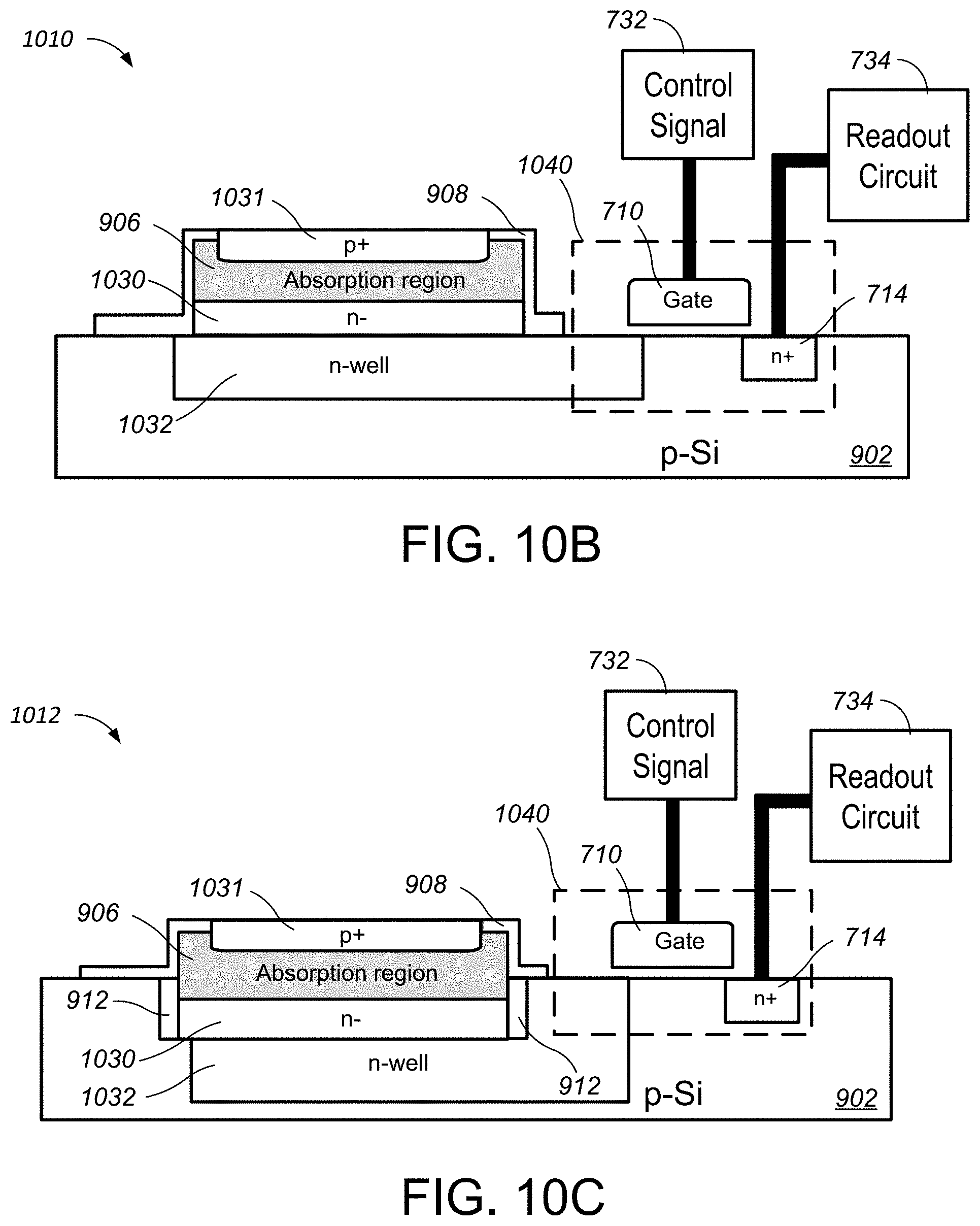
D00013
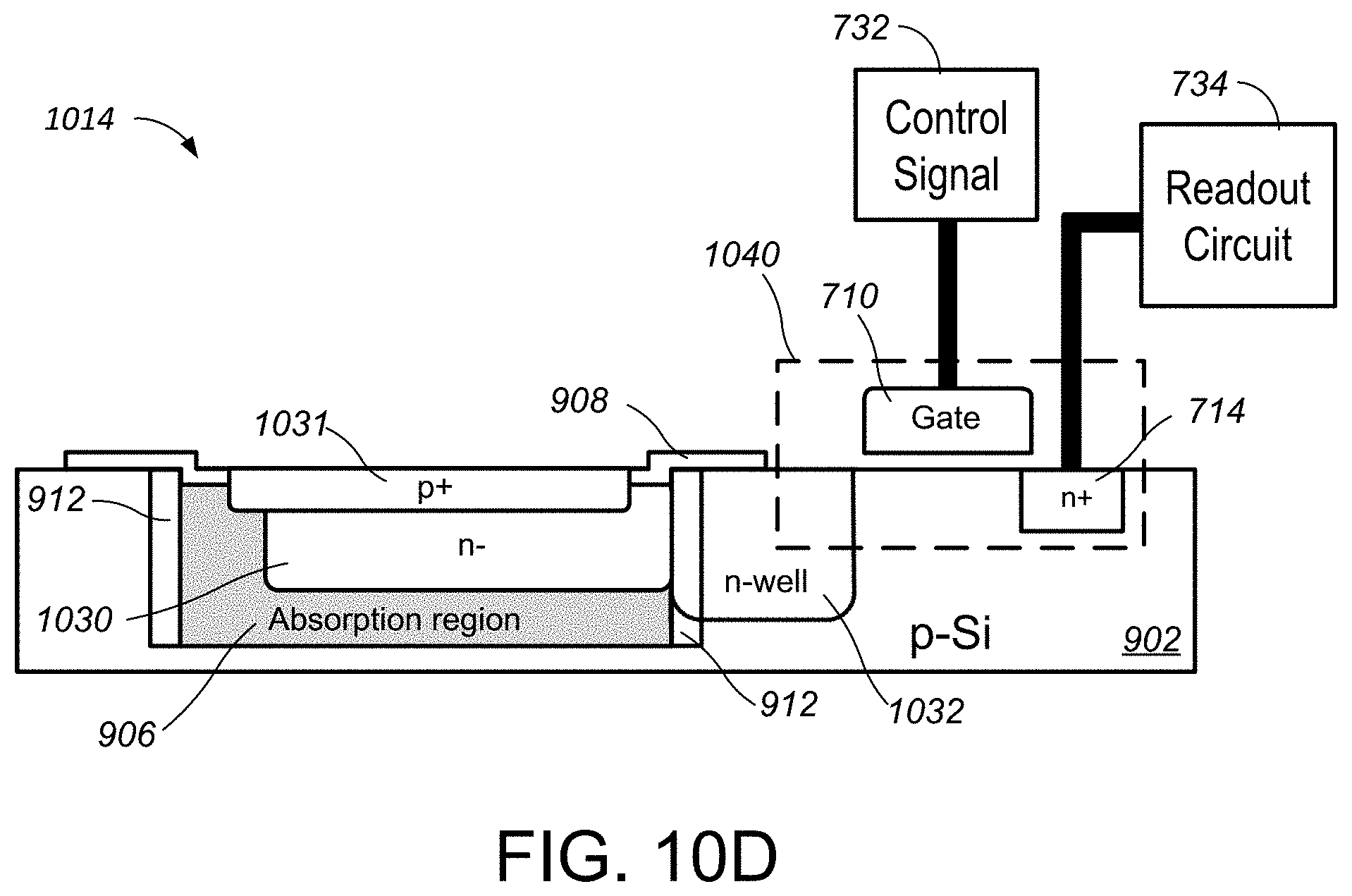
D00014
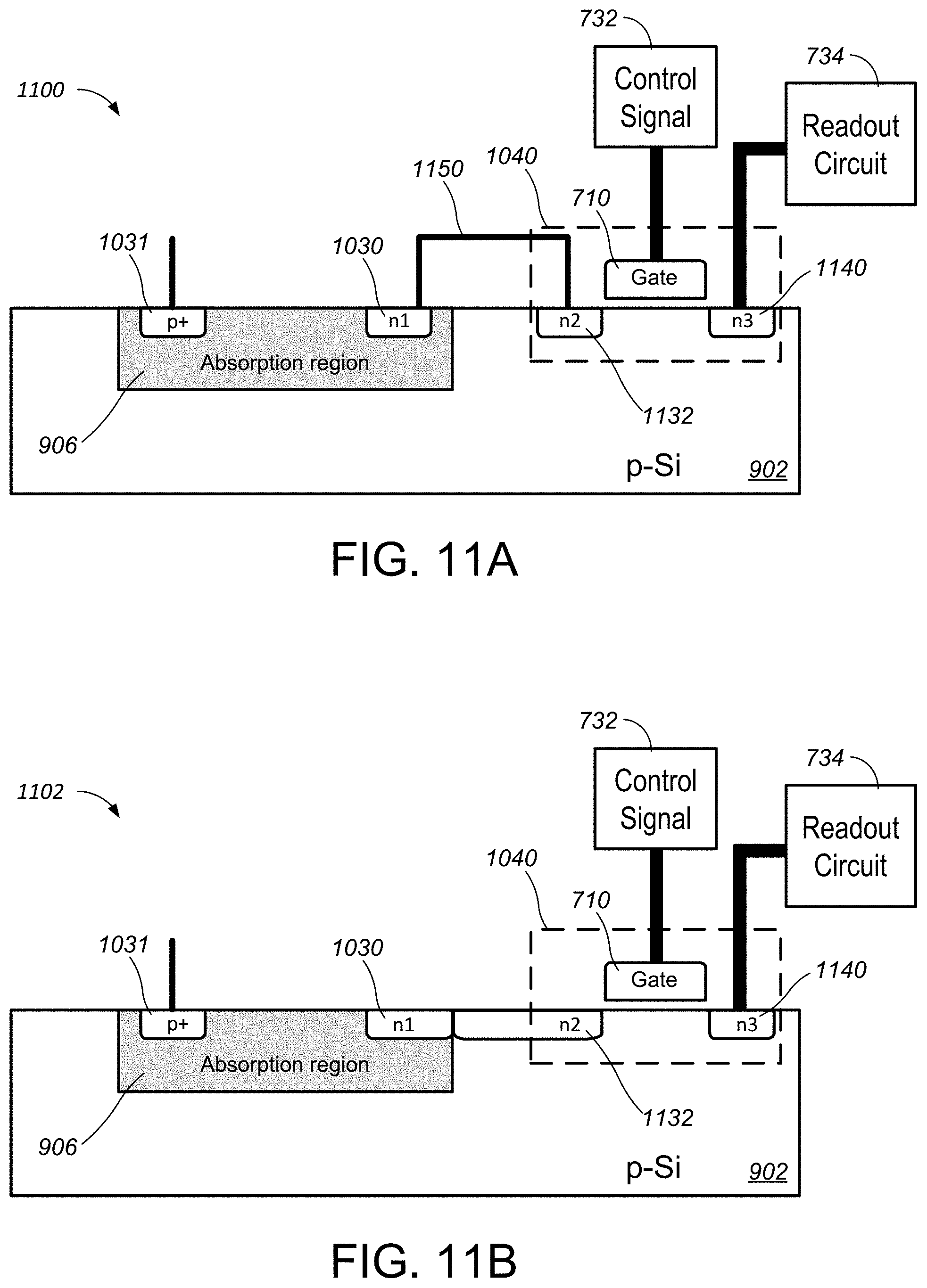
D00015
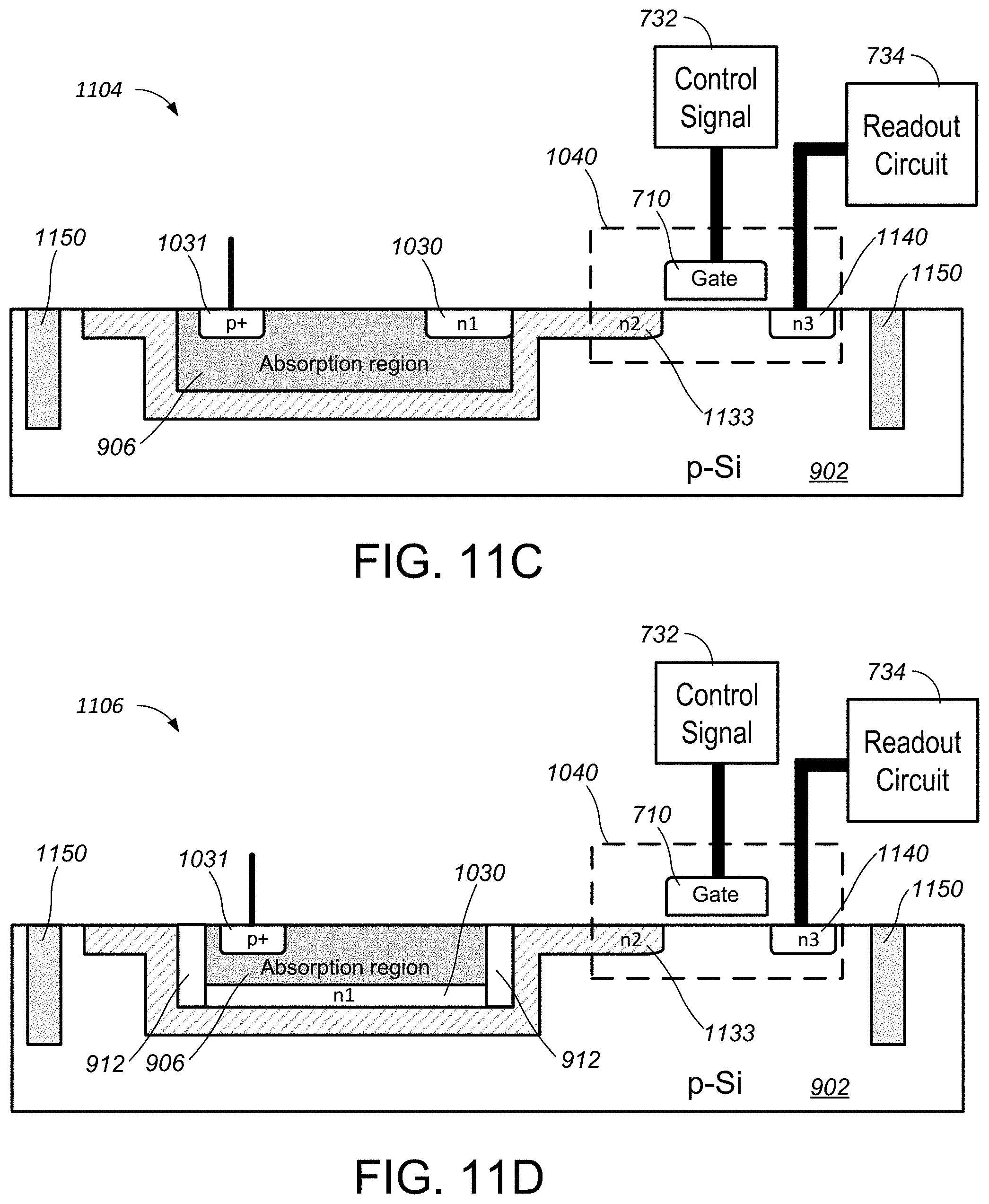
D00016
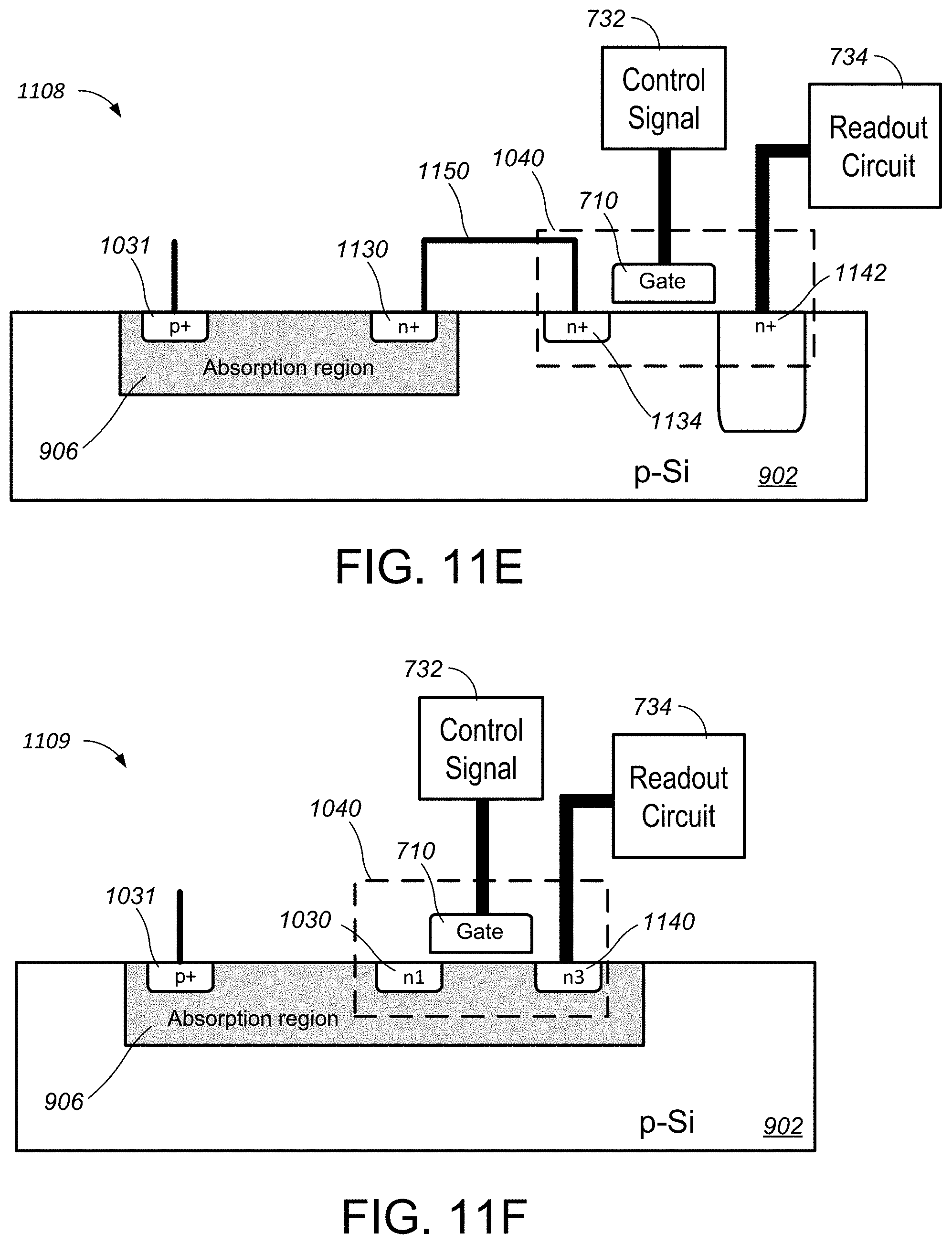
D00017
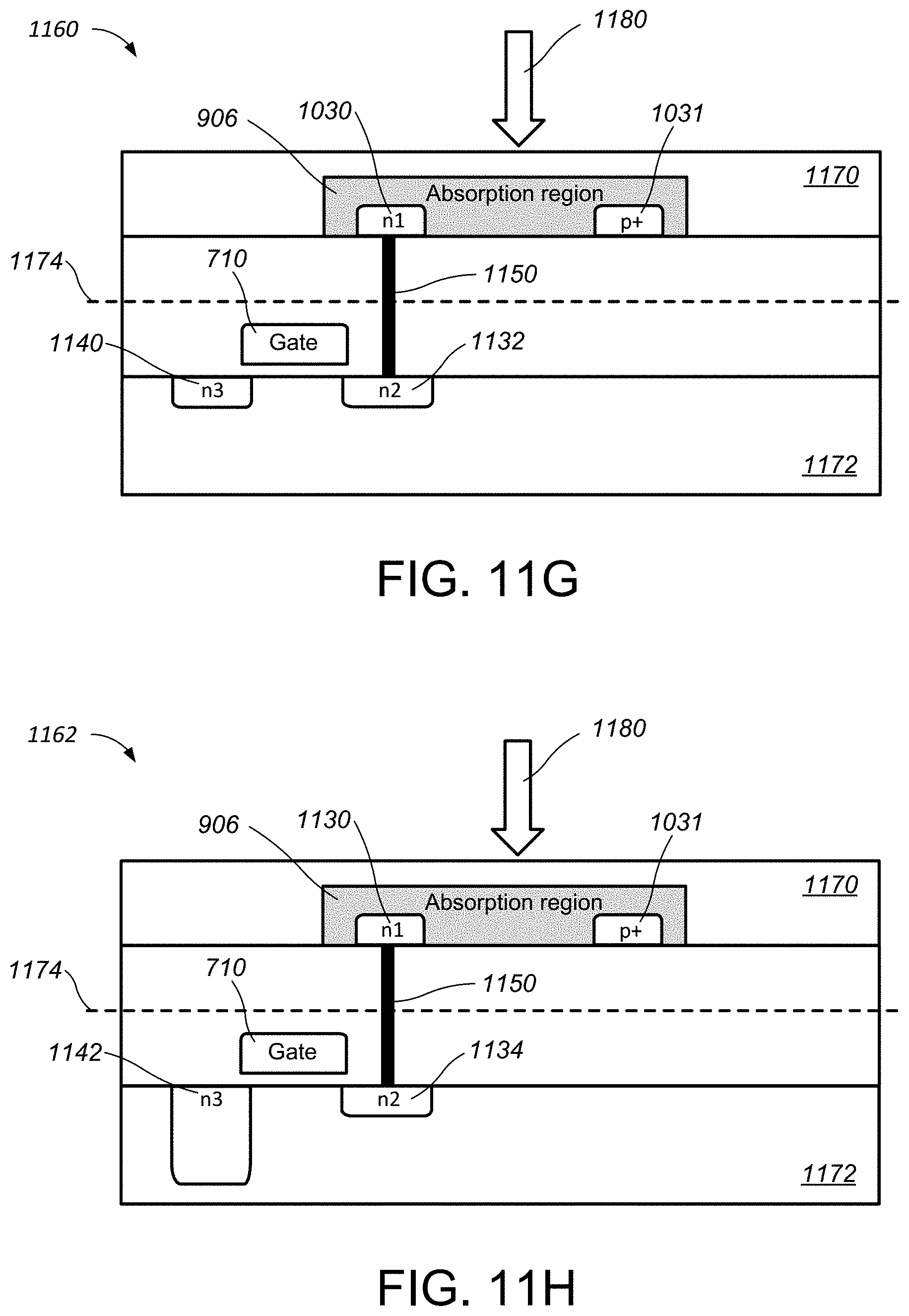
D00018
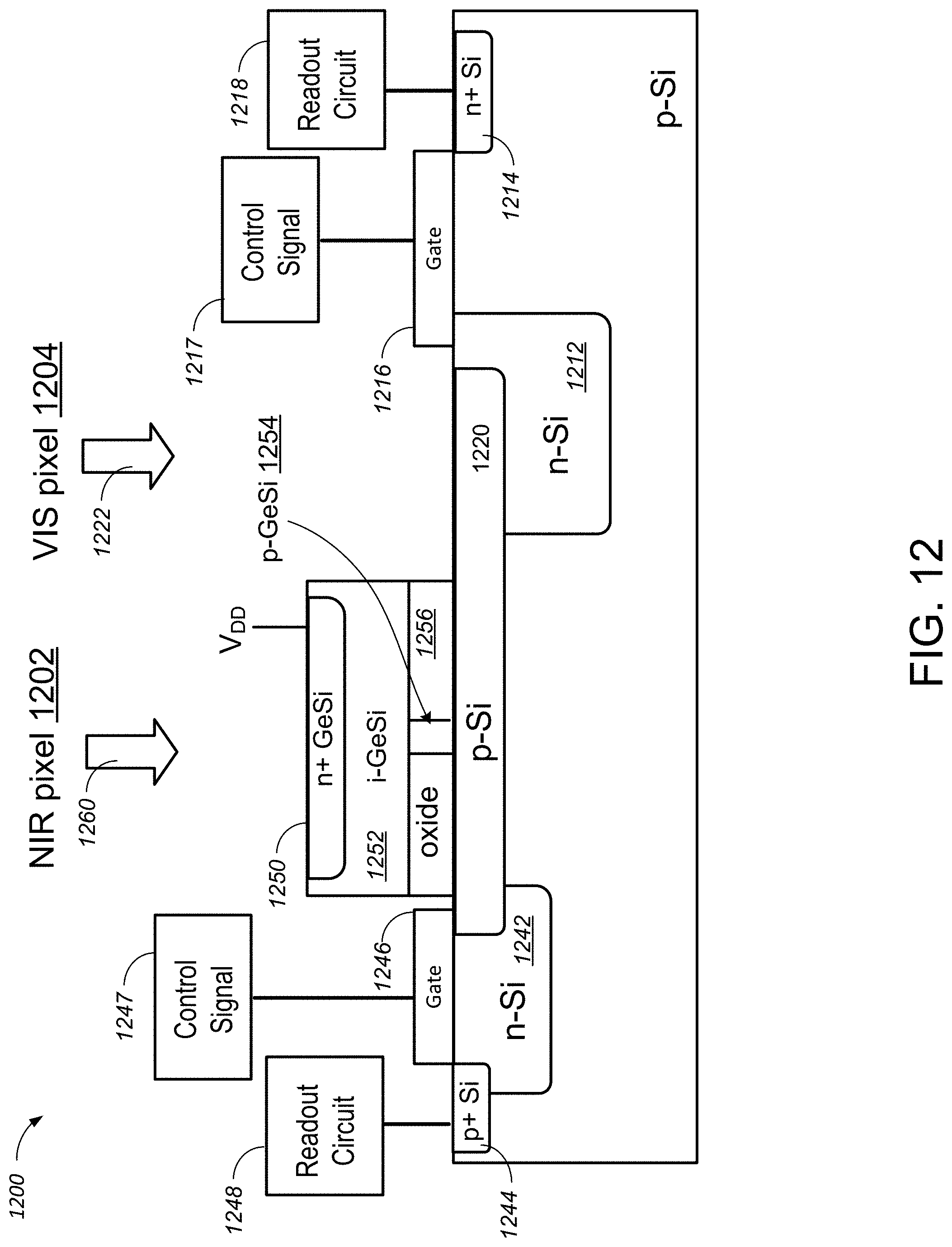
D00019
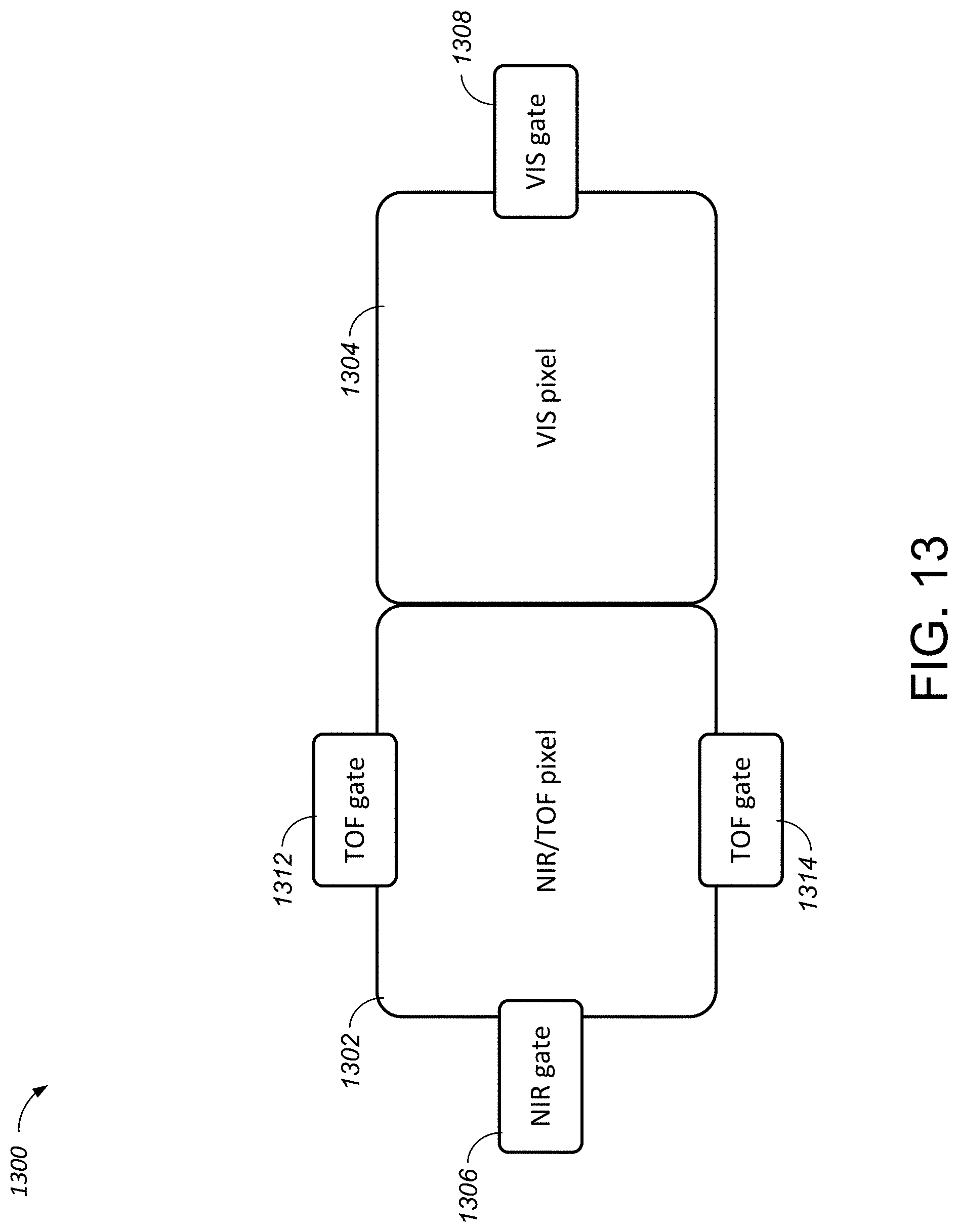
D00020
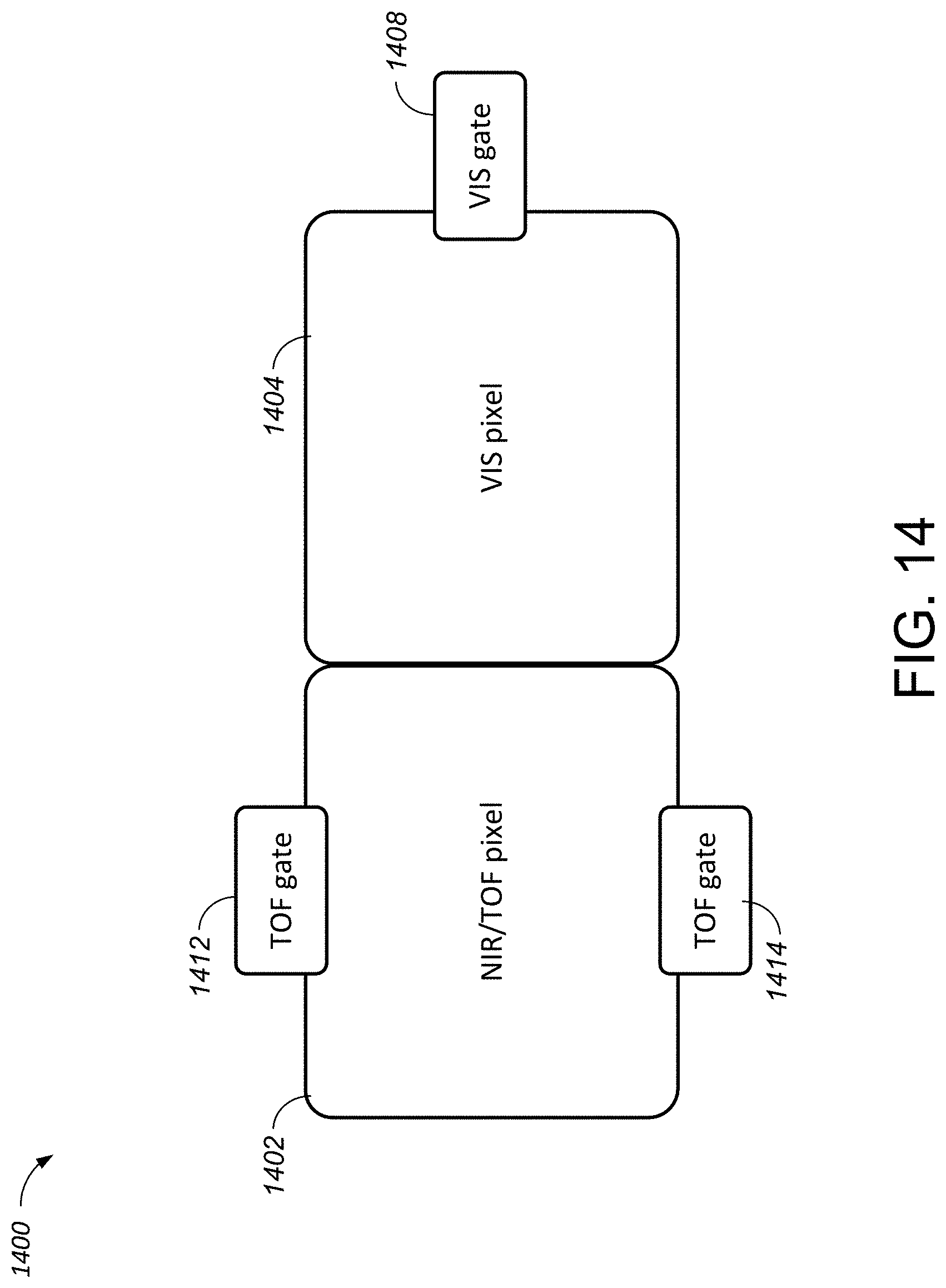
D00021
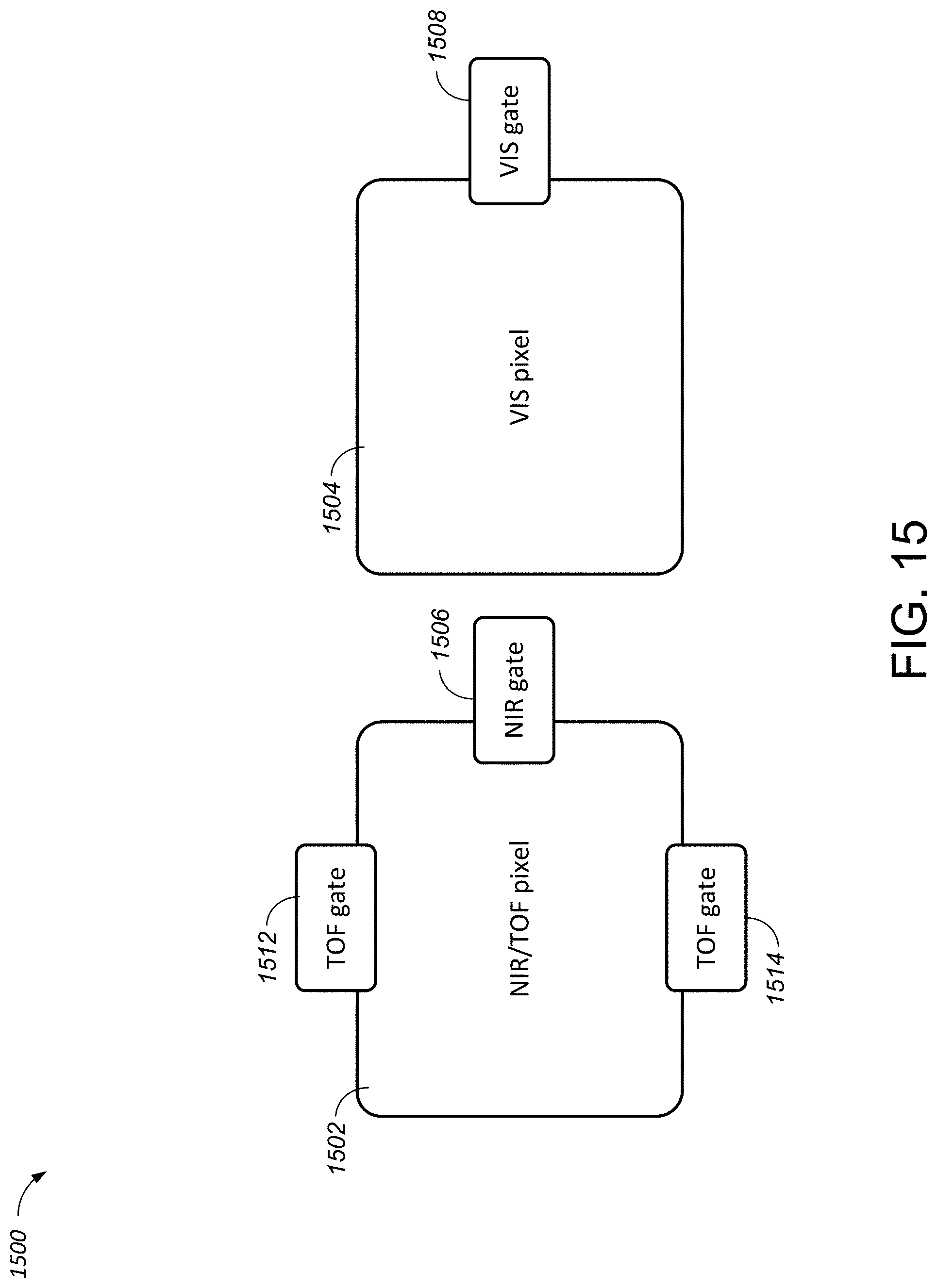
D00022
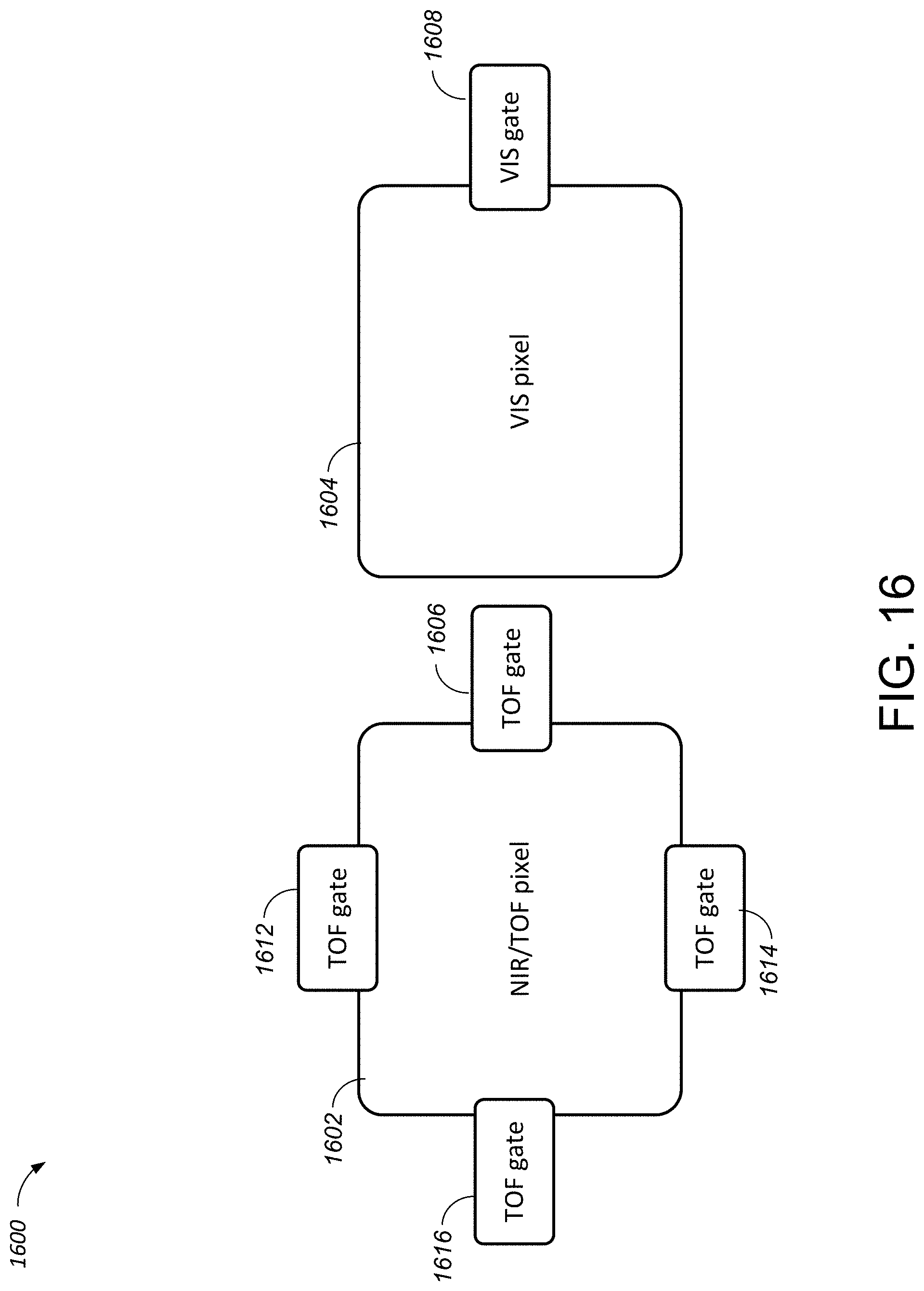
D00023
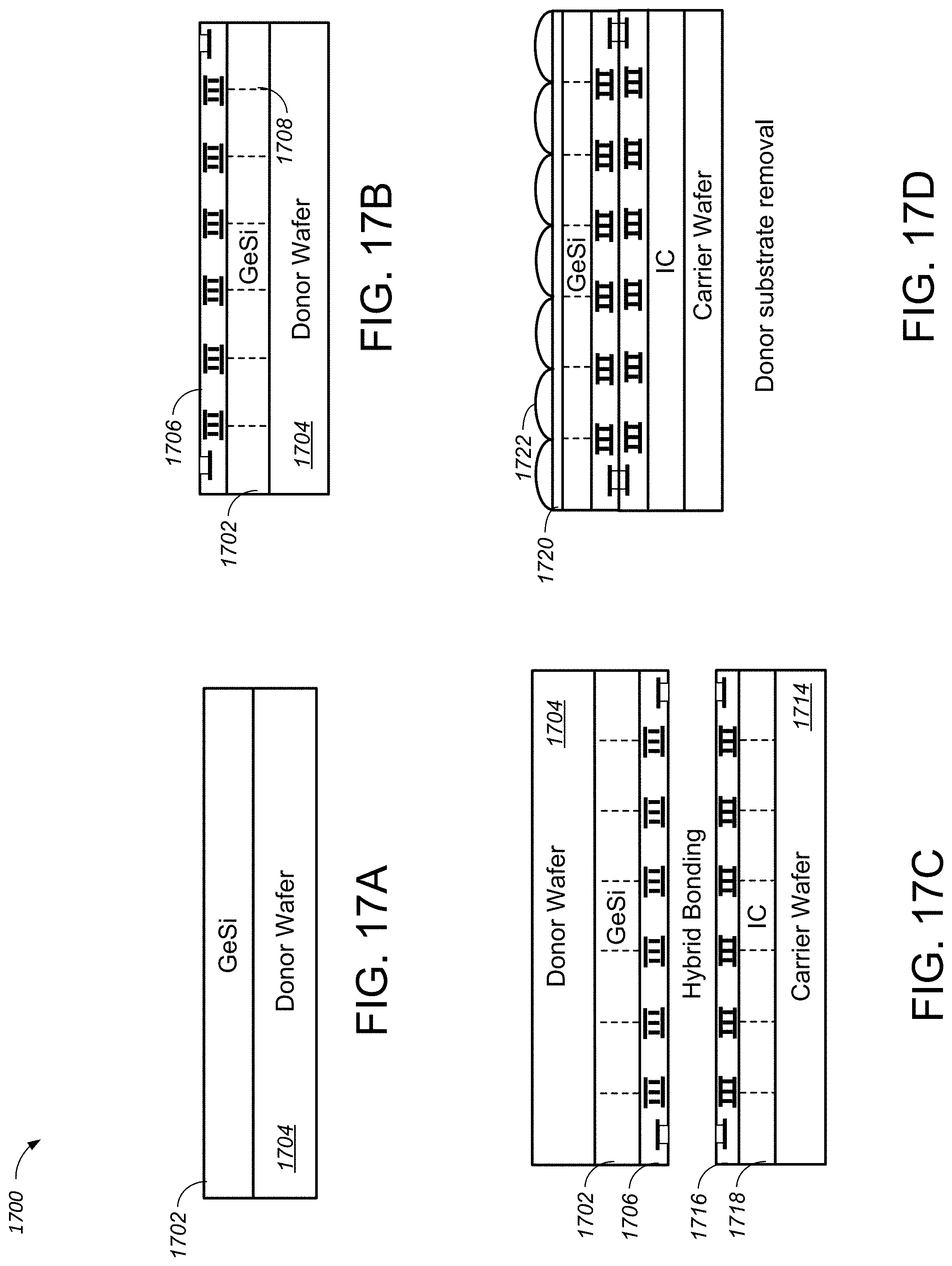
D00024

D00025
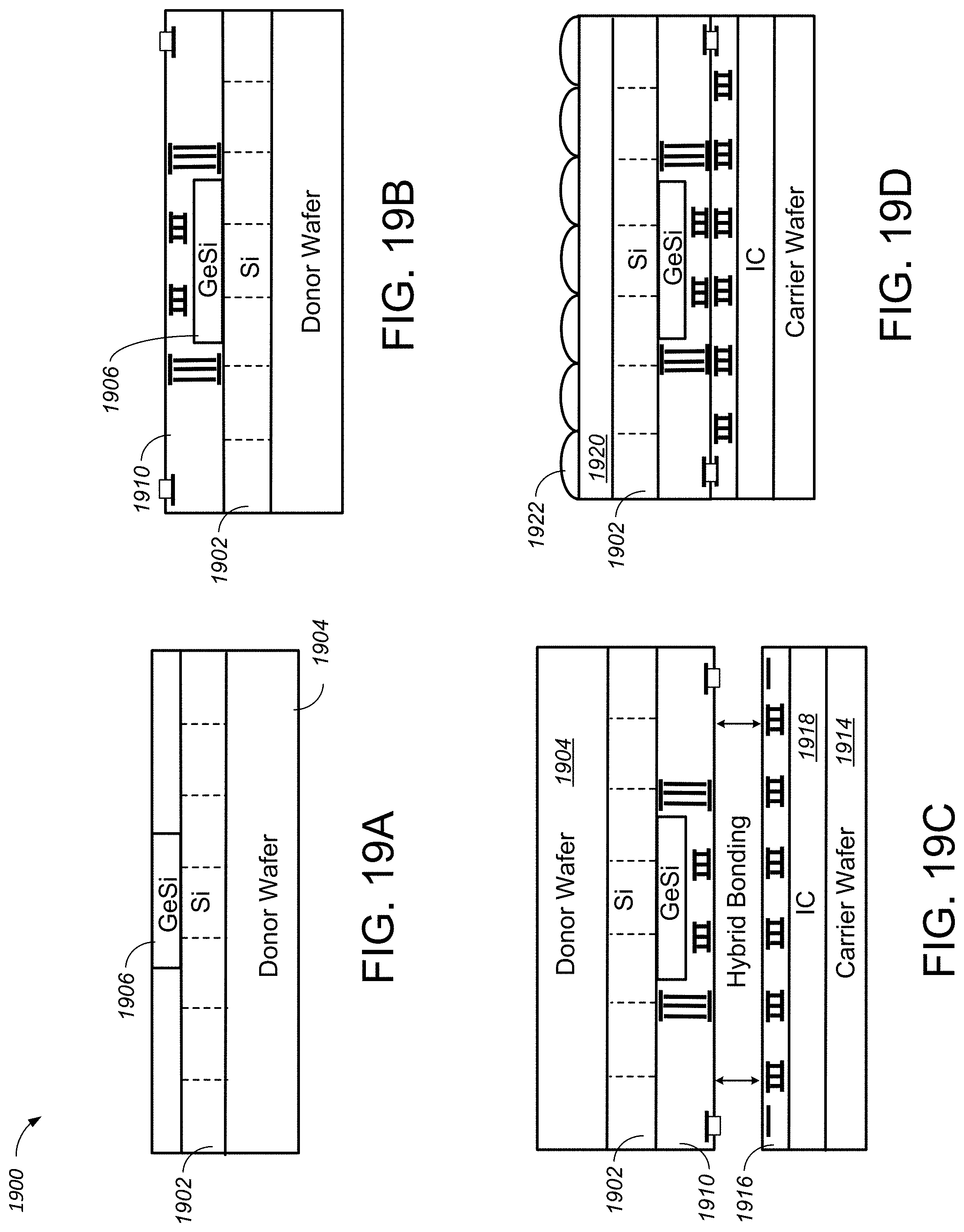
D00026
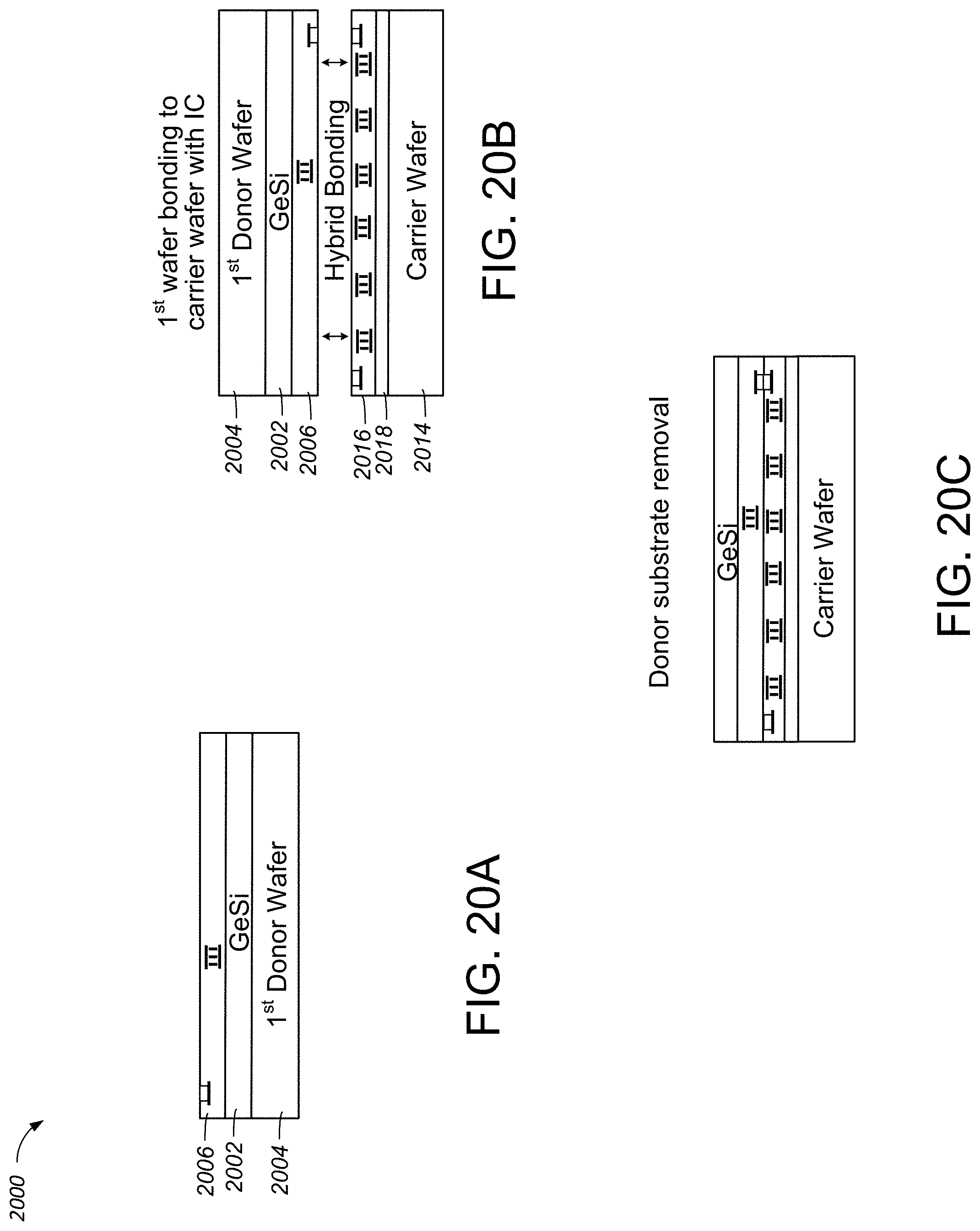
D00027
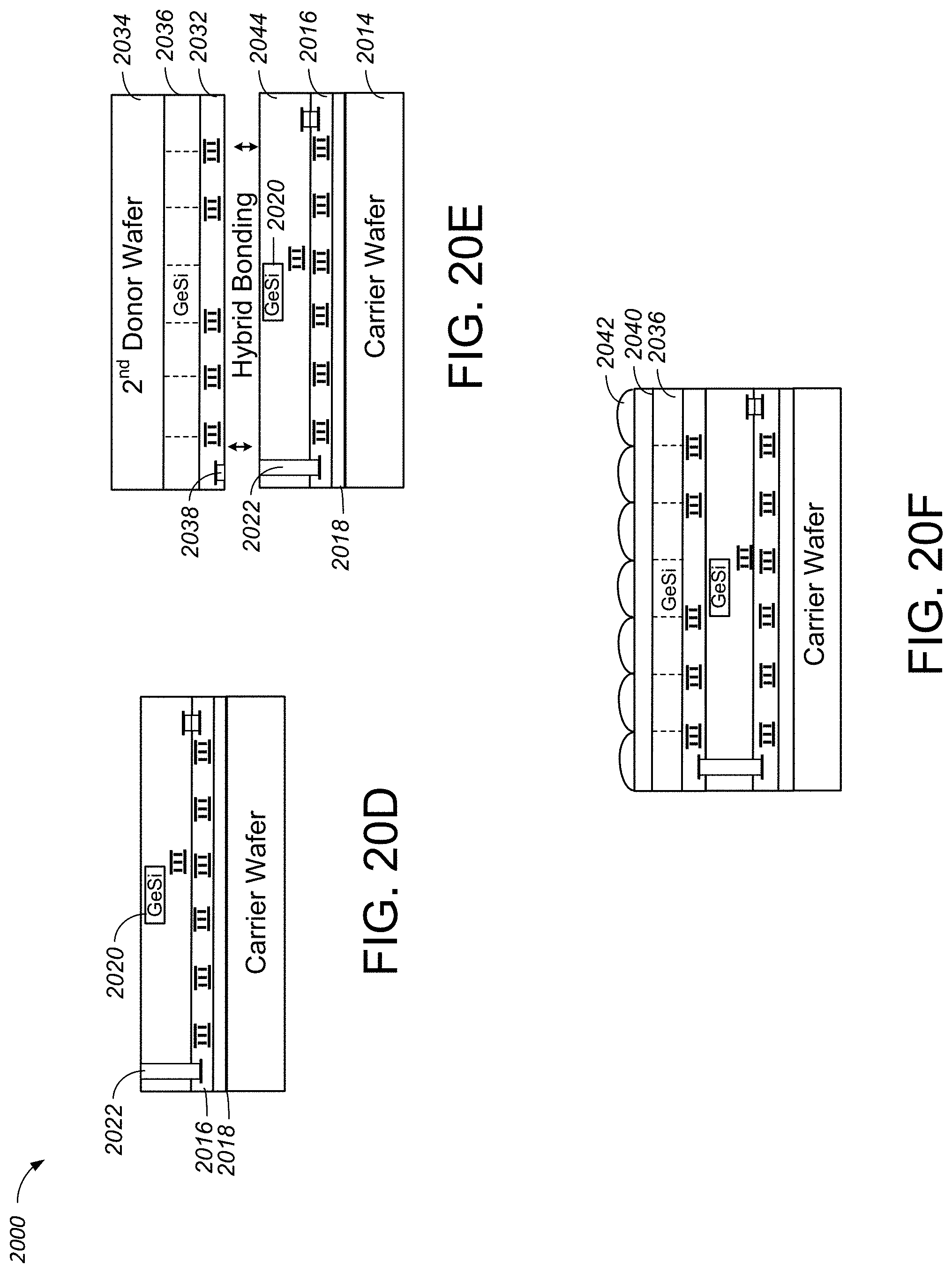
D00028
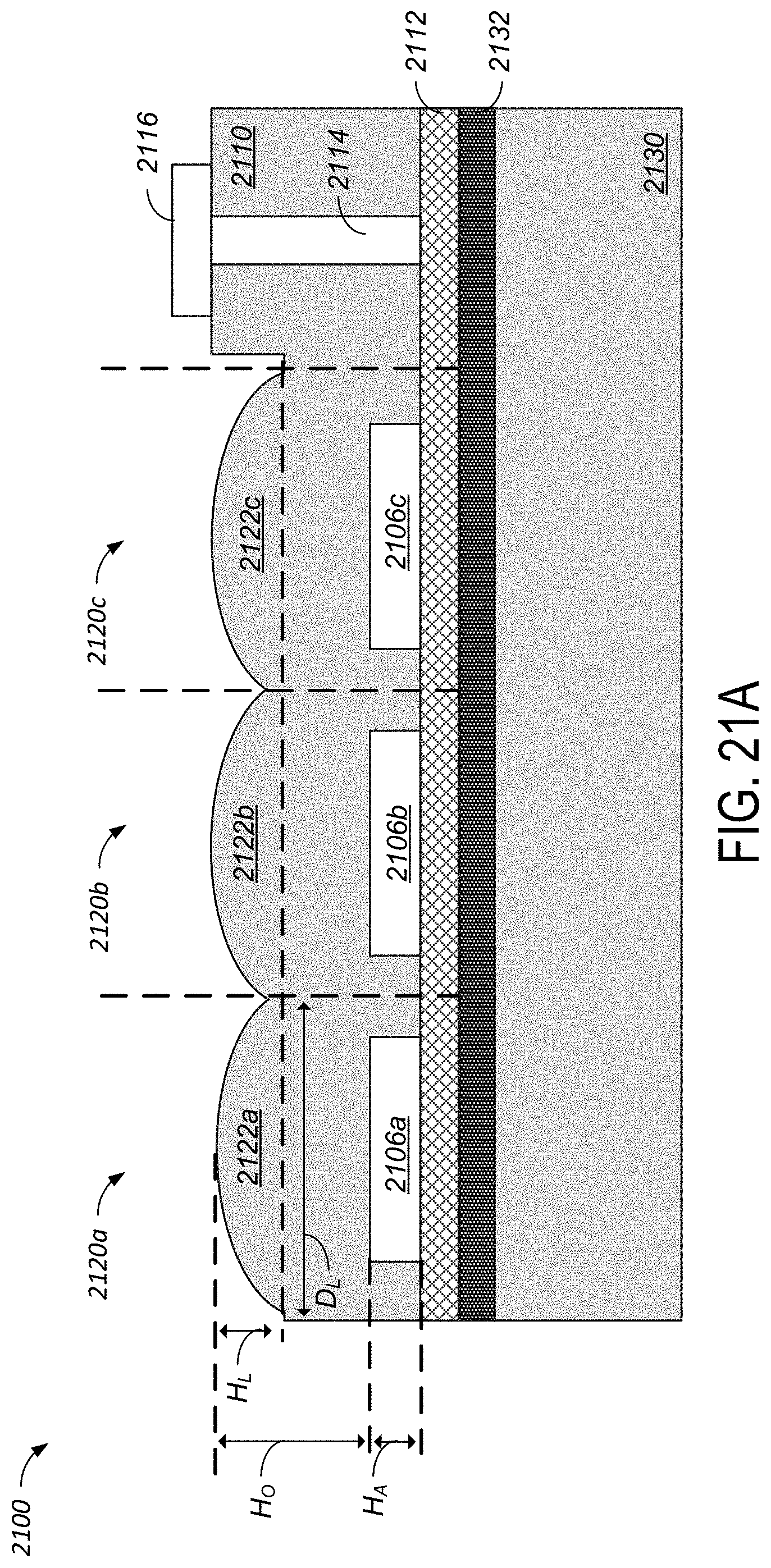
D00029
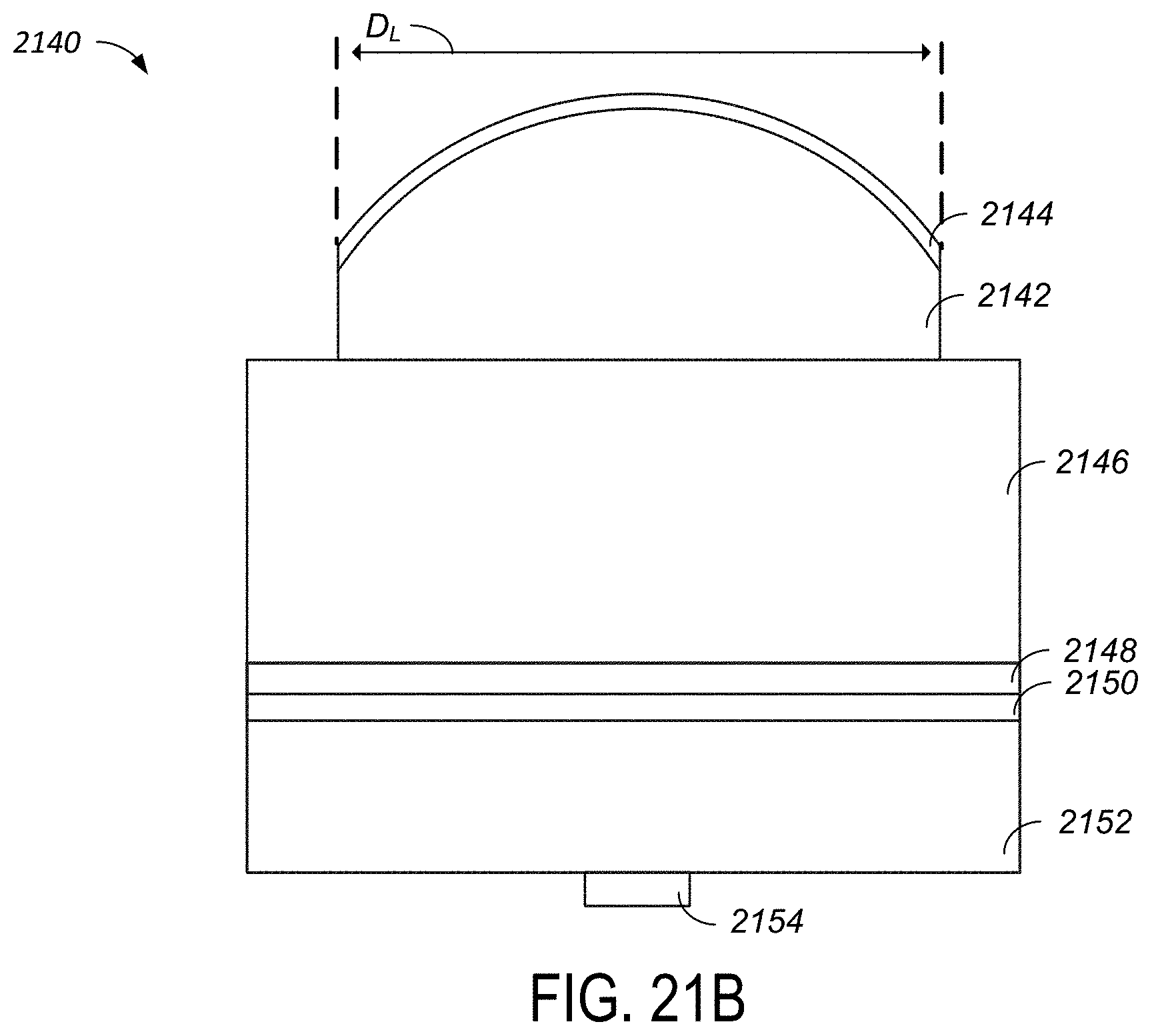
D00030
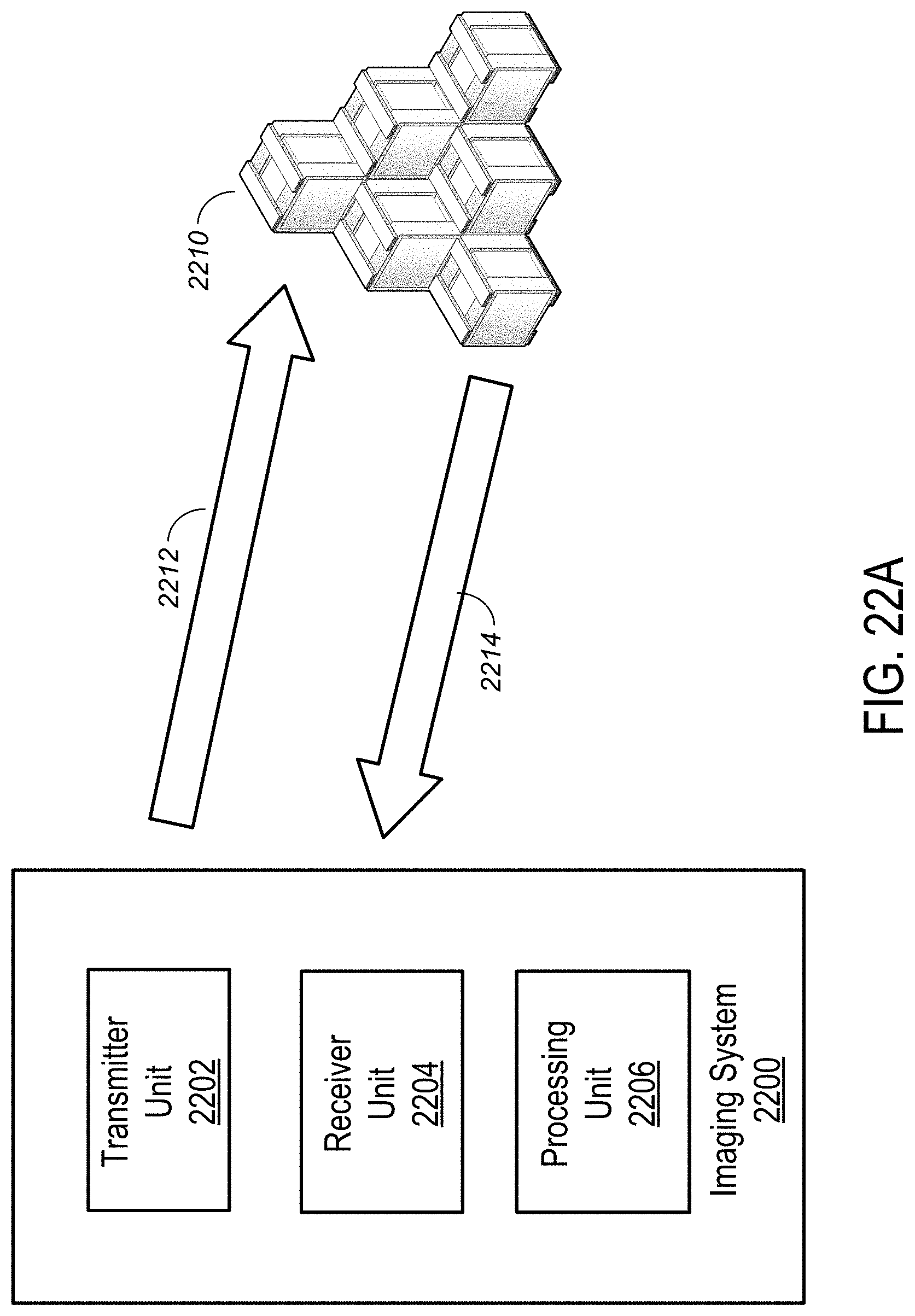
D00031
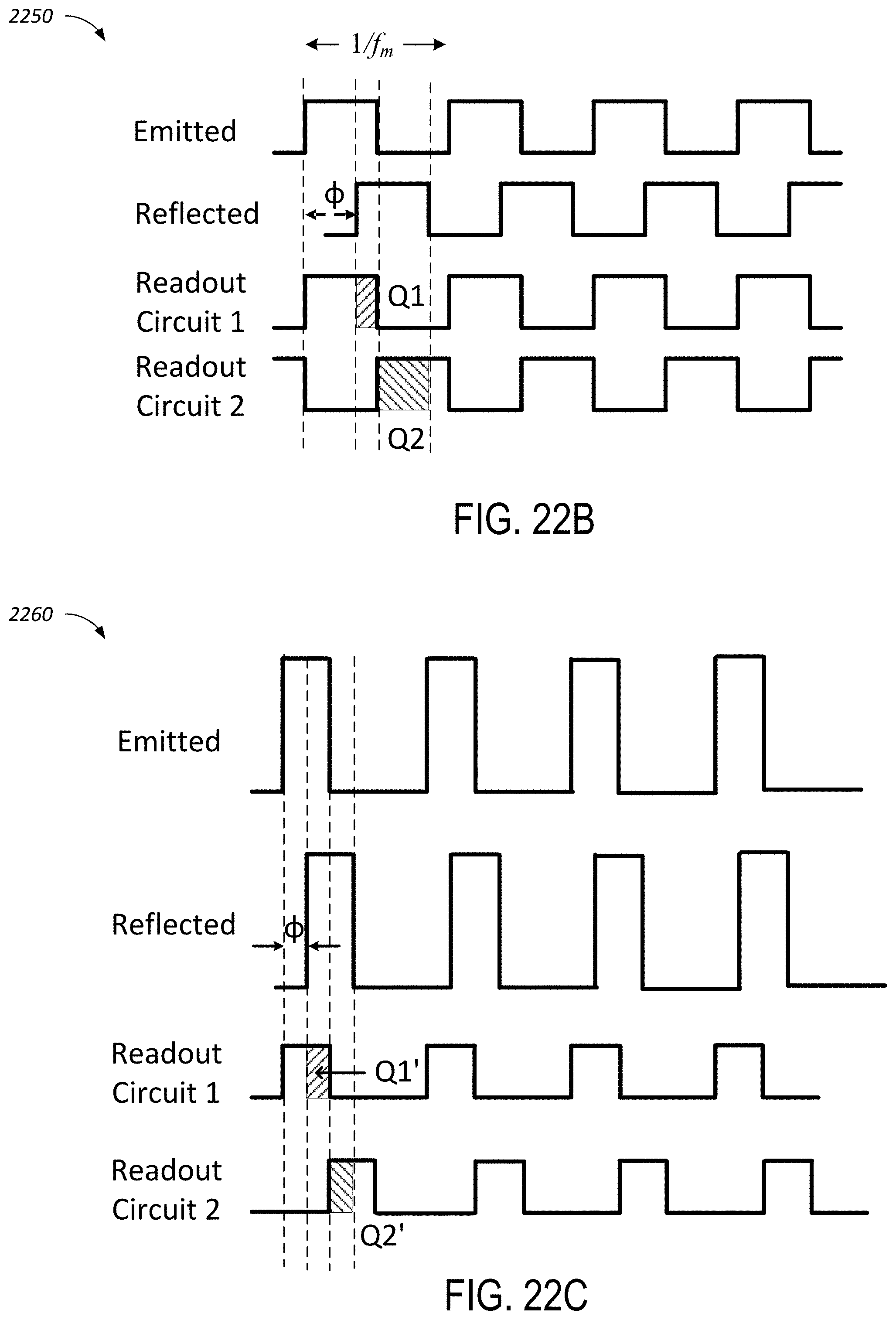
D00032
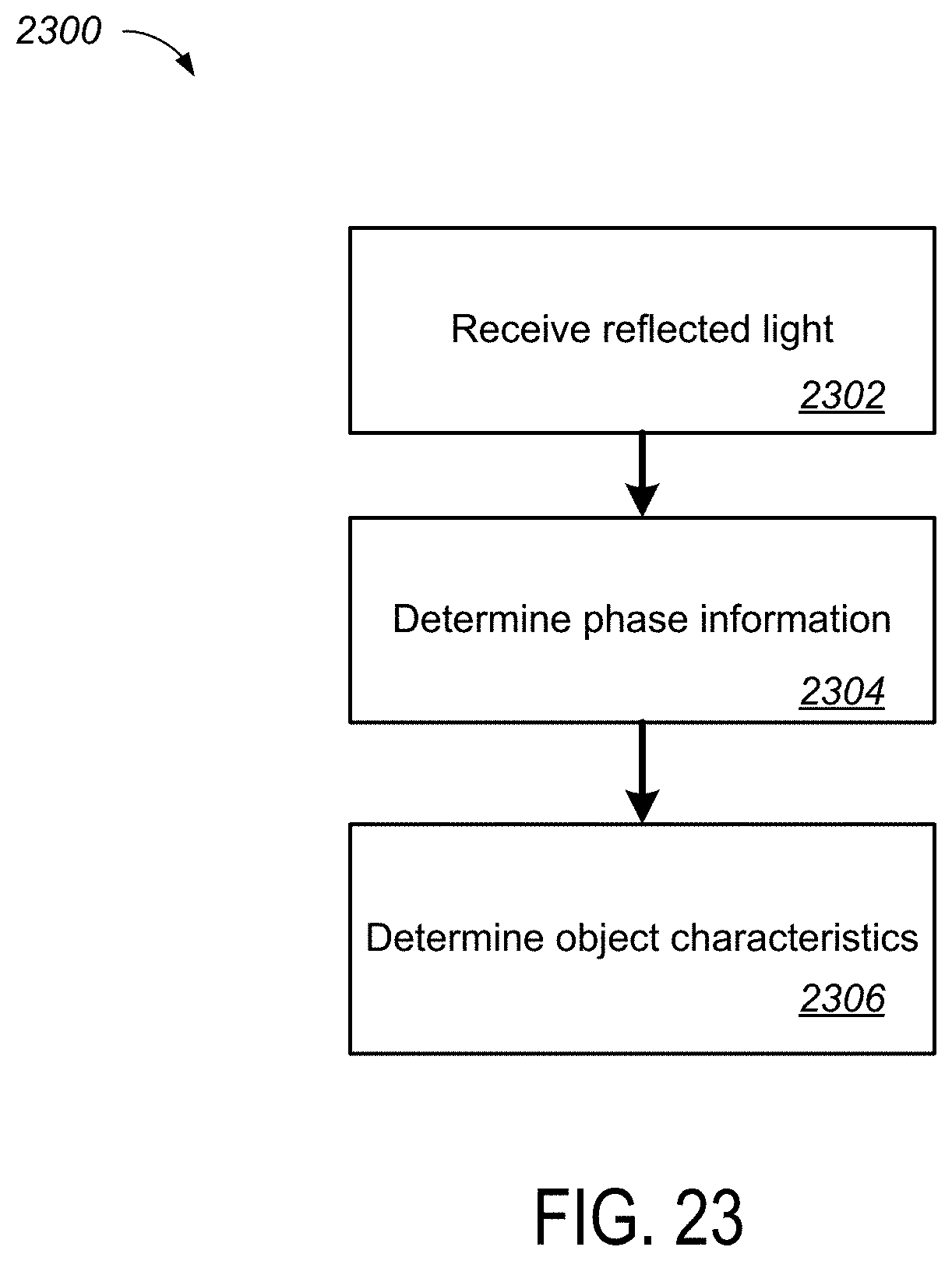
D00033
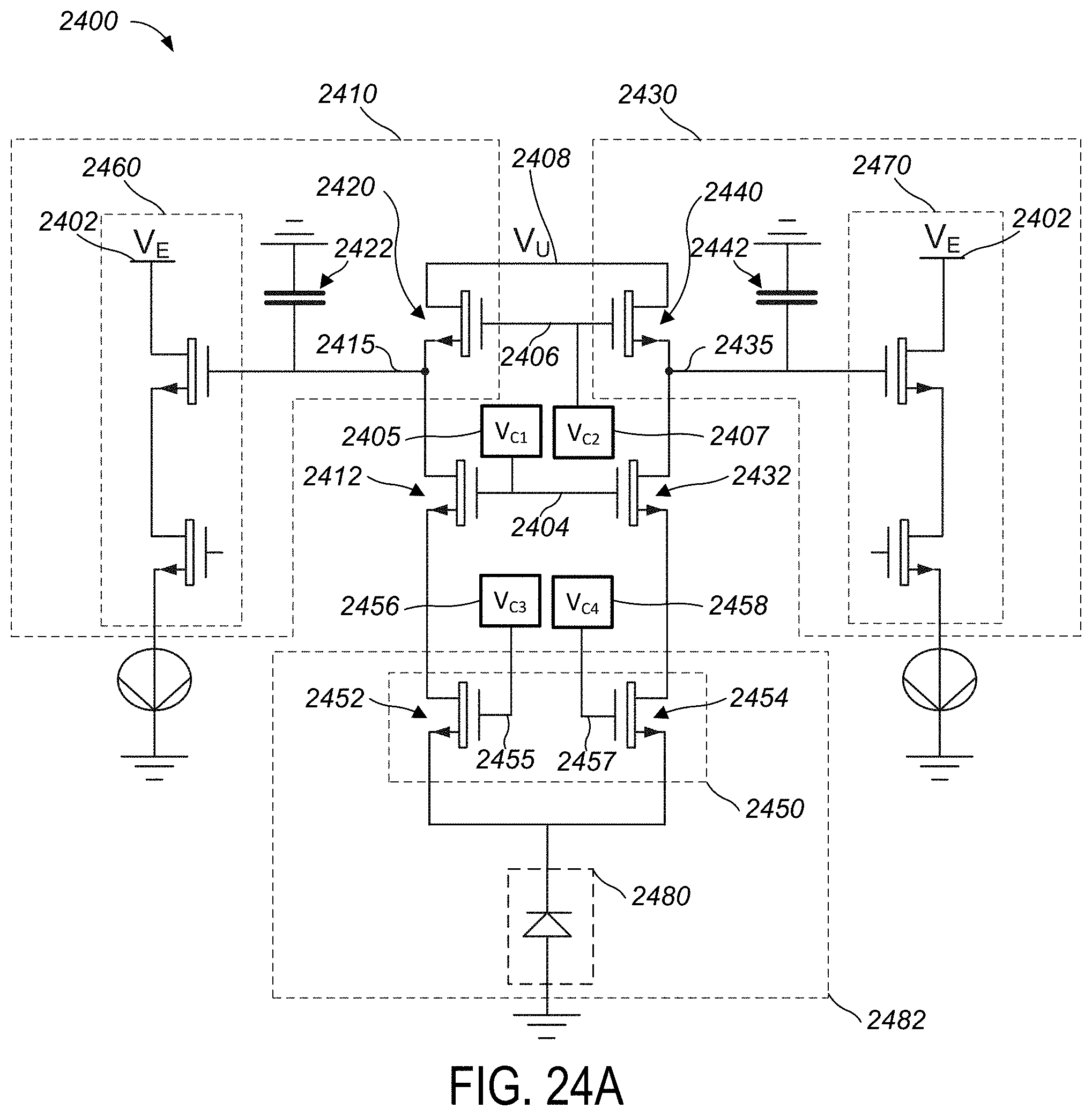
D00034
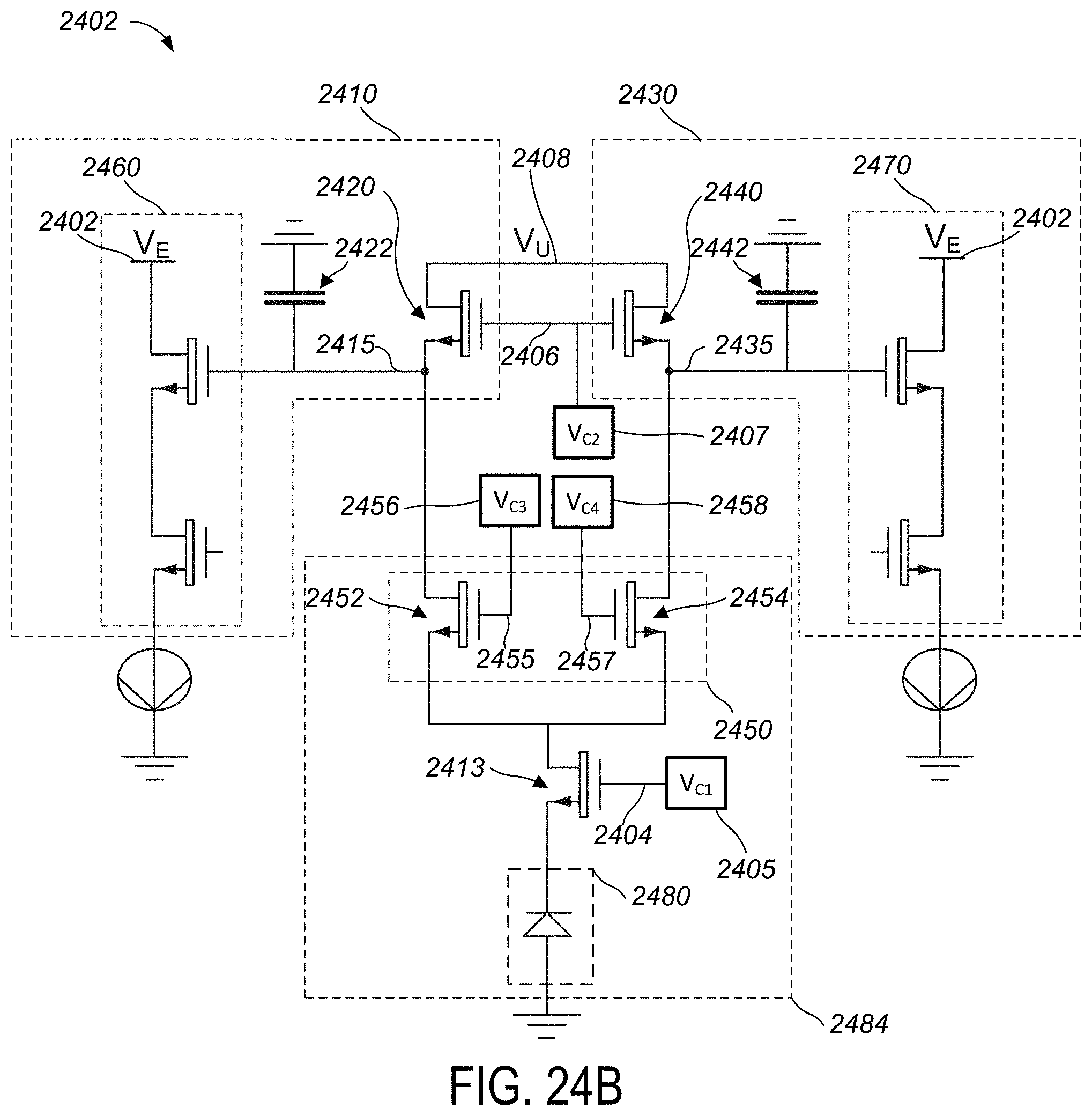
D00035
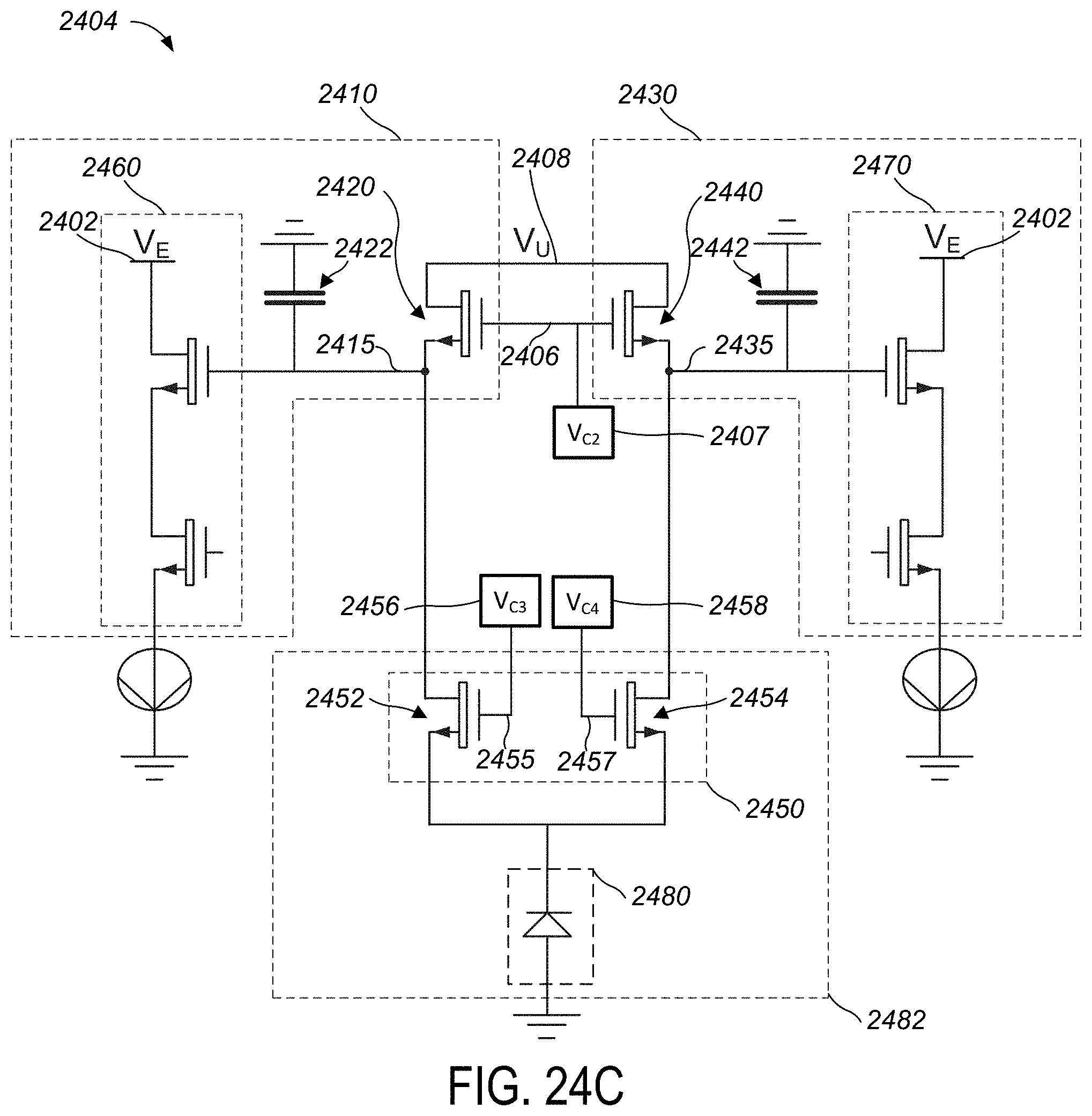
M00001

M00002

XML
uspto.report is an independent third-party trademark research tool that is not affiliated, endorsed, or sponsored by the United States Patent and Trademark Office (USPTO) or any other governmental organization. The information provided by uspto.report is based on publicly available data at the time of writing and is intended for informational purposes only.
While we strive to provide accurate and up-to-date information, we do not guarantee the accuracy, completeness, reliability, or suitability of the information displayed on this site. The use of this site is at your own risk. Any reliance you place on such information is therefore strictly at your own risk.
All official trademark data, including owner information, should be verified by visiting the official USPTO website at www.uspto.gov. This site is not intended to replace professional legal advice and should not be used as a substitute for consulting with a legal professional who is knowledgeable about trademark law.